EVERYTHING TO KNOW ABOUT COWBOY HATS (SERIOUSLY, EVERYTHING)
HIGH FASHION: Gucci Comes to Cowtown / BIG APPLE LIVING: Inside a Fort Worthian's New York Digs


EVERYTHING TO KNOW ABOUT COWBOY HATS (SERIOUSLY, EVERYTHING)
HIGH FASHION: Gucci Comes to Cowtown / BIG APPLE LIVING: Inside a Fort Worthian's New York Digs


Our heart care can help keep it beating strong.
Experience more of what you love by making your heart health a priority with heart and vascular care from Texas Health — the health system that more North Texans choose for heart care. From general heart health and wellness to advanced diagnostics, minimally invasive therapies and innovative procedures, our comprehensive heart and vascular services enable us to tailor care just for you.
Texas Health is right there with you.
Find a heart and vascular specialist or take our heart health assessment today at TexasHealth.org/Heart.

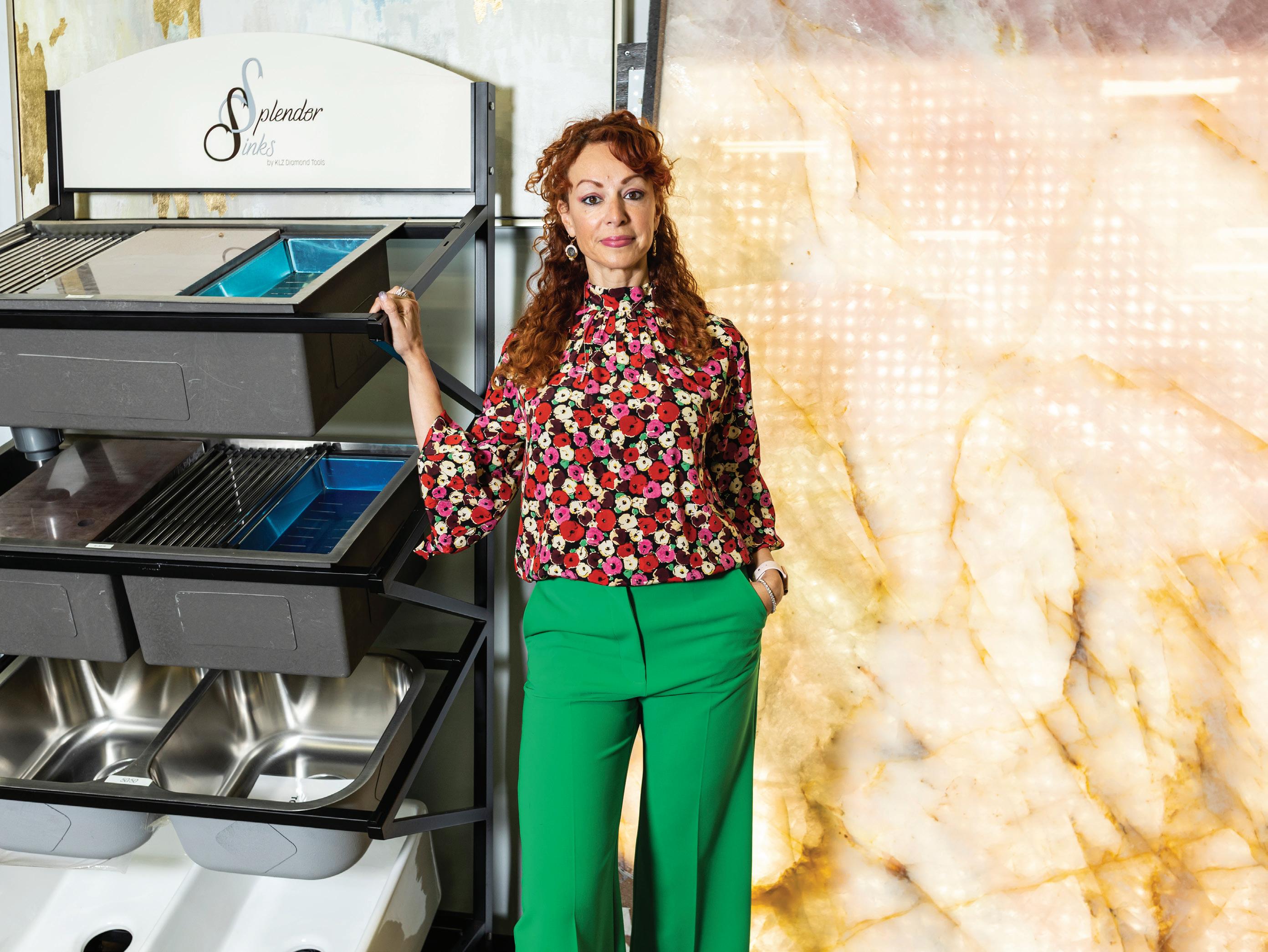
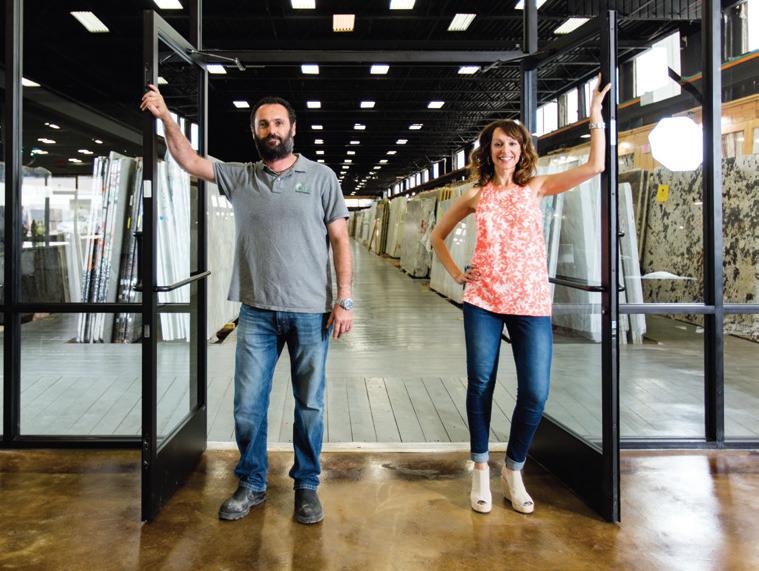
Pro Serve Plumbing – The only choice for residential and commercial new construction plumbing.

Pro Serve Plumbing provides residential and commercial new construction plumbing for volume production single family residences, multi-family accommodations, and build to rent properties. We have a strong focus on industrial structures, accommodations, sports facilities, retail stores and restaurants. Partner with us today! 817.244.0614 www.ProServePlumbers.com

Corner of the Garage to Corner Office
You’ve always been fascinated by how things work – whether taking things apart or researching the finer points of a business plan. Likewise, our passion is connecting people to their dreams by learning what truly makes them tick. Every great relationship has an Origin story. Start yours today at Origin.Bank/YourStory
VOLUME 25

57
Tall Hat, Deep Roots
A Lewis-and-Clark exploration of the celebrated headpiece of the American West, better known as the cowboy hat. Stitching together the myths and legends and the customs and traditions that make up a lifestyle.
BY SHILO URBAN, JOHN HENRY, BRIAN KENDALL
72
Gone Green
After a quarter-century as one of Texas country’s biggest stars, Pat Green is still in love with his art. “I love that people sing along to my songs. I love that I have had a lifelong career, and I love that I love music.”
BY BRIAN KENDALL
82
Medical Guide
A guide to hospitals, diagnostics, cancer, and rehabilitation centers.
12 Buzz
Dr. Angelica Ramsey takes the reins of the Fort Worth ISD with priorities that include, at the very top of the list, student achievement. Period.
18 Calendar
From watching the Horned Frogs face off against the detested Sooners to catching Foreigner at the recently christened Tannahill’s Tavern and Music Hall, Fort Worthians have plenty to do in October.
20 Fort Worthian
Trey Chapman transformed his 40 years of experience in the local restaurant industry into one of the city’s most popular food blogs.
24 Environment
The world’s only true bat sanctuary — in Mineral Wells — is a testament to the life and legacy of “Sunshine” and Amanda Lollar’s dedication to the far-toomisunderstood creatures.
Kam Phillips-Sadler tells us her secret to finding new books: TikTok. A Q&A with the Fort Worth native and KidKare CEO, plus, her book recommendations.
32 Art
Take Six with Alli Rogers, who works in education at the Amon Carter and spends her free time creating truly immersive installation pieces that connect community and art.
36 Style
Gucci has landed in Cowtown, carving out space in Clearfork. Twenty-eight facts every fashionista should know about the fabulous Florentine luxury brand.
38 Home
Sterling McDavid set aside a career in finance to achieve her passion as an interior architect in New York City, with aesthetic inspiration from her native Fort Worth, of course.


48 Restaurant News
Little Lilly Sushi, the quaint spot off Camp Bowie that offers some of the city’s best rolls, reopens after a fire put the future of the restaurant in jeopardy.
104 Young professionals from across Fort Worth and Dallas assembled for the Fort Worth Chamber’s YP Summit for conversations on professional and personal development and community involvement.
120 At the intersection of Fabons and Rosedale streets in east Fort Worth stands an image of a time gone by, the Grand Theater, a place where Black families could gather and watch movies during the era of segregation.

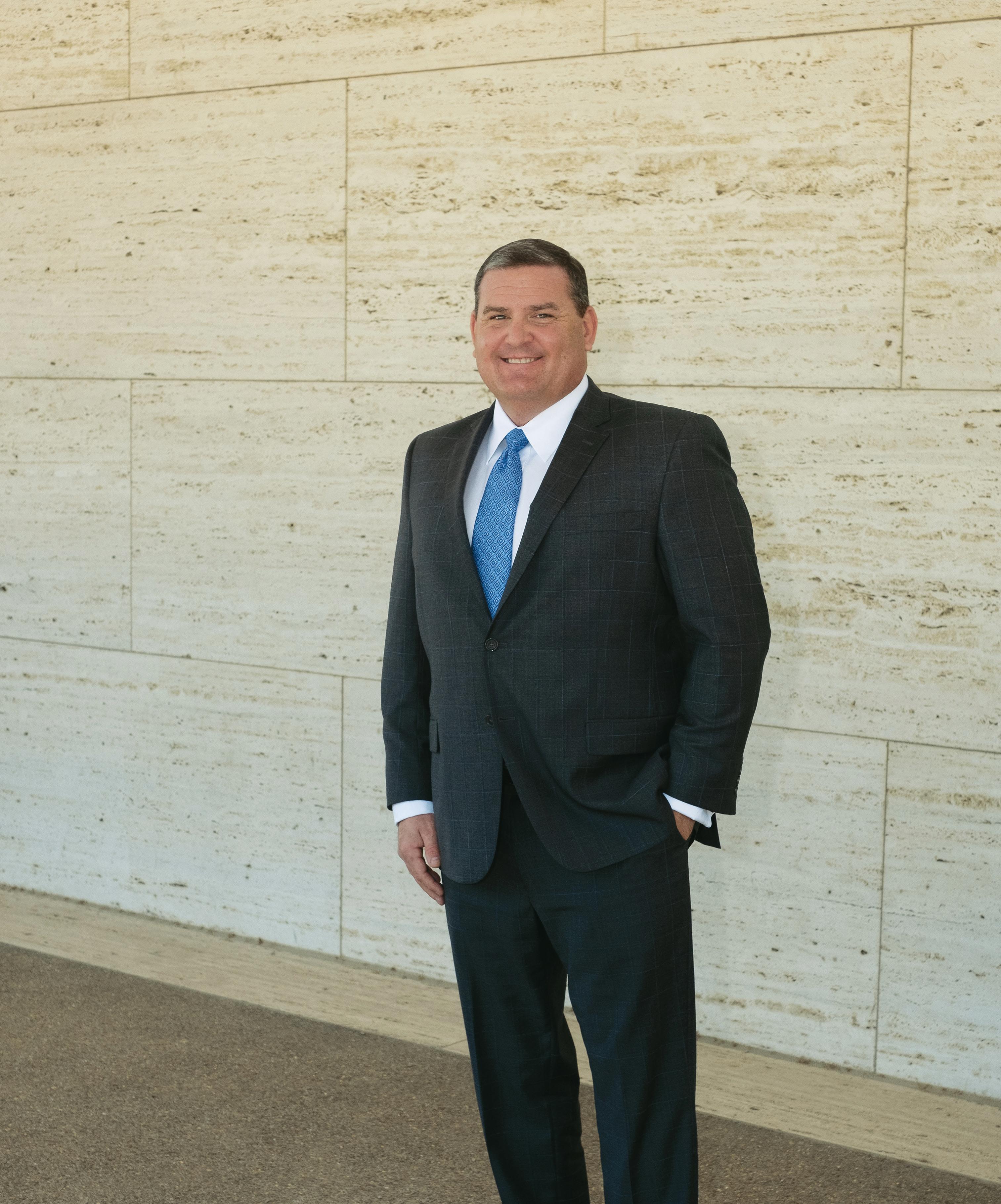
I’m an understudy. When a writer, for whatever reason (medical, personal, scheduling, or otherwise) suddenly can’t do an article, I have to step in on short notice and do it myself. It’s a common responsibility for editors. Like an actor on a Broadway musical suddenly going down with laryngitis on show night, I have to slide into the role ’cause I know all of the musical numbers and requisite dance steps. And, occasionally, that role is a juicy one. It’s the part actors pine to play. It’s the lead. Sometimes, that role is doing a cover story on Pat Green.
Yeah, I struck pay dirt after the writer to whom I had initially assigned the story had scheduling conflicts and bowed out. This was one of those occasions where I didn’t dare complain about the massive workload that was suddenly on my plate; I was about to interview Pat Green.
The two-plus-hour interview at the Amber Room went about as well as I could have hoped. I might have spent more time than necessary comparing our backgrounds (He was born April 5; I was born April 4. He was born in San Antonio; I’m from San Antonio. His first guitar was a Yamaha; my first guitar was a Yamaha, etc.), but when we got to the meatier subjects, Green was loquacious and open and honest. He didn’t evade any questions and was throwing proverbial fastballs with all of his answers.
“The difference between baseball players and movie stars is the same as the difference between guitarists and pianists. Baseball players want to be movie stars. Movie stars want to be baseball players. Guitarists want to play the piano, and

Brian Kendall EXECUTIVE EDITOR
pianists want to play the guitar.” Gold. I was careful not to recycle too much of what has already been written about him, and I was convinced we were going to shed a different light on the country music icon.
When the interview ended, after I was no longer recording the conversation, Green slyly said that he’d basically just given the same interview a week prior for a podcast. I was devastated. Seeing my look of despair, Green laughed and gave me a friendly nudge on the shoulder as if to say, “Better luck next time.” Suddenly, I felt as though I was falling into the trope of most understudies — a passable if basic and ho-hum performance, nothing to write home about. My only salvation was that I didn’t have an editor to whom I had to report. But I had little doubt readers would hold my feet to the fire.
Two weeks later, I listened to the podcast Green referenced, and to my surprise, there was little overlap. Green was clearly joshing with me. While few pranks could give a writer, and an understudy no less, more anxiety, I will gladly take it all in stride. Touché, Mr. Green.
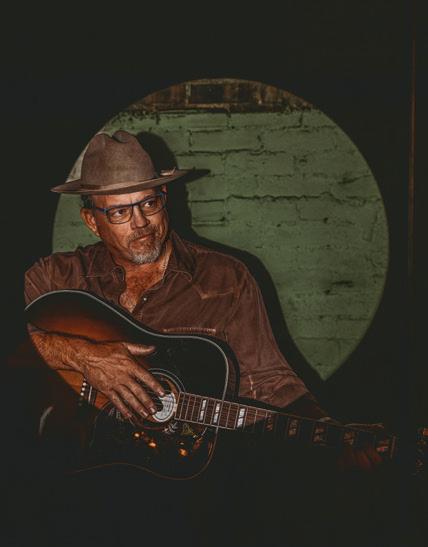
Corrections? Comments? Concerns? Send to executive editor Brian Kendall at bkendall@fwtexas. com.



Glad to see my great-great-greatgrandfather, Julian Feild, made the list. There were so many that have worked to make Fort Worh the wonderful city it is today. Thanks for the article.
Kimberly Payne
Left off Milton Brown, who started Texas Swing music and was the bandleader Pappy O’Daniel hired that became the Light Crust Doughboys. Helped give Bob Wills his start. Also left off the guy (William J. Marsh) who wrote the Texas state song, “Texas Our Texas.”
Robert Records
owner/publisher hal a. brown
president/director of sales mike waldum
EDITORIAL
executive editor brian kendall
contributing editor john henry
digital editor kelsey shoemaker
contributing writers hannah barricks, jenny davis, shasta haubrich, tina howard, malcolm mayhew, shilo urban copy editor sharon casseday
ART
creative director craig sylva
senior art director spray gleaves
advertising art director ed woolf director of photography crystal wise
ADVERTISING
advertising account supervisors
gina burns-wigginton x150, marion c. knight x135
account executive tammy denapoli x141
territory manager, fort worth inc. rita
MARKETING
director of digital robby kyser
marketing director sarah benkendorfer
content marketing specialist grace coan events & partnerships manager melissa mitchell
marketing intern madison baker
CORPORATE
chief financial officer charles newton founding publisher mark hulme
Female collaborators at their best!!
Sarina Lora Davidson
DIGITAL EDITION: The virtual editions of both current and previous issues are available on our website. Flip through the pages to read more about the great city of Fort Worth by visiting fwtx.com.





follow us for more @fwtxmag













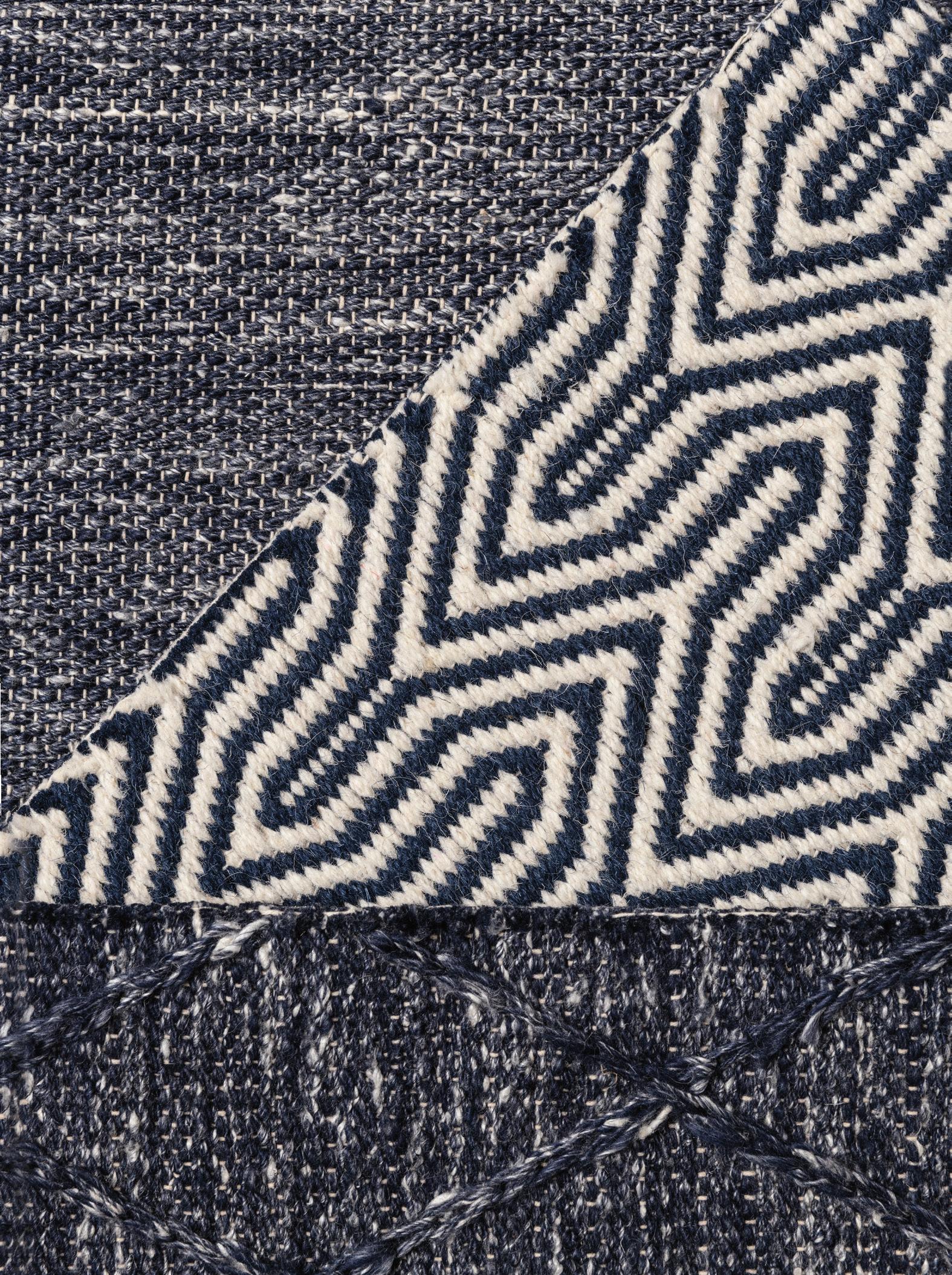



What’s the difference between Cajun and Georgia Coastal? This south Fort Worth restaurant has the answers. (page 52)

BY JOHN HENRY
In the early 1970s, Julius Truelson faced down antipathy from all sides on a busing plan to integrate Fort Worth public schools with a simple message: The city, as a community, must get on with its critical mission of educating students.
“We’re going to have, after the first blush of this wears off, an educational program that will be an improved educational program,” Truelson told the school board. “But we need the help, sincerely need the support of all of our people, whether they like [the integration plan or not]. Let’s do the best we can under these circumstances and have the best school system possible.”
Fifty years later, Dr. Angélica Ramsey steps into the role as a successor to Truelson as the new superintendent of the Fort Worth school district.
It’s a kiln of political volatility, mirroring the climate across the civic landscape that is too often anything but civil.
During a special board meeting on the last day of August, trustees voted unanimously to name Ramsey as the lone finalist for the position of superintendent of the
Fort Worth school district.
She was formally hired by the school board in September and began immediately the next day, Sept. 21. Ramsey replaces Kent Scribner, who was on the job for seven years. In January, Scribner announced he planned to retire. His last day on the job was Aug. 31.
For the past 1 1/2 years, Ramsey has been the top leader of the Midland school district. Before that, almost five years as superintendent of schools at the Pleasant Valley School District in Ventura County, California.
The cynic would surely point out that it’s difficult to know whether Ramsey’s hiring merits congratulations or pity, considering the political hot potatoes and headaches at play the past few years.
We’re going to go with congratulations and best wishes, Dr. Ramsey, on your new vocation in building young people in body, mind, and spirit, so as to create communities of workers for a hoped-for thriving corporate and business sector and servant leaders in neighborhoods.
It’s an understatement to say her appointment comes at a pivotal mark in the history of the city, today the 13th-largest city in the U.S. and grappling with ways to accommodate and pay for the growth.
Upon her formal hiring, she will oversee 146 schools serving 76,858 students.
“We are excited to name Dr. Angélica Ramsey as the lone finalist for superintendent of the Fort Worth ISD,” says Board President Tobi Jackson. “She will bring her many amazing leadership qualities to our district and to the benefit of our greater community.”
Ramsey’s arrival coincides with some seemingly good news for the district, which climbed to a B rating by the Texas Education Agency, up from a C in 2019. Results from STAAR testing demonstrated gain in reading and math.
Yet, a report by the nonprofit Fort Worth Education Partnership showed that two out of three students in third through eighth grades weren’t meeting grade level on state tests. Although scores were up compared to a year ago, the 36% who met grade level on reading, math, science, and social studies was still behind 2019, when students registered scores of 39%.
At the same time, the district is grappling with a loss in student population which comes with the coinciding challenge of a loss in revenue.
Fort Worth Mayor Mattie Parker asked the city to rally to the school district and superintendent’s mission even while players of all political persuasions lined up to criticize her hiring.
Ramsey describes herself as an inclusive and deliberative CEO who places students first and is resultsoriented. She says she makes it a point to be visible in classrooms and in the community.
She called the opportunity an exceptionally good fit, telling Fort Worth Magazine that “looking at the leader-

ship profile, it really seems like the school board and the community are ready to bring about positive academic gains and changes.”
On her list of first orders of business is a listening tour with teachers, community, and business leaders, seeking commonalities and consensus, in part to craft a strategic plan that identifies who the Fort Worth ISD is, what it does well, and where improvements are needed.
At Midland, she says she met with about 2,000 people after her hiring.
“Who are we as a school district,” Ramsey says. “What do we believe in, what are we committed to, and how do we work on that together. I see pockets of success, but I don’t see just a coherent strategy across the system.
“I don’t want a strategic plan that is mine. I want it to belong to the community.”
Ramsey was born in the East Bay town of Richmond, California. Visible just across the water is the skyline of San Francisco. Richmond, however, she says, was a “different world” from the city, blue collar neighborhoods and working poor.
Her father worked in a factory, her Mexican immigrant mother an agricultural worker and later housemaid and porter at a hotel. He had a seventhgrade education. Her mother made it through the second grade.
Education was a priority of the parents for their children. Today, Ramsey and her brother are credentialed. Combined, they have six college degrees.
“Even though they couldn’t help us with our school work,” Ramsey recalls of her parents, “they could always make sure we went to school clean, fed, and they always checked our homework.”
Her newcomer mother, who eventually earned her citizenship, was a strong “believer in the values this country holds. We are her American dream.”
After a brief stint in Los Angeles, the family settled in Stockton, California. Ramsey later joined the U.S. Army. After her service, she returned home to take care of her mother, who was dying of lung cancer. Her father had passed away when she was a freshman in college.
Ramsey has a bachelor’s degree from the University of the Pacific, a master’s degree from University of Texas at El Paso, and an educational specialist degree and a doctorate in education from Liberty University.
She began her career as a classroom teacher and eventually served as assistant principal and principal in the Socorro school district in El Paso.
From there, she moved to the Santa Clara County Office of Education in San Jose, where she served as the chief academic officer, and later, associate superintendent of educational services.
Ramsey was brought on as Pleasant Valley superintendent in 2016.
Under her leadership, the district worked toward four
goals: ensuring increased student achievement, providing a healthy environment for students, maintaining a fiscally sound budget, and engaging in open communication with all stakeholders.
“I loved teaching,” she says. “I love the energy of the kids. Every day is a different day. I didn’t think it would be forever. I think the students taught me better than that.”
Conservative critics raised a copy of her dissertation, “Nuestra Voz: A Critical Ethnographic Study of Latina School Leaders,” and accused her of ties and sympathies to critical race theory. Some detractors of a more liberal lean said she wasn’t an “intellectual,” more merely bureaucrat without the necessary experience to lead a district of this size. Others were concerned by her attending the arch-conservative Liberty University, the private evangelical college founded by firebrand Jerry Falwell.
Says Ramsey: “If there is a radical idea in [the dissertation], it’s that by diversifying the leadership of schools, especially those with the shifting demographic of children that are Latino, it may benefit the school district and that leader. That’s the end result of that.”
CRT is not taught in Fort Worth public schools. In fact, by Texas Legislative statute, it’s not legal for public schools to teach CRT.
However, its framework is part of the foundation of voluntary programs conducted by the district’s Division of Equity and Excellence to help teachers in the instruction minority children.
The controversy surrounds programs for teachers and administrators designed to “provide opportunities to build racial consciousness by … providing opportunities for participants to build their racial equity lens and interrogate their personal biases,” according to a memo from Sherry Breed, chief of the Division of Equity and Excellence, which acts as a forward to the department’s handbook.
The programs have been difficult for some teachers and administrators.
Echoing Truelson 50 years before, Ramsey says “adult issues should not affect children and learning.”
“I’m not a political pundit or media pundit who wants to talk about cultural issues because it’s a distraction to the work,” she says. “If I’m spending hours talking about the feelings of something that isn’t even in our schools, I’m not helping teachers do their best work, and I’m not helping students be successful. I fully value the opinion of everyone, but I cannot allow distractions to hurt us from helping students and our school district.
“The one thing I’m unapologetic about is, I will never apologize for wanting every child in the school district to be successful.”
And to that goal, we wish her Godspeed.
We’re rooting hard for you, Dr. Ramsey.
Best wishes.




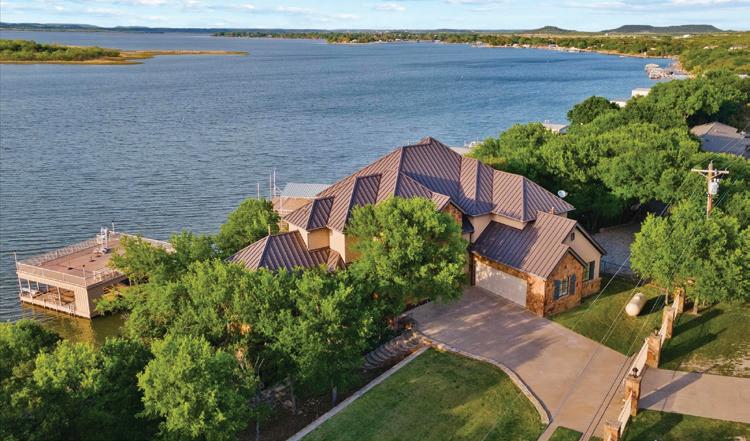


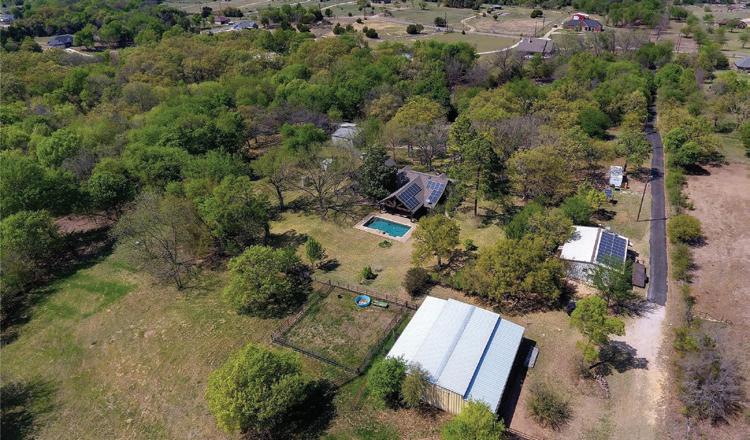





BY JOHN HENRY
Much like the issues facing the Farrington Field and Billingsley Field House acreage on University and Lancaster, redevelopment of Butler Place, the 42-acre former public housing site east of downtown, can only be properly fulfilled if the sum total of the history of the property is preserved. It is not merely plats of ground. The site is alive with generations of heritage that are significant to the history and culture of Fort Worth.
Sale of the property to a developer is contingent on Fort Worth Housing Solutions first gaining the approval from the U.S. Department of Housing and Urban Development. Housing Solutions is seeking HUD consent through a “streamlined voluntary conversion.”
Yet, redevelopment of Butler Place, bounded by Interstates 30 and 35W, and U.S. 287, took a step in recent days with a committee’s recommendations to secure its past.
The Butler Advisory Committee, established by Fort Worth Housing Solutions in 2019 to study ways to conserve that history, presented its ideas to mitigate those adverse impacts.
Among the actions recommended were applying to the city for a historic landmark designation of three buildings, including the former Carver-Hamilton Elementary School building, and two
former residential buildings on Stephenson Street, which is already within an existing National Register of Historic Places district.
The committee also recommended construction of a 6.5-acre outdoor amphitheater on a hillside adjacent to the I.M. Terrell campus; a Fort Worth African American museum and cultural center; a photo and video history of the Butler Place community; and the preservation of 1,000 bricks from the property for the fabrication of a public art installation.
The city’s Neighborhood Services Department would be responsible for monitoring on the implementation of the recommendations.
Butler Place was named for Henry H. Butler, a Civil War veteran who escaped from bondage and was among the first African American teachers in Fort Worth. Butler Place was among those projects constructed under Franklin Roosevelt’s New Deal.
It opened in 1942.
After the war, Butler left the army and set out to be educated, starting with grade school in Pine Bluff, Arkansas. He eventually entered Washburn College in Topeka, Kansas.
“After I graduated, I followed steam engineering for four years, but later I went to Fort Worth and spent 22 years in educational work among my people. I exerted my best efforts to advance my race.”
TCU begins 150th birthday on Wall Street
BY JOHN HENRY
Landmark birthdays should always be celebrated with landmark events, and TCU is getting an early start to No. 150.
To wit: A contingent of Horned Frogs spent a day in the nation’s cultural capital last month to take part in one of the most familiar American traditions: ringing the iconic closing bell at the New York Stock Exchange.
At the NYSE, Chancellor Victor J. Boschini Jr. joined Daniel Pullin John V. Roach Dean of the Neeley School of Business — and other TCU leaders, students, and alumni to celebrate 150 years of leadership and Neeley Horned Frogs leading in business and corporate roles.
“With this bell-ringing, we recognize and celebrate the thousands of Horned Frogs working in business, strategy and finance, leading enterprise here on Wall Street, on Main Street, and around the world,” Boschini says.
Since 1873, TCU has empowered Horned Frogs to lead on for the greater good. The university’s 150th anniversary — Lead On: Celebrating 150 Years of TCU officially kicks off Jan. 23, 2023.
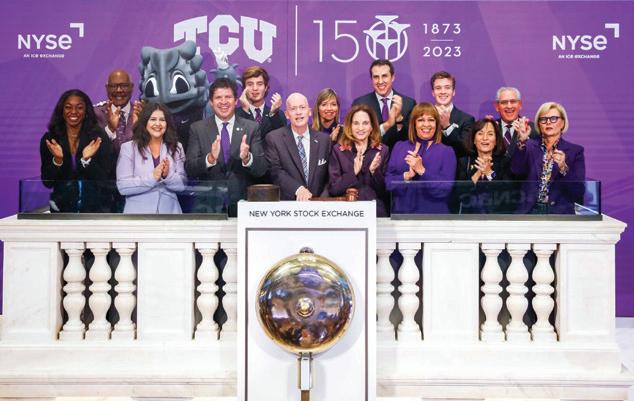


Preorder your very own new Ford Bronco and get exactly what you want, in no time at all.
Don Davis Auto Group and Ford make it easy to get the car, truck or SUV you really want with a dealer assisted preordering system. Select color, options and equipment packages that are exactly right for you.
So stop by Don Davis Auto Group. Check out the new Bronco. Or perhaps a Ford Mustang. And unleash the animal spirit within.
dondavis autogroup.com
*Please visit each event’s website for information on COVID-19 protocols.
OCT. 1
Oklahoma Sooners at TCU Horned Frogs Football
This will be one of your last chances to catch the Horned Frogs facing off against Oklahoma before the Sooners soon pack their bags for the SEC. Amon G. Carter Stadium 2850 Stadium Drive amoncarterstadium. ticketsoffice.org
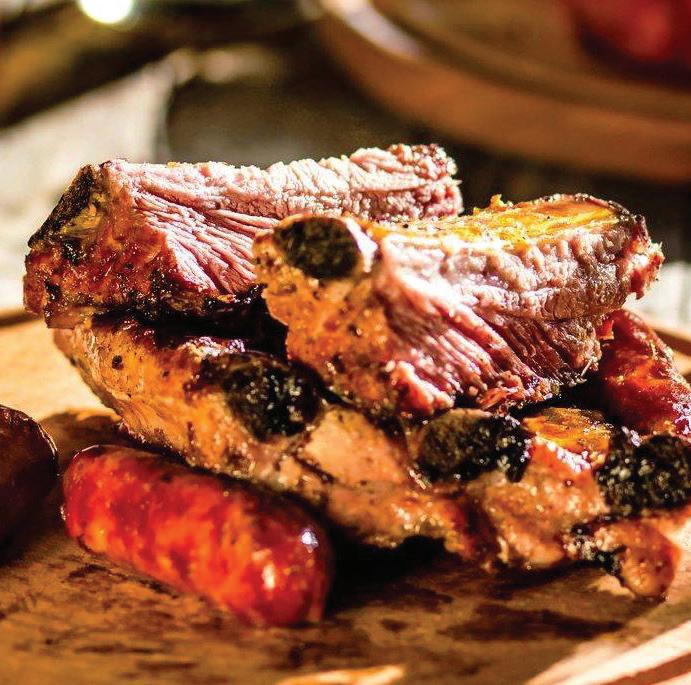
OCT. 2
Fort Worth Eatz: Food Festival
Bizhior’s Sinful Delights and Gifted Ent. DFW is hosting the largest food festival in Fort Worth this fall.
5256 S. Hulen St. 469.438.0247

OCT. 4
Ultimate
Learn about B&B Butcher’s dry-aging process in an exclusive tasting of its cellar-cut meats. Executive Chef John Piccolino carefully pairs the plates with a selection of wines to maximize the experience.
B&B Butchers & Restaurant 5212 Marathon Ave. 817.737.5212
OCT. 6
Wizard Fest
More than just a trivia night, wear your best robes for a night of themed drinks and dancing. A live DJ will perform and hold a contest for the best costume.
Tulips FTW 112 St. Louis Ave. info@wizardfest.com
OCT. 7
Kiln Forming
Level Two Jewelry Workshop
Kiln Forming Survey II is a prerequisite for this class. Participants will create their own jewelry using provided materials over a two-day period.
SiNaCa Studios 1013 W. Magnolia Ave. sinacastudios.org

OCT. 7
Bellamy Brothers
One way to keep a music group together is to be actual brothers. The popcountry duo, who have been around since 1975, will be crooning till 1 a.m. at Billy Bob’s Texas.
Billy Bob’s 2520 Rodeo Plaza 817.624.7117
billybobs.ticketoffice.org
OCT. 8
MysticismEmpowering Your Spirituality
Pastoral Reflections Institute presents a morning lecture by Monsignor Don Fischer on enlightenment, God, and interconnectedness. The event is free, but donations are encouraged.
Fort Worth Botanic Garden 3220 Botanic Garden Blvd. 817.463.4160
fwbg.org
OCT. 8
The Women’s Expo
Attendees will network for free at this women’sonly event. Socialize and peruse female-owned businesses from 11 a.m. to 3 p.m. Vendors pay $150 to secure a spot at the Warehouse.
The Warehouse 1125 E. Berry St. 817.923.9305
OCT. 10
FWISD 2021 Bond Bid Preview
The Fort Worth Independent School District is inviting Historically Underutilized Businesses (HUB), subcontractors, suppliers, and general contractors to learn about upcoming projects and best business practices in the field.
IM Terrell Elementary School 1411 IM Terrell Circle S. 817.814.1431 fwisd.org/bond
OCT. 11
It’s award season for the American Institute of Architects. The institute is receiving guests at the Cafe Modern to present awards for outstanding architectural, urban design, and unbuilt projects by architects practicing in the Fort Worth chapter. A lecture will immediately follow the award announcements.
Cafe Modern 3200 Darnell St. 817.840.2157
OCT. 13 – 16
2022 Christmas in Cowtown Holiday Market
Shop for unique gifts from a diverse group of vendors at the Junior League of Fort Worth’s largest fundraiser.
Will Rogers Memorial Center 3401 W. Lancaster Ave. 682.235.1105 juniorleaguefw.org
OCT. 28

Get in the spooky spirit at the Restoration Family Church. This trunk or treat includes bounce houses, games, music, and food at this free community event.
RFC Benbrook 10201 Jerry Dunn Parkway | 817.249.3010
OCT. 15
Tour de Cure 2022
Join the American Diabetes Association in their largest fundraising event, whatever your cycling experience. Individuals and teams are welcome equally as the community spreads diabetes awareness.
Panther Island Pavilion 395 Purcey St. 469.256.0007 donations.diabetes.org
OCT. 23
The ’70s hit machine visits Fort Worth’s newest music venue. Coming within the first month of Tannahill’s opening, Foreigner will please audience members with live versions of enduring tunes like “I Want to Know What Love Is,” “Cold as Ice,” and “Waiting for a Girl Like You.”
Tannahill’s Tavern and Music Hall
122 East Exchange Ave., Ste. 200 tannahills.com
BY KELSEY SHOEMAKER
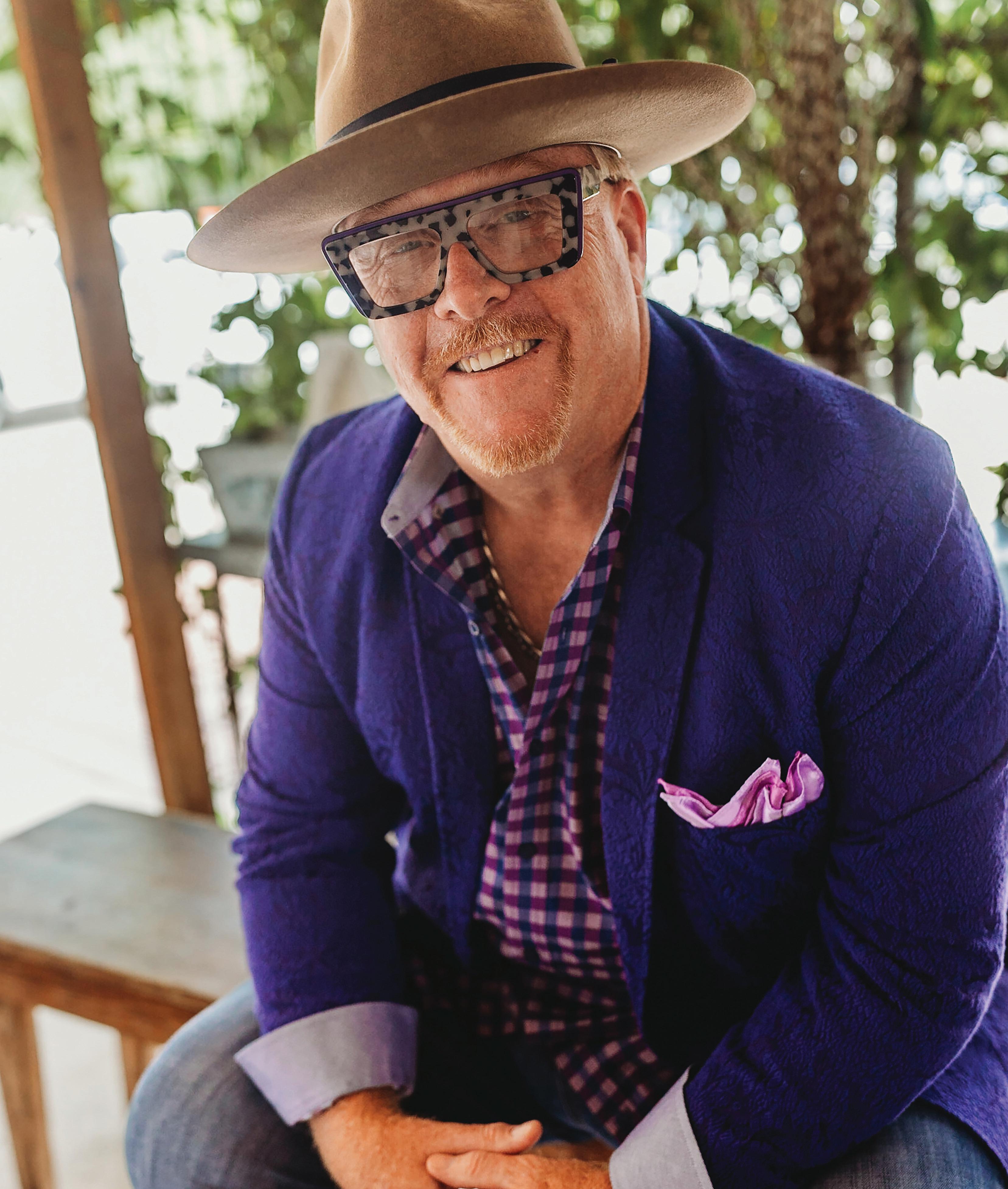
BY


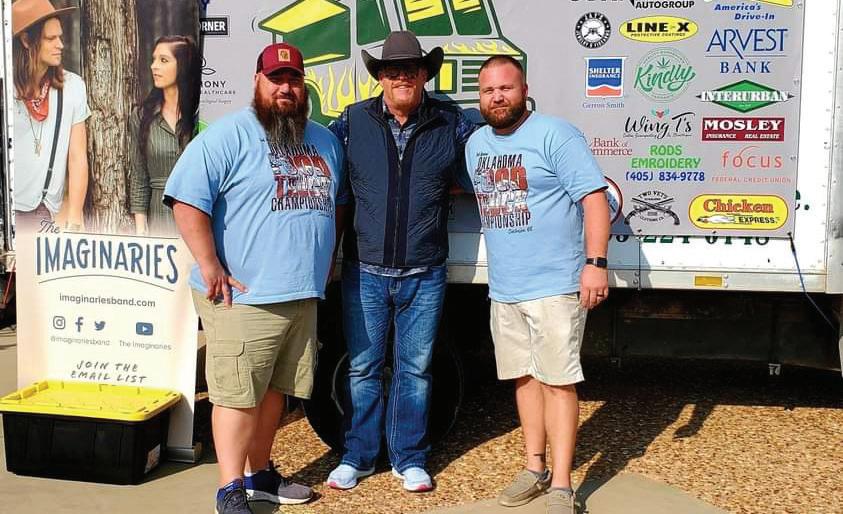
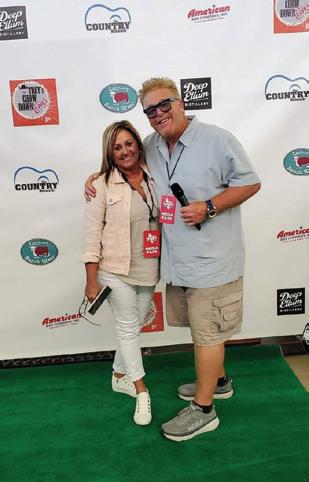
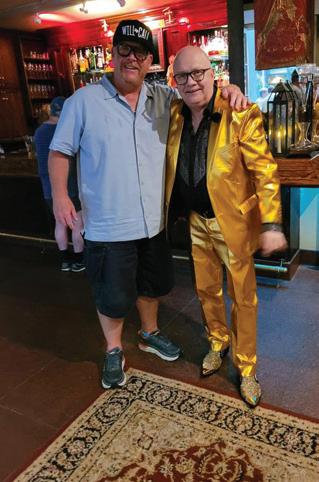

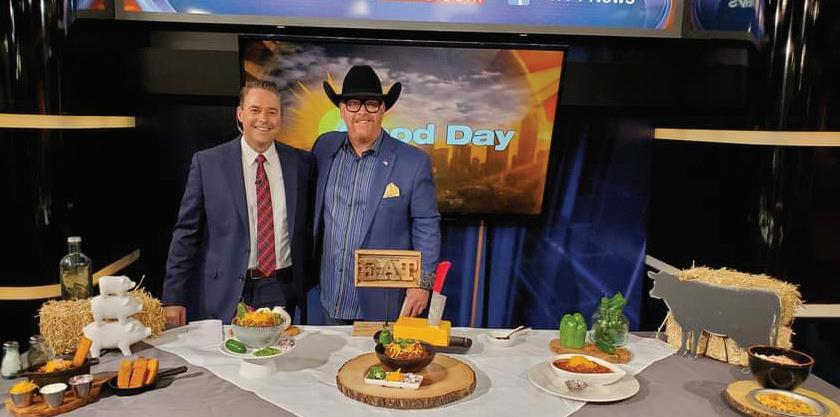
Like a foodie’s version of saying grace, it’s a pre-meal ritual for Trey Chapman to snap a pic of whatever dish might be in front of him. The photo of the culinary adventure will ultimately get an amusing caption and appear on the Instagram feed for Trey’s Chow Down, the food blog he’s been tirelessly updating since 2005.
Thanks to Chow Down’s popularity — coupled with his extroverted personality and fashion sense — Trey has become one of the most recognizable figures in the Fort Worth culinary scene.
Rocking colorful sport coats and thick-rimmed glasses that would make Buddy Holly proud, Trey attributes his combination of flavor and style to his parents, Barney and Carol — themselves heirs to a thriving restaurant business. The Chapmans, who became restaurateurs with the 1905 opening of Lacy’s in Lake Worth, owned a plethora of Fort Worth eateries by the time Trey was of age to wash dishes. Filling almost any available role at his family’s dining spots, Trey became the Tarzan of restaurateurs — growing up around chefs, waiters, and busboys and spending 40 years working at seemingly every diner and dive the city had to offer.
By virtue of this experience, Trey gained a heartfelt appreciation for any meal he is ever served.
“When people real-
ized how much experience I had in the restaurant business — and that I knew what I was talking about — they trusted my reviews,” Trey says. “That’s when the blog took off. That’s when I realized it would be different.”
Jesus Family Restaurant: “Mexican food, fried chicken, and chili that’s unforgettable.”
Carshon’s Delicatessen: “Old-school sammies stacked, packed, and loaded with deli deliciousness.”
On the cusp of the digital age, when Facebook was a mere 1-yearold, Trey launched a website to share his thoughts on local restaurants. He became a food blogger before blogging about food was even a thing, and his site became the de facto source for all things delicious in Fort Worth. Today, Trey has expanded his brand to include podcasting, travel blogging, and regularly hosting food segments on the local FOX and ABC affiliates.
Roy Pope Grocery: “Burgers, fried chicken, and sammies with fresh bold flavor profiles.”
J’s Casa Burgers: “Crazy delicious burgers you will crave.”
Drew’s Place: “Fresh soul food banging your palette with flavors — kapow!
Local Foods Kitchen: “Ridiculous, delicious, addictive dishes.”
Guapo Taco: “Fresh, creative OMG Tacos.”
Star Cafe Stockyards: “Little old-school cafe that slings mouthwatering eats.”
Bluebonnet Bakery: “FTW bakery with fresh, savory sweet deliciousness.”
Montgomery Street Café: “Breakfast that is slap-yagrandma delicious.”
“The podcast has been a success because I’ve wanted to get on networks to spread the news about food,” Trey says. “I enjoy doing it because I can highlight restaurants and promote food and chefs. People work hard, and I want to put them on my platform.”
Far from being smug or elitist with his culinary choices, Trey reviews anything from $1 tacos to $500 fourcourse meals.
“I like to help the people working hard,” he says. “I know the heart behind those grills. I love doing it and hearing their stories. Nothing goes better with food than stories.”
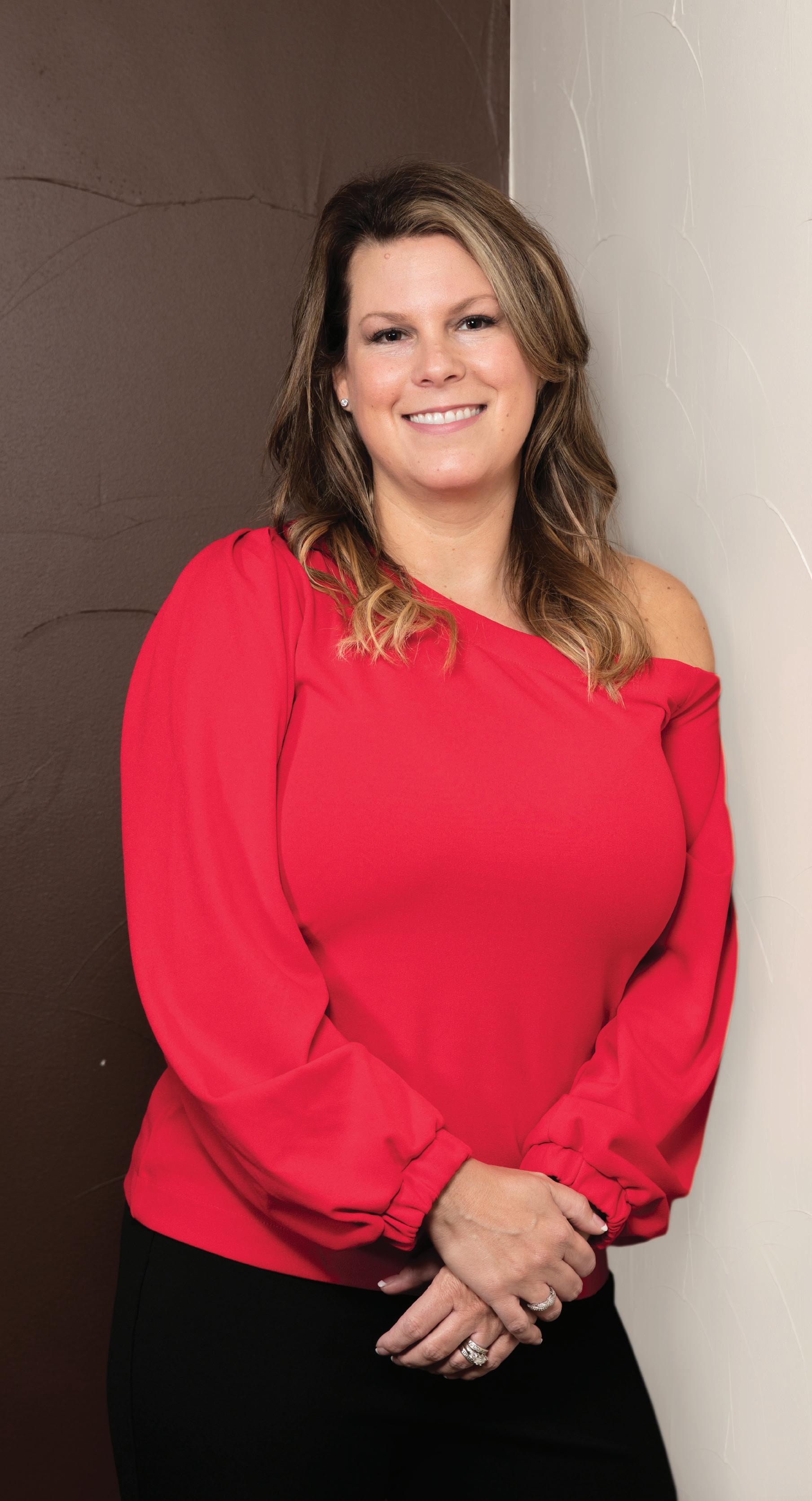
by Dr. Kelly Blair
I chose to make Fort Worth my home because of the people, and I truly feel that my profession as a cosmetic dentist here has allowed me to capture the kindness and generosity of the locals through restoring healthy, genuine smiles. I have demonstrated my dedication to a higher level of dentistry by becoming certified in Implants, Six Month Smile, Invisalign, and accredited in Sedation. My goal as a cosmetic dentist is to truly understand the patient and find treatment options that meet his or her end goals. Each patient is different, and my team and I have the resources and experience that can make those smile dreams a reality. Hands down, my wow factor is my entire team’s commitment to oral health and comfort. From the moment patients walk in the door, we work to make sure the experience is entirely personalized.

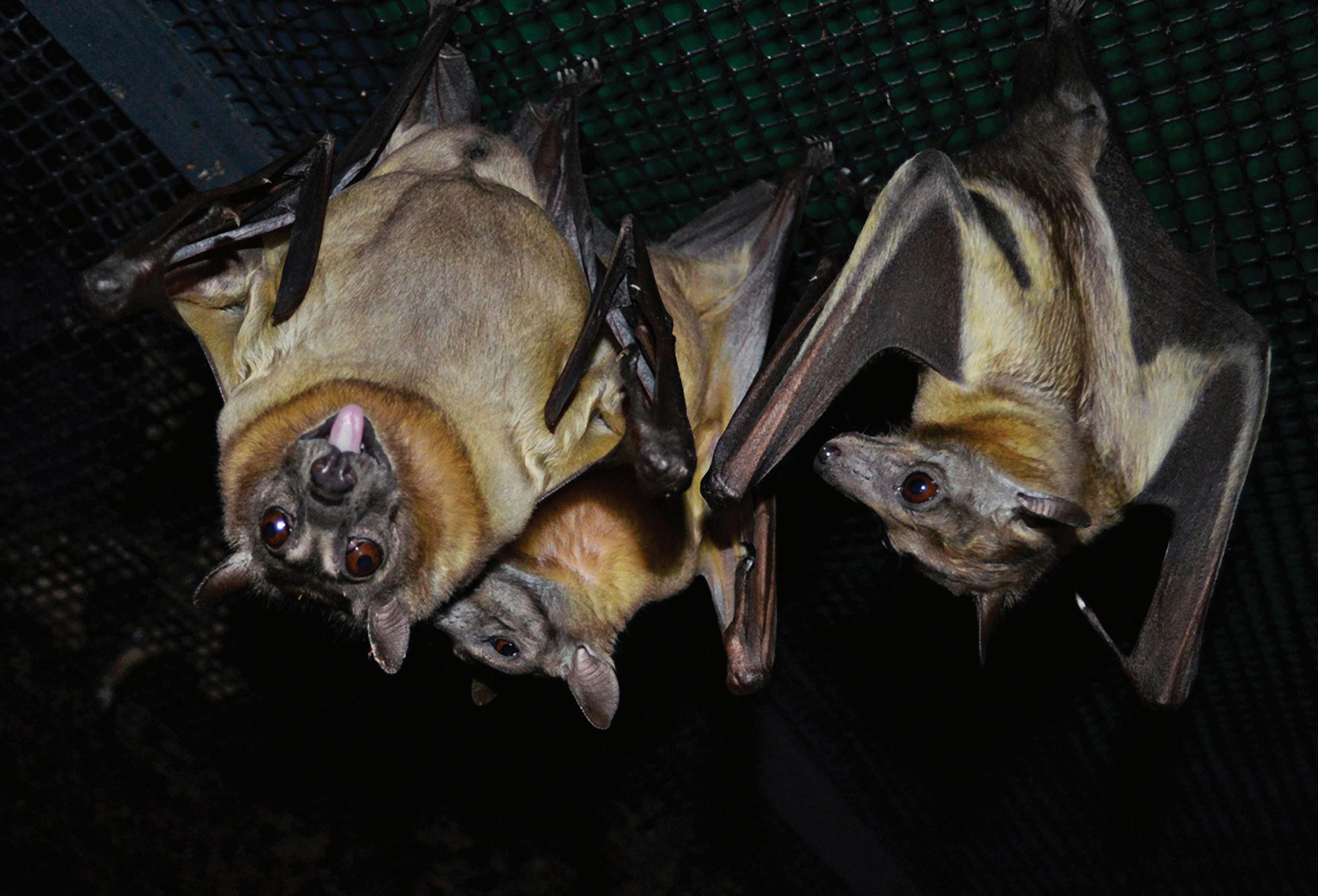
A private sanctuary in Mineral Wells serves as a cozy home for hundreds of radar-guided, flying mammals.
BY BRANDI ADDISON
On a hot summer day in the late 1980s, Amanda Lollar had walked the rural town of Mineral Wells when she found a small bat injured on the scorching concrete sidewalk.
Lollar had not yet opened herself
to the world of truths and benefits behind our benevolent winged friends and at the time believed all bats to be vermin. And after using the tip of her shoe to prompt the bat onto a newspaper because she was too afraid to touch her, Lollar carried her back to her mom’s nearby shop where
she cared for the injured bat for more than a year.
Despite her best attempts to rehabilitate her new bat pal — which she belovingly called Sunshine — she, unfortunately, sustained permanent injuries that Lollar could not fix. But the relationship that evolved between Sunshine and Lollar kindled a flame that would become Lollar’s foreverpassion.
“I just completely fell in love and decided to train and learn more about them and save more bats,” Lollar says.
Today, the world’s only true bat sanctuary — Bat World Sanctuary — is a testament to Sunshine’s legacy and Lollar’s dedication to the far-toomisunderstood creatures.
Roughly 45 miles west of Fort Worth, on the border of Weatherford and Mineral Wells, Bat World Sanctuary houses hundreds of bats from around the world, many of which suf-
Craig Berry, Executive Vice President/Chief Lending Officer at American National Bank and Trust, is a huge fan of the Cadillac Escalade. Berry recently purchased his third Escalade, a sleek, black 2022 Cadillac Escalade Sport Platinum, from Platinum Cadillac in Terrell. “I’ve always loved the performance and look of the Escalade,” Berry says. This luxury SUV features Super Cruise, the first true hands-free driver assistance technology. Berry recalls “the first time I took a road trip in it to Austin, I was blown away at the lane assist and how the car could change lanes, maneuver itself through traffic, and could drive itself.” Berry and his wife also love the 38 inches of curved OLED display, 36 speaker AKG Studio Reference Sound System; audio and video screens that keep their 2-year-old occupied on long road trips.
When asked what sets the Gilchrist Automotive dealership apart, Berry says, “When deciding on a large purchase in life, whether it be the family vehicle or new home, you need someone you can trust and rely on. Stephen Gilchrist certainly fits the bill. In my profession as a community bank executive, we too pride ourselves on the same trust and values. Stephen and the team at Platinum Cadillac handle their business the same way, and that is why I will be a client for life.”



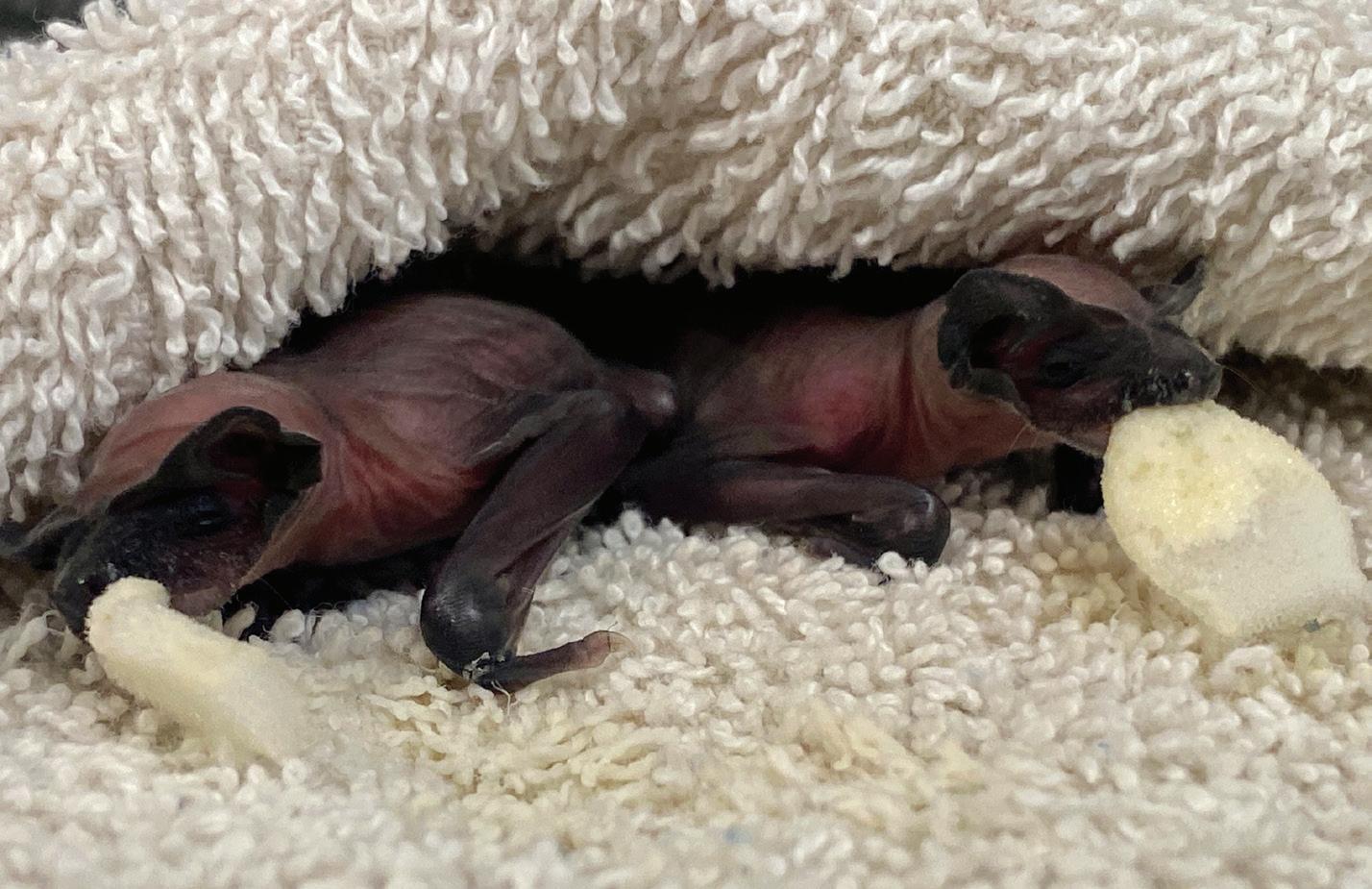

fer permanent injuries, retired from zoos, or were saved from the exotic pet trade — partnering with more than 400 rescuers around the world.
Currently, there are about 450 bats made up of dozens of species from all around the world inside its long-term facility.
“Whenever we rescue them from the exotic pet trade and research laboratories — things like that — we give them lifetime sanctuary in a semi-natural habitat with other bats,” Lollar says.
The typical day in the facility begins just after sunrise — fit for a bat’s schedule — and stays in a constant frenzy for the next eight to 10 hours as staff tries to find the perfect balance in their daily bat care. This includes everything from rescues and
confiscation of “pet” bats to the rehabilitation of injured and dying bats to chopping up 150 pounds of fruit each day.
“It’s a different day every time you come in here,” says Jessica Anderson, the director of education for Bat World Sanctuary.
Beyond rehabilitation and rescue, Bat World Sanctuary also takes part in several conservation efforts, including the implementation of a safe roosting site on its own property as development increases in downtown Mineral Wells.
Lollar says the local bats have historically sought shelter in the older abandoned buildings located downtown. But as Mineral Wells has begun to take steps to restore its city, more and more bats have been forced out of the spaces they long considered their homes.
Rather than forcing bats to migrate into other areas or seek shelter on their own — possibly leading them to another place that will soon see development and require them to relocate yet again — Bat World Sanctuary built a large-scale roosting site and nursery (for moms to safely raise their bat pups) called the Bat Castle.
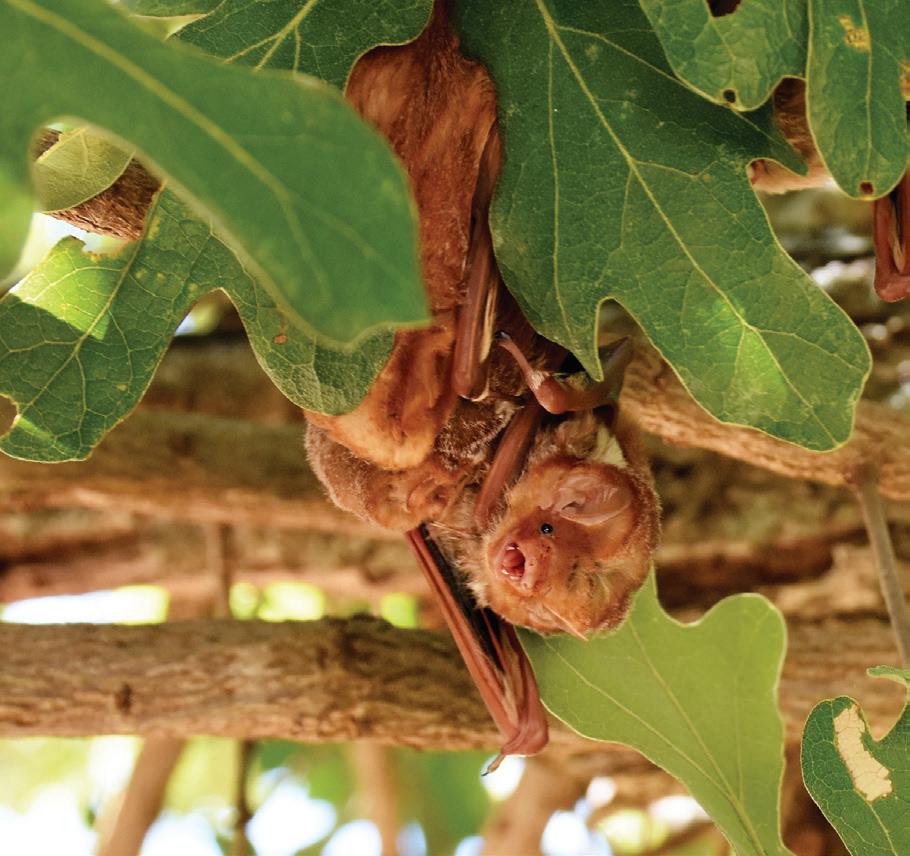
Inspired by the organization’s wild sanctuary, a 100-year-old sandstone building, the Bat Castle can house up to 100,000 wild bats.
As they anticipate similar scenarios across rural Texas as development increases and Texans flock to rural areas amid urban sprawl, Lollar and Anderson say it’s essential for all to help combat the misconceptions that surround the mysterious animals, which often villainize their identities.
Whether they accomplish it through positive messaging on social media or their own hands-on efforts, their biggest message: “We literally cannot live without bats,” Anderson says.
“In addition to helping with crop pest control, they also give us lifesaving medicine. Without them, we wouldn’t have life-saving medicines; we wouldn’t have food to put on our table,” she adds.




$4,895,000 | 5 Beds | 5.2 Baths | 10,146 Sq. Ft.

JOSEPH BERKES
817.570.9453
joseph@williamtrew.com
josephberkes@williamstrew.com
Unique opportunity to be in the prestigious, gated Montserrat community. This private estate boasts 5 bedrooms, 5.2 baths, 3 living areas, gym, theater, golf room, outdoor entertainment area with heated pool and waterslide, and an 8-car garage on approximately 1.3 meticulously landscaped acres. The interior features a light and airy color palette, with soaring vaulted ceilings, impeccable stone and woodwork, and hand-scrapped hardwood floors. This is truly the epitome of luxury living. The primary wing is on the first floor and the chef’s kitchen opens to the beautiful family room. This home was built in 2005 and has been immaculately maintained and is move-in ready.

Envision simple moments.
You won’t believe what’s possible with Realtors ® like us.




KidKare CEO, Kam Phillips-Sadler, tells us her secret to finding new books: TikTok.
BY TINA HOWARD

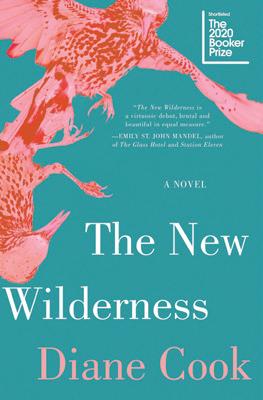
The New Wilderness By Diane Cook
1Bad Blood: Secrets and Lies in a Silicon Valley Startup by
John Carreyrou
In 2015, journalist John Carreyrou began investigating the bio-tech startup, Theranos, founded by Elizabeth Holmes. The company promised to revolutionize the medical industry with a breakthrough device that performed a range of laboratory tests using a single drop of blood. The company sold shares and was valued at around $9 billion, except it had one problem: The technology didn’t work.
Shortlisted for the 2020 Booker Prize, Diane Cook delivers a speculative novel about a mother and daughter, along with 18 other volunteers, who join an experiment to live in the previously forbidden Wilderness State to see if humans can exist in nature without destroying it. Both a commentary on climate change and a portrayal of motherhood, this book examines love, sacrifice, and what it means to be human.


2The Woman They Could Not Silence by Kate Moore
Bestselling author of The Radium Girls, Kate Moore delves into the real-life story of Elizabeth Packard, a pastor’s wife and mother of six in the 1860s. Packard’s husband becomes increasingly threatened by his wife’s independence and opinions, so he has her committed to an insane asylum for her “bizarre and unnatural” behavior. Told in narrative, Moore tracks Packard’s fight for not only her own freedom, but the freedom and rights of women across the U.S.
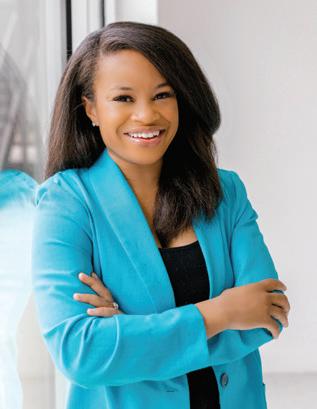
1 Tell us a little bit about yourself. I’m Kam PhillipsSadler, the CEO of KidKare, a vertical SaaS business dedicated to supporting child care professionals manage their back-office operations. I’m a Fort Worth native and enjoy seeing the city change into a foodie’s dreamland; I enjoy experiencing Cowtown one restaurant at a time. Prior to KidKare, I founded a nonprofit, Dream Outside the Box, to expose children to career opportunities that they otherwise wouldn’t have access to. I’m proud that DOTB still continues today on college campuses nationwide.
On a personal note, I was raised in a barn and reared on the back of a horse, so anything ranch related brings me joy.
From feeding cows to saddling up, life’s better when mixed with the faintest smell of manure, don’t you think? 2 What types of books do you enjoy most? I went through a long phase of nonfiction only, where I was enthralled by books like The Immortal Life of Henrietta Lacks or anything Malcolm Gladwell had to offer. After going to business school and reading more cases than my eyes could ever recover from, I’ve had a soft transition to warm and fuzzy fiction. However, I’ve got a big stack of nonfiction books by incredible women like Amanda Gorman, Phoebe Robinson, and Shellye Archambeau that I’m eager to read the minute my brain is no longer mush. 3 Where do you tend to find out about books you want to read? I’m embarrassed to admit, but lately “BookTok,” the content on TikTok dedicated to the literary world, has served me well. I’m currently reading You Made a Fool of Death with Your Beauty by Akwaeke Emezi after seeing it recommended on various social media platforms. I also follow local bookstores on Instagram and appreciate their recommendations. If an author I like is prolific in their writing, what a gift! I tend to stick with their work for sustained content on my nightstand (here’s looking at your lovely love stories, Jasmine Guillory). 4 How do you make time to read? One can only look at so many screens for so long before the mind begs for a break. Every book and every page feel like a fresh reset — a mini vacation. I keep books by my bed and bathtub, ready for the minute the eyes and mind need a retreat.
5 What’s a book you’ve read recently that you would recommend and why? My favorite book I read in the last few years was Bad Blood: Secrets and Lies in a Silicon Valley Startup by journalist John Carreyrou. The book itself is not recent, but still timely, especially now that the actual story will be back in the news in October. I may or may not be known to stop strangers who have it tucked in their arm to exclaim my excitement that they get the chance to experience it from the beginning! It truly reads like a movie, and any podcast or documentaries made about the subject spectacularly pale in comparison.

• Focus is on quality of life and comfort
• Symptom management experts
• Patient and family-centered care approach
• A comprehensive clinical team dedicated to meeting the goals of the patient and family
• In-home visits at a time that is convenient for you
• Coordination with your primary care physician





vnatexas.org





To schedule your free in-home informational visit, please call Sarah (214) 535-2615, or email
gethelp@vnatexas.org

The artist known for immersive experiences is dabbling in a very modern medium: digital art.
BY SHASTA HAUBRICH
Houston native Alli Rogers moved to DFW in 2011 for what she thought was a temporary stint.
After receiving a master’s in art education from UNT, she landed a job at the Kimbell and hasn’t left the area since. Alli now works at Amon Carter
in education and spends her free time creating truly immersive installation pieces that connect community and art. Her work reflects on the nature of play and childhood and how it connects to adulthood. Most recently, her exhibition “Fun Homes” appeared at Arts Fort Worth over the summer, and her
3D mural “Recreation Cantos” is currently included in Neighborhood Leap, an app-based augmented reality art walking trail through South Main Village inspired and co-conceived by The Cultural Assembly. Find out more about her artwork, process, and inspiration in this month’s Take Six.
Fort Worth Magazine: When did you start showing work in DFW?
Alli Rogers: One of my first shows was at Sunset Art Studios in North Oak Cliff with Emily Rigor and Rachel Rushing. They had this cool little space where they would bring in artists, and you got a studio space and a show. For my show “Interfacing,” I did a program at a local library and had children and families use weird materials like straws and tape and stuff to build little sculptures. They could either take them home or put them in this giant bag that I then took back to the studio and installed all over the walls. I made this huge sculpture wrapped around the whole show space. At the opening, people were again invited to come in and cut parts off or add things. So, it was a very iterative process where it’s like, okay, I’m gonna put the materials out here; you get to play with them, which was really fun.
FW: What’s your inspiration for creating this type of work?
AR: It came from trying to build a bridge between myself as an educator and what I value in my work as an educator. Also, my work with young children and exploring how knowledge is created and co-created and shared among people, like a bridge between that and myself as an artist and how I can go into art spaces that have historically been really didactic. Usually, it’s like, “This is what is on the wall, and I’m gonna tell you what this is about, and you’re going to appreciate that and accept it.” Which I don’t jive with. So, it was a way of marrying what I understand about learning, the process of educating and learning, and my process as an artist. This work connected those things in what felt like a more honest






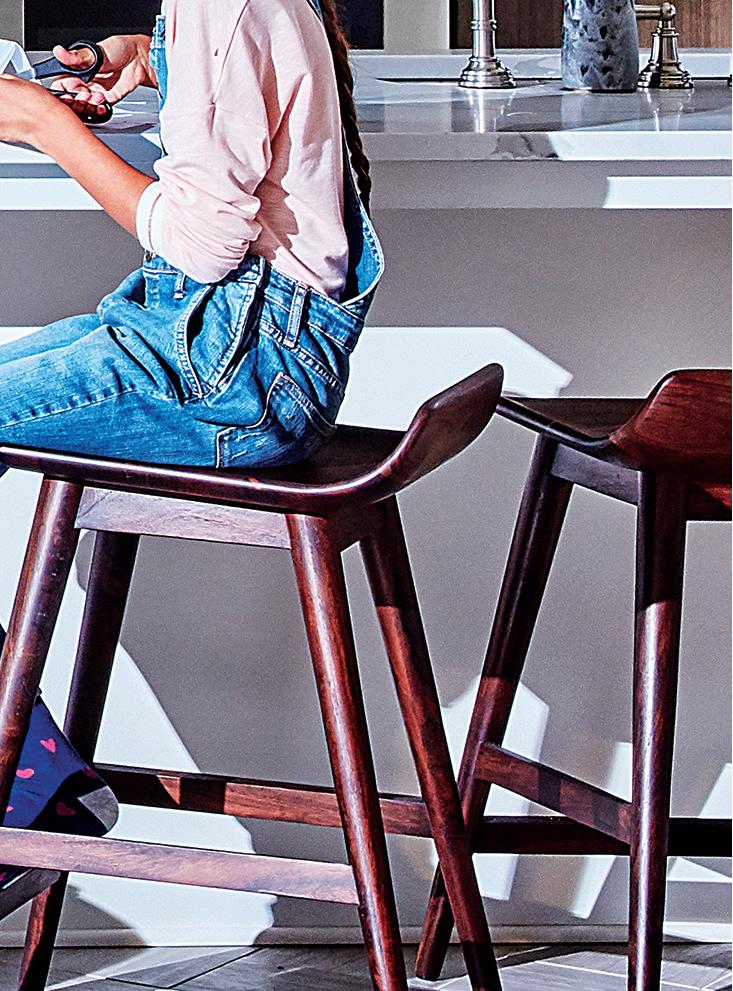
From dual-fuel pro ranges and wall ovens to integrated column refrigeration and panel-ready dishwashers, Signature Kitchen Suite’s full line of luxury, built-in appliances provide the perfect blend of innovation, precision and purposeful design for every kitchen and every appetite. And you can rest easy knowing each one is backed with an industry-leading 3-year warranty featuring our 5-day Repair Promise.*
COMPLETE THE SUITE AND RECEIVE UP TO 10% CASH BACK**
The more Signature Kitchen Suite appliances you purchase, the more you save. Visit our showroom today for details or visit SKS-promos.com.

way than work that I’d made in the past as a student. Work that I enjoy. I enjoy those connection points that can be developed.
FW: How important is community in your work, or is it a natural evolution of the work that it becomes a community event?
AR: It’s both. The work that I did at Sunset directly informed the work I’ve done since then from Sunset Art Studios to Arts Fort Worth, which requires people in order to exist. I’m making what I hope will be compelling materials and setting up the opportunity for people to come in and use the work during opening or educational events. I’ve also been able to have those direct facilitation experiences at each of these places, which I really cherish more than whatever the pictures are afterward. The work that I make is inherently about people, and it is about trying to convince strangers to come together and get to know one another, which sometimes I feel sounds saccharine, like, oh, just be friends, but it’s very serious. It’s the most serious work that we could be doing together. It’s a way for grownups to learn from children and to take their lead. Play is the work of childhood, and I would argue play is the work of adulthood. At its core, play is exploring the world, developing an understanding of the world and then negotiating that understanding between other people. You can play by yourself, but when you are playing with other people, that is negotiation, that is compromise, or that is, I’m taking my ball and going home. It’s boundary building, processing anger, or any of those things. That’s why I say it’s a very serious thing that I’m asking people to do, and children are immediately comfortable in that space. Grownups take some convincing.
FW: How hard is it to get adults to participate and not assume it is for children only?
AR: I have found it really difficult. It’s easier for the adults that I know. At every opening, I have a few friends who come with their children and are into
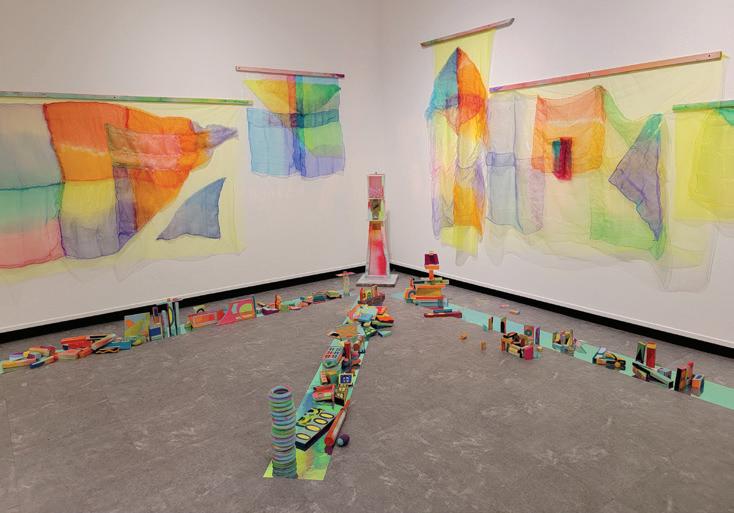
it already, because they know what to expect. But with grownups in general, they are fighting against the learned behaviors of what we do societally and what behaviors are allowed. How often are we allowed to publicly have fun in a way that is not like at a football game or something? It’s fun when I am there, and people are asking me, “What’s the correct way of participating in this? What am I supposed to do?” So, I either give them some rules or don’t give them rules and see how they react. Most of the time, I win people over. It’s also fun when someone is timid about it at first and then 15 minutes later, they have a whole thing that they have built, elbowing kids out of the way and stealing blocks from 3-year-olds.
FW: This question informs my next question, but how would you describe your piece for Neighborhood Leap? AR: “Recreation Cantos” is a layered digital mural combining four translucent digital paintings that rest on top of one another in a way that you can walk through them. They were inspired by the old, abandoned recreation center on the corner of Vickery and Galveston. I drive by that building a lot, and I was kind of curious about it, so I read the history, and they used to hold dances there and all kinds of stuff. Then it fell to the wayside as other recreation centers were built. Thirty-five years later that part of town got quieter, and they got cut off from everything. That led me to making these digital paintings, thinking about the spaces that we come to be in community together. Where do we go to play? Where do we go to laugh together, to cry together, all of those things, and what happens when those spaces go away?
There’s also an audio portion that

is a reading of a song by Ella Jenkins, who is the grandmother of children’s music. She has a song called “A Neighborhood Is a Friendly Place.” I would sing that song with my kids in class. It goes, “A neighborhood is a friendly place. You can say hi to folks walking by. A neighborhood is a friendly place.” So, it’s a song instructing children on how to live in a community with one another. I thought adults needed that reminder too.
FW: So, what’s it like to have a piece where you are completely removed from people’s interaction, which is the opposite of your previous work? AR: That has felt really wild, honestly. That was why I pursued this project. I thought it was really cool that it still requires people in order to exist; and, in fact, more so than any other installation, it literally doesn’t exist unless someone is there with their screen. I kind of wanna set up a little hidey-hole somewhere in the bushes so that I can watch people react to it and see if they can figure it out. When you walk through the layers individually, each one asks you to consider a different aspect of community in the space. It’s calling attention to who the people are around you. Who’s missing from around you? How will you interact with these people? How are you playing together? Making people remember or observe who the people are who have been removed from this area historically as well. In a way, it’s a little bit sad because I don’t get to sit down and play blocks with people, but it’s also really exciting because it is a little treasure there waiting.

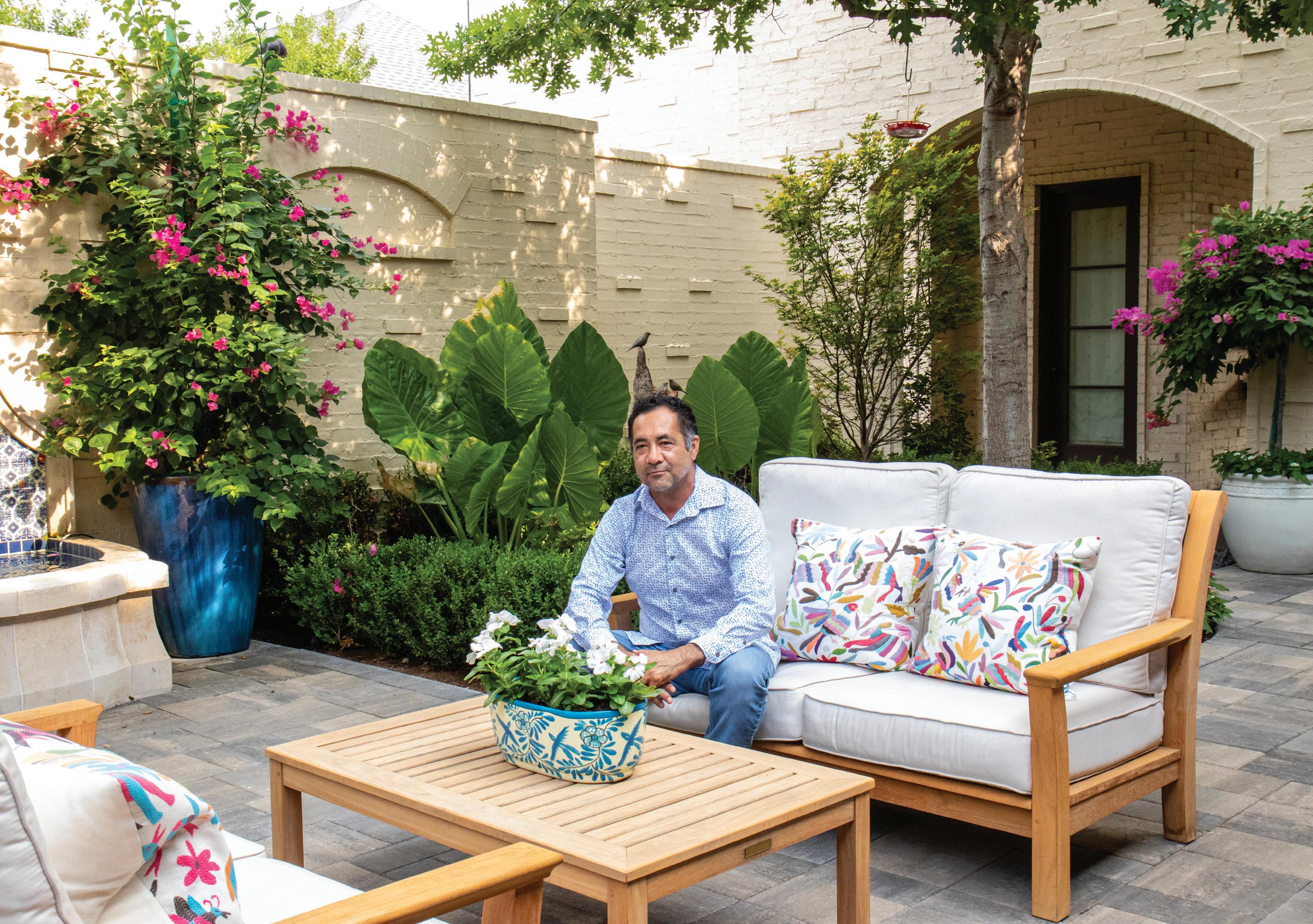


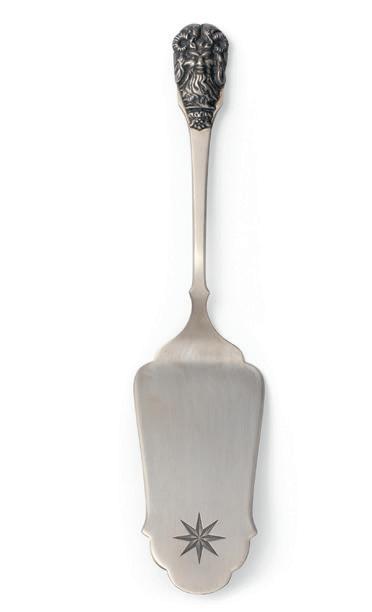
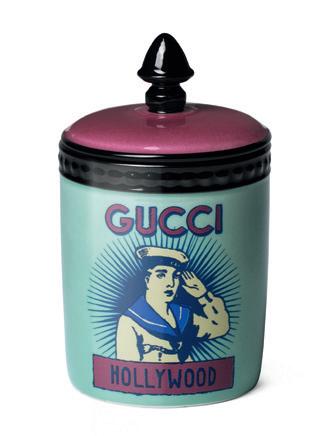




With Gucci officially arriving in Clearfork, the Fort needs to ready itself for a major boost to its options for extravagant and highly fashionable handbags and footwear. To tickle your excitement, here are 18 facts every fashionista should know about the fabulous Florentine luxury brand.
BY JENNY B. DAVIS

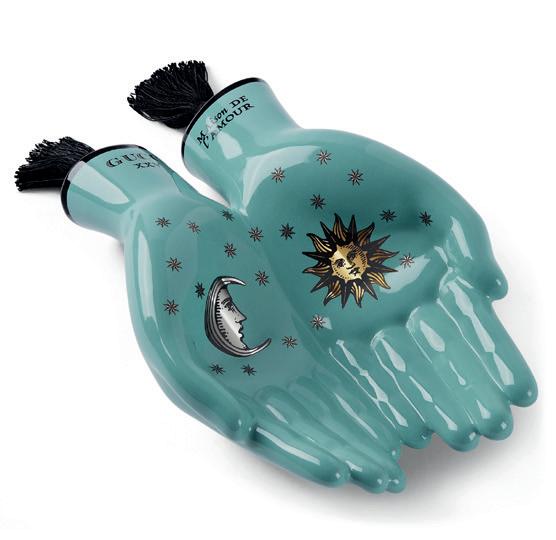
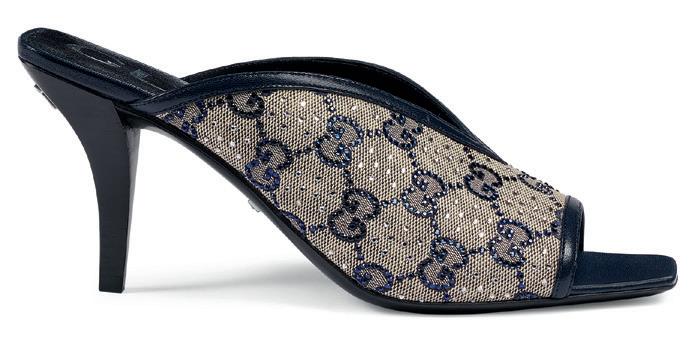

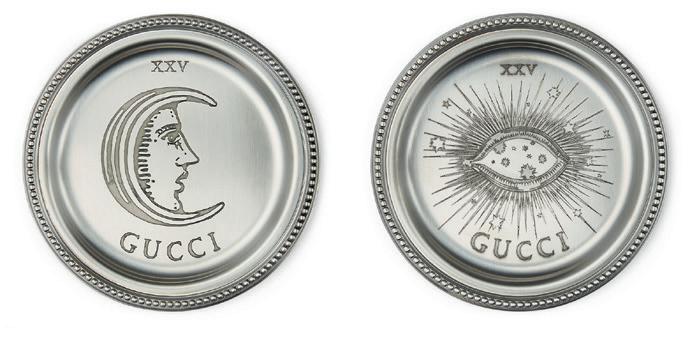



It’s time for Fort Worth to trade in its leather boots and satchels for honeycomb-patterned handbags and stilettos. That’s right, the House of Gucci has officially crashed the Cowtown fashion scene. The global luxury brand renowned for its signature blend of Italian craft quality and eclectic style opened its doors in the Shops at Clearfork retail center at the end of September. Sumptuously appointed in red velvet and gold-gilded accents, the 4,500-square-foot space hosts a decadent collection of men’s and women’s shoes, luggage, eyewear, watches, jewelry, small leather goods, and, of course, a swoon-inducing selection of handbags. But Gucci’s much more than just merchandise — it’s a heritage brand that boasts a 101-year history of visionary design, business acumen, and charitable giving.
1. The iconic Gucci double G logo isn’t just Gucci twice as nice — the logo represents the initials of Guccio Gucci, the visionary who launched the label in Florence, Italy, in 1921.
2. In 1998, Gucci debuted the “Genius Jean,” a pair of denim pants that set the Guinness-certified record as the most expensive pair of jeans in the world. The price? $3,134. Alas, the honor didn’t last — seven years later, an anonymous Japanese collector paid $60,000 for a pair of vintage Levi’s.
3. Through its longtime partnership with UNICEF, Gucci has donated more than $20 million to further the global nonprofit’s initiatives to educate children in Sub-Saharan Africa and Asia and gender-empowerment programs.
4. During the pandemic, Gucci worked with UNICEF to help ensure equitable vaccine distribution, in part through its funding of 200,000 COVID-19 vaccine kits.
5. Grammy-nominated Atlanta musician Radric Delantic Davis, better known as Gucci Mane, says his stage name wasn’t actually inspired by the Gucci brand. Rather, Gucci Mane was the nickname given to his dad by his grandmother, whom Davis says didn’t know anything about the brand when she coined the moniker. But Davis sure knows his way around a Gucci fit. He’s often photographed rocking the double Gs and was even the face of the 2020 Cruise collection.
6. Although Gucci is a thoroughly Italian brand, it does owe a significant debt to Texas. In the 1980s, Gucci was on the brink of bankruptcy until a talented young Austin-born designer named Tom Ford joined the company. In 1994, he took over as creative director, and his sexy, decadent designs for stars like Gwyneth Paltrow, Jennifer Lopez, and Madonna earned Gucci both critical acclaim and record profits.
7. Described by Bloomberg as the “AntiUGG,” the Princetown mule has become a fashion classic. But when the style debuted on the runway during the Fall/
Winter 2015 collection, the fur trim fluffing forth from the soles came from wild kangaroo. The material was soon switched out for dyed shearling, and sales soared.
8. In September of 2017, Gucci entered the home zone with the introduction of Gucci Décor, a collection that includes furniture, accents like pillows and candles, and tabletop objets like small porcelain trays, all infused with an aesthetic Architectural Digest once described as “Elton John meets Italian Renaissance.”
9. When Guccio Gucci began the business in 1906, it was a high-end saddlery. When Italians began trading horses for cars, he decided to transition to artisanal leather goods. The rest, as they say, is history.
10. While boutiques offer the opportunity for a 360-degree, floor-to-ceiling Gucci experience, it’s nothing compared to stepping inside the Gucci-verse, aka the Gucci Garden Galleria in Florence, Italy. Housed inside the historic Palazzo della Mercanzia, it includes a boutique brimming with one-of-a-kind creations and exclusives, a museum that includes both artifacts and art installations, and a restaurant run by three-Michelin-star chef Massimo Bottura.
11. When former TCU quarterback Trevone Boykin was arrested in 2017 following an alleged drunk driving accident, police also found marijuana — tucked into his clothing-filled Gucci bag.
12. In the 1980s, Harlem fashion icon Dapper Dan dressed many of hip-hop’s biggest stars, draping them in headto-toe Gucci logos — all completely unauthorized by Gucci. Fast-forward some 40 years, and the tables turned when creative director Alessandro Michele incurred the internet’s wrath when he sent a logo-covered jacket down the runway that harked back to a well-documented Dapper Dan original. Rather than ignore the situation, Michele reached out to Dap, and the result was a 2018 collaborative collection. The partnership continues to this day through the Dapper Dan Atelier Studio
in Harlem, where Dapper Dan creates his signature custom pieces for private clients, now with Gucci’s complete authorization — and encouragement.
13. Looking for vintage Gucci? There’s no need to seek out a vintage store or reseller thanks to Gucci’s online concept store, Gucci Vault. Launched in 2021, the site features archival pieces from past collections dating back to the 1960s, many of them re-imagined with added details like hand-painted elements, making them both vintage and one of a kind.
14. This summer, Gucci established a new brick-and-mortar boutique — sort of. Called Gucci Town, it’s a single-story piazza with expansive front windows that hosts a shop and an exhibition space for artwork. But it doesn’t exist in the physical world but rather in the metaverse, inside a platform called Roblox.
15. Gucci joined forces this year with SUPERPLASTIC to roll out SUPERGUCCI, a collection of NFTs sold on the Gucci Vault site. This is Gucci’s second NFT collection; last year’s Aria NFT collection was auctioned off last year. With prices beginning at $20,000, these NFTs were among Gucci’s most expensive ever sold, but it was all for a good cause — proceeds were donated to UNICEF.
16. At one point in the 1980s, the floor of Congress was called “Gucci Gulch” because so many lobbyists wore Gucci loafers.
17. In the biography, In Black and White: The Life of Sammy Davis, Jr., author Wil Haygood reveals that the Rat Pack legend so loved the black leather sofa in the Gucci boutique in Beverly Hills that he had the manager call Emilio Gucci in Italy to ask to buy the couch. Gucci agreed to sell it, but Davis didn’t just want the black couch, he wanted a white one, too. Gucci filled his request, and Davis stationed the sofas in his sunken living room. Whenever a guest commented on them, Haygood writes, “Sammy would grin: ‘Gucci, baby. Gucci.’”
18. According to Vogue.com, the No. 1 most iconic Gucci bag of all time is the suitcase bag. It was inspired by a set of suitcases designed by Guccio Gucci in the 1930s. The cases were groundbreaking for the time because they featured cotton canvas instead of leather, a necessary switch because of World War II sanctions that affected leather supply. Also making the list: the Soho Disco and the Dionysus.

Interior architect Sterling McDavid infused her family’s New York City home with aesthetic inspiration from her native Fort Worth.
BY JENNY B. DAVIS
PHOTOGRAPHY BY KIRSTEN FRANCIS
INTERIOR STYLIST: ANTHONY SANTELL

Sterling McDavid distinctly remembers the moment she saw the trio of yellow-haired women splashed with blue, peach, and green.
A close friend’s grandmother had a backyard pool, and McDavid and several friends were invited there to swim. On her way outside, she spotted the colorful portraits. She was mesmerized.
The grandmother was happy to share the story behind the pieces and many of the other works on display in her Westover Hills home. And they were good stories, too — the grandmother was Kay Fortson, founder of the Kimbell Art Museum, and the works that had captured McDavid’s attention were portraits of her painted by Andy Warhol.
The experience had a significant and lasting impact on McDavid.
“I think my love for art really started in Fort Worth, and spending time with Kay Fortson was inspiring,” she recalls.
McDavid is the founder and CEO of Sterling McDavid LLC, a New York City-based residential redevelopment and design firm. About two-thirds of her business involves real estate acquisition and renovation — she buys distressed properties and transforms them to either rent or flip. But she always leaves room to accept interior architecture projects for others, and since starting the company in 2014, this aspect of the business has been
growing. She’s currently working with clients in New York City, Greenwich, Aspen, and Fort Worth, bringing to each project a distinctive art-centric approach to design that sets her apart from others in the field.
“I like to think of each project as a truly unique piece of art,” McDavid explains. “It’s not about creating the perfect aesthetic or imposing my personal style; it’s about embracing the location and elements that speak to the homeowners to create their masterpiece.”
Recently, McDavid channeled the acquisitional energy of Kay Fortson and other notable art patrons from her native Fort Worth when she took on what was perhaps her most challenging project to date: her own family’s first home.
It was a far cry from the type of projects she handled when she moved to New York City over a decade ago. She’d dreamed of living in the city since middle school when she began tagging along on the frequent trips her parents, Stacie and David McDavid, took there for business. In 2011, she realized that dream, accepting a job at the legendary investment banking firm Goldman Sachs before the ink on her University of Texas finance degree even had time to dry.

For years, she lived at warp speed. She logged long hours at work and spent her scant free time supporting UNICEF and launching a variety of side hustles to indulge her creative interests. She started a company, The Starling Project, to sell a decorative hand-poured votive candle she designed to fund UNICEF’s solar-power

projects across Africa. She also launched a successful lifestyle blog and began networking with content creators, painters, filmmakers and other arts entrepreneurs. Eventually, it became clear that, while she loved working at Goldman, she couldn’t continue compartmentalizing her creative side. It was time, she decided, to discover what she could accomplish if she fully tapped into her artistic talents.
In 2013, McDavid enrolled in the interior architecture degree program
at Parsons School of Design. Looking back, it made perfect sense. She’d always loved playing with space. As a young girl, she redesigned her room at least once a year, pressing on with her meticulously developed plans even though her parents made her pay for all of the changes herself.
She’d also grown up surrounded by the eclectic art collections owned by her parents and their friends. Mary Ralph Lowe, McDavid’s godmother, had a tremendous influence on her aesthetic development, instilling in her a love of collecting. And the late Anne Marion, a towering figure in the worlds of art, business, and philanthropy, was an all-around inspiration — as was her home, one of only three residential structures ever designed
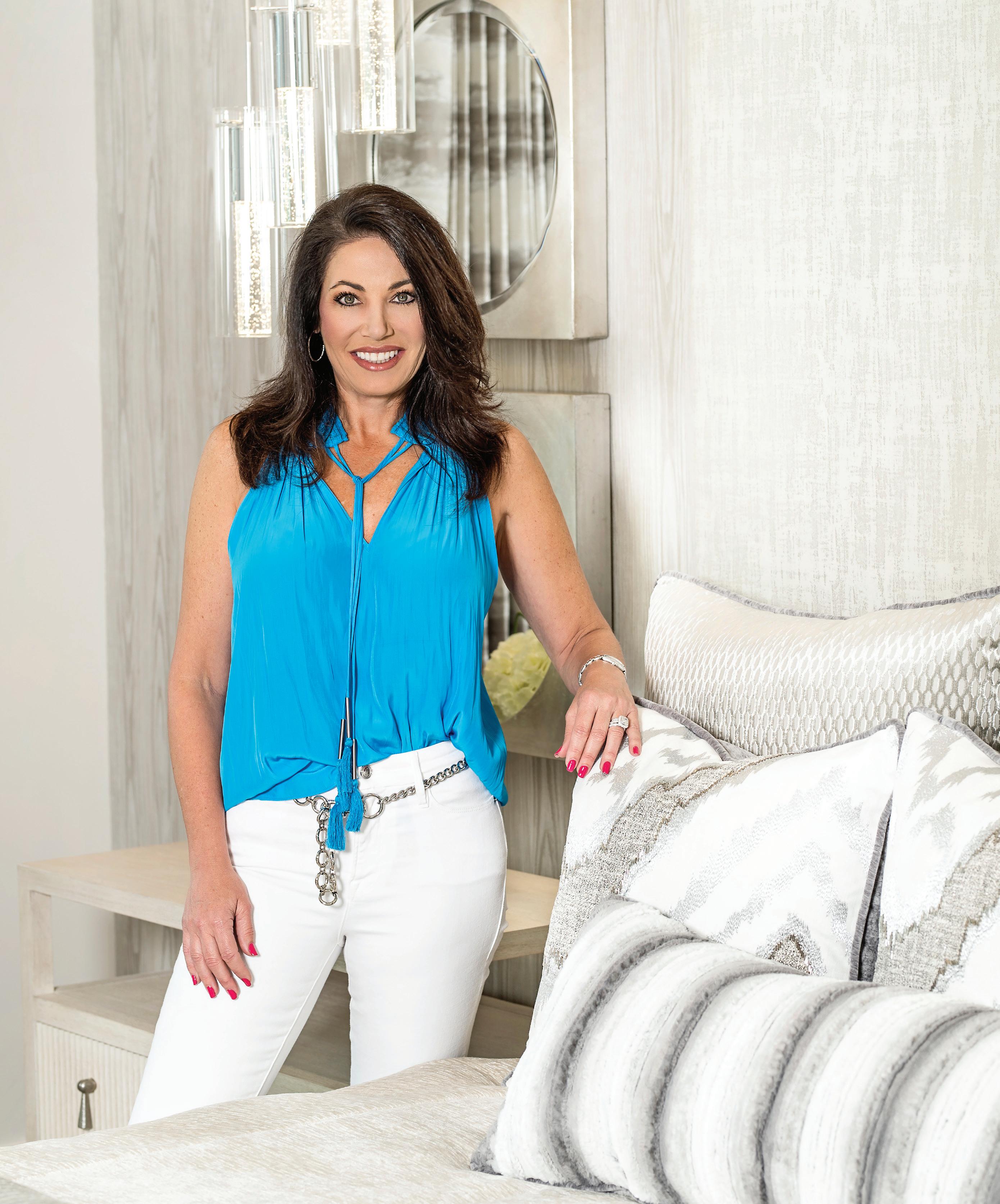




The family room features selections from McDavid’s collection of over 250 coffee table books and a trio of KAWS companions, a nod to the Museum of Modern Art in Fort Worth, home to the Brooklyn-based artist’s monumental bronze sculpture, “Clean Slate.” McDavid chose gray and blue hues for their calming effects: This room is where the family relaxes and also where McDavid often starts her workday before heading to the office.
Note the Starling Project candle on the marble-topped table: McDavid launched this company to raise money for UNICEF’s solar-power initiatives in Africa. Each handpoured soy candle rests in a recycled glass votive and burns for 60 hours ($34, starlingproject.org).


vibrant pop of
by I.M. Pei. These experiences imbued McDavid with an appreciation of art — this was, after all, the girl who’d rather admire a Warhol than swim with her friends — and also with a recognition of its relationship with architecture. “I don’t know why I even thought I could
do anything different for a profession,” McDavid says.
After graduation, McDavid set off for Paris to work with an internationally renowned architecture firm called Projectiles (the talent behind the most recent renovation of the National Cowgirl Museum and Hall of Fame). She would have stayed forever, but her heart was still in New York City. She’d fallen in love with a New Yorker — her former Goldman colleague Carey Dorman, now a corporate CFO. She returned, and in 2017, they married atop Aspen Mountain. They’d always intended to start a family one day. Although they weren’t sure of the timeframe, what they did know for sure was that they’d stay in
the city.
“I refuse to accept the assumption that New York City is not livable for families,” she says. “To me, the beautiful thing about New York City is the energy and the diversity, in every sense of the word.”
McDavid acknowledges that city life means tradeoffs.
“We knew we wouldn’t be able to have one of those massive homes with giant playrooms where kids can go crazy,” she acknowledges. “But we have trees, we know our neighbors, we have community, and we have a home that’s uniquely ours.”
In the course of her professional career of reviewing distressed properties for investment potential, she began keeping an eye out for a listing with personal appeal. In 2019, she found it.
“What made me fall in love with this property was the building — the history of it,” she recalls. “I felt like it was the epitome of old New York, and
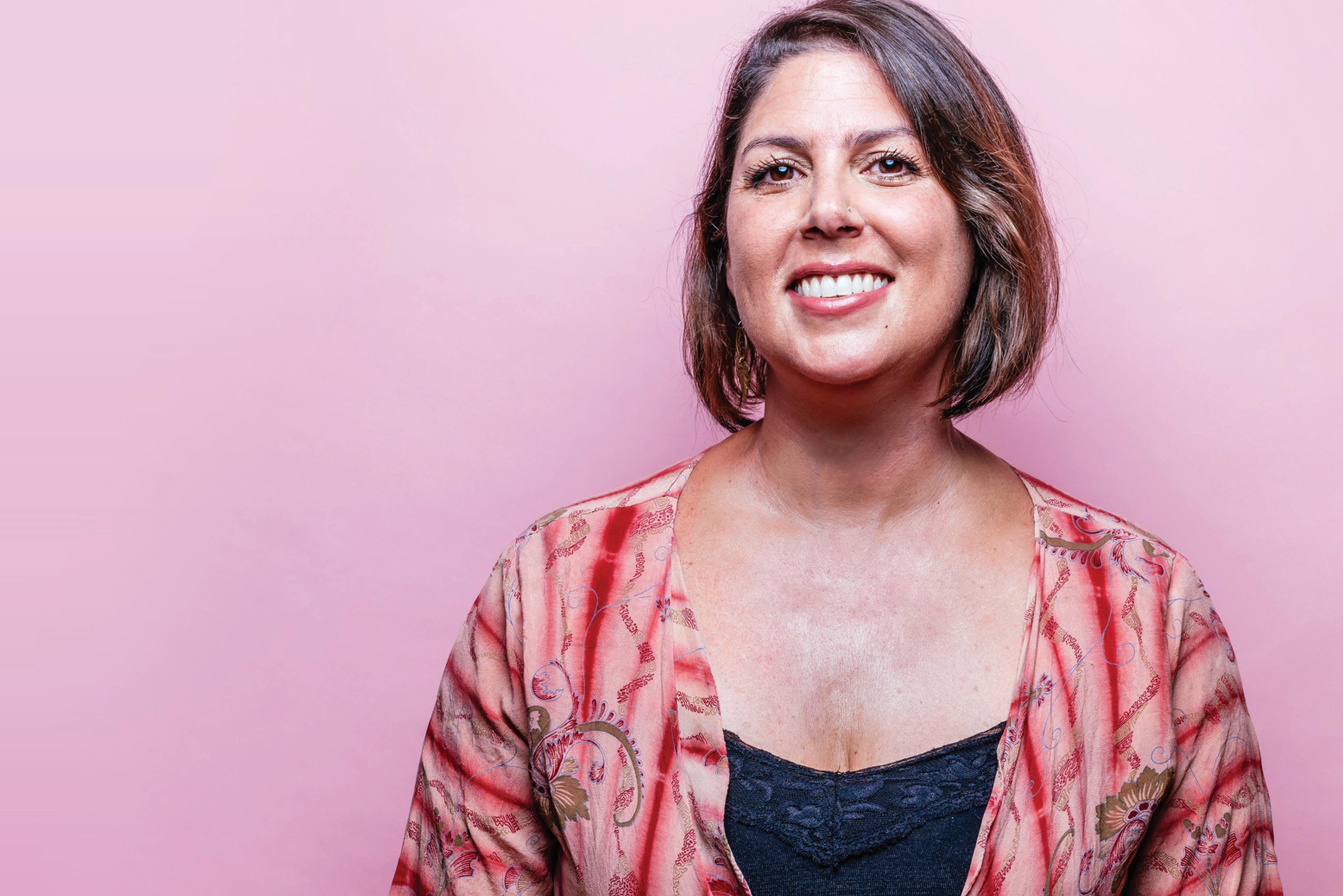

3D mammograms
Breast ultrasounds
Fine-needle aspiration
Ultrasound-guided biopsy
3D stereotactic-guided biopsy
Nurse navigation services
Care for those at a high risk
that was something very special.”
Like an important work of art, the building held an impressive provenance. Built in 1901 by the Astor family, it was an architectural gem of the city’s Upper West Side, and it boasted an array of historical hallmarks like a gray brick façade, banks of white-trimmed bay windows, and an elegant, mosaic-tiled lobby.
The apartment inside, however, was
a blank canvas. While demolition was finished, renovations had stalled. The space was like a giant, open box — an optimal situation for the clean, contemporary aesthetic McDavid favors. The opportunities were obvious, but so were the challenges. The most significant involved a lack of natural light.
“I think of every design project as completely different, but the one

thing I always do is maximize natural light, and that was difficult with this property,” she says. “The windows were small, and because it was a historic landmark, I couldn’t make any changes that would affect the exterior.”
That said, it wasn’t a dealbreaker — it was just one of the things that distinguished the space as being pre-war, a signifier of the city’s architectural history and structural integrity.
A dining area that prioritizes comfortable seating for many people was a must for the couple, who are known for their epic dinner parties. Just off camera is a fully stocked bar featuring barware made from vintage chemistry beakers.
McDavid got to work planning a four-bedroom, 3 1/2-bathroom space capable of accommodating work, rest, entertaining, and at some point, children.
In the living room, she gave significance to the small wood-burning fireplace by adding a custom marble mantle and visually enlarged the space by topping the mantel with an elegant mercury glass mirror. Floating bookshelves showcase the couple’s collection of vintage and first-edition books. The all-white upholstery, including white velvet and white linen, appears at first look to invite trouble in a family home, but it is in fact quite resilient — it’s sourced from Perennial Fabrics, a luxury line that’s beloved for its stain and fade resistant weave.
Across every room, McDavid created a soothing, minimalist space that all but begged for the finishing touch: art. Those decisions, she says, were among her favorite to make.
“One of my biggest passions when I do a design project is the art,” she says. “A lot of designers are heavily focused on furniture, but for me, I prefer to be minimalist on furniture because if you have great art, it makes everything shine.”
Even better, the works she chose for her home came from artists she both admired and knew personally, like a colorful painting called “Untitled Paradise” by Dorman’s friend, David King Reuben, and a commissioned piece by artist Kristen Giorgi, one of three works by the artist that the couple own (McDavid commissioned this one


4350 River Oaks Blvd. | Fort Worth, Texas 76114 | 817.336.0345 | thompsonfunerals.com HAVE YOU HEARD? WE HAVE MOVED!
THOMPSON’S HARVESON & COLE has served the Fort Worth area funeral and cremation needs since 1911. After six plus decades on 8th Avenue we have moved. Our new location is in the old John Knox church. The facility includes a beautiful Tudor chapel with stained glass windows, large sparkling reception room, a serving kitchen, lovely outdoor areas, and ample parking. The Thompson family continues to provide Fort Worth, and its surrounding areas, with the outstanding service that has earned the company such a superior reputation for so many years.
as a wedding anniversary gift to her husband).
For McDavid, however, these artworks are more than just acquisitions: “I care about the artists I put on my walls,” she says.
She points to two works with special significance.
The first is a painting by Malik Roberts, which hangs in the foyer. The Brooklyn-based painter is known for abstract works addressing social issues like police brutality and systemic racism; his painting of Black Christ is part of the papal collection. But Roberts is also renowned for his signature portraiture style, which reflects images and emotion as fragmented, kaleidoscopic layers.
When he invited McDavid to sit for a portrait, she immediately remembered the afternoon with Kay Fortson so long ago and knew she had to say yes.
“The decision to have a portrait done by Malik was totally inspired by Kay Fortson and her Warhol portrait,” she recalls.
Another of McDavid’s favorite artworks is a graphic piece by her close friend, the painter Shantell Martin. McDavid recently added it to the last room in the home to be tagged as design-done: the nursery. Last year, she and Dorman welcomed a son, Quinn. Creating a serene yet whimsical room for him was a joyful task and a successful one, too — she says he’s already transfixed by Martin’s bold black-and-white design.
McDavid says her home is complete — for now. “Things will evolve,” she concedes. She and Carey may decide to expand their family. Perhaps they’ll want to add to the collection of KAWS companions on display in the family room. Perhaps a crayon or two will come into contact with the handpainted De Gournay wallpaper in the
bath.
Then, there’s another possibility: That Quinn will begin to form design opinions of his own and will ask for some changes. McDavid laughs at the thought, but she also wouldn’t be surprised.



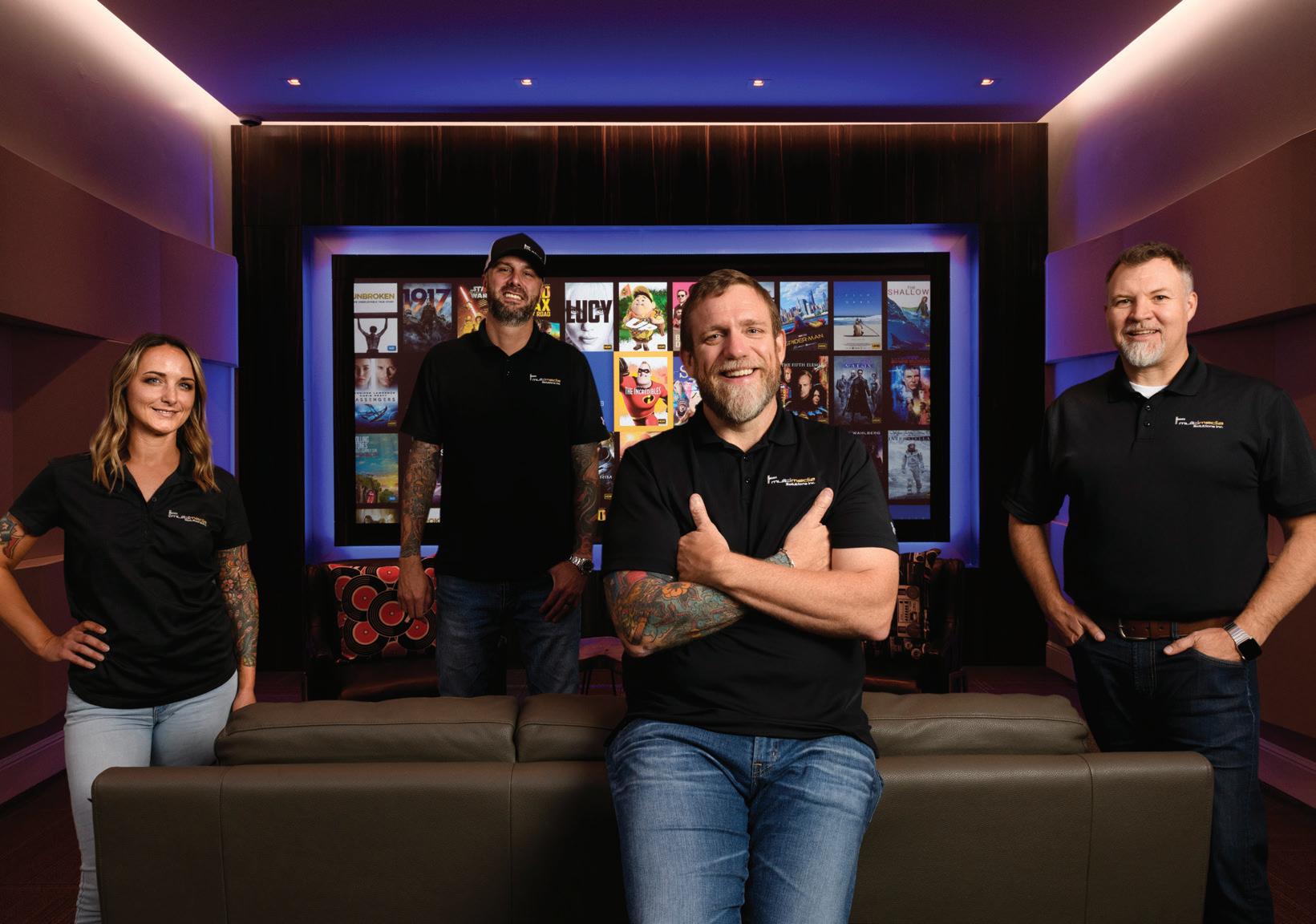
With personalized whole-home control and automation, effortless living is a simple button press away. And whether you run an office, restaurant, or retail store, commercial automation and office networking will elevate the efficiency of your business.
Technology





Months after a fire clouded its future, Little Lilly Sushi has returned to reclaim its title as the best sushi restaurant in Fort Worth
BY MALCOLM MAYHEW

There was a time — surprisingly, not that long ago — when good sushi was hard to find in Fort Worth. Japanese Palace and the now-gone Tokyo Steakhouse were longtime sushi fixtures, but it wasn’t until Piranha Killer Sushi opened downtown that the raw fish trend really took hold of Fort Worth.
One of the early entries was Little Lilly Sushi, a quaint spot on Camp Bowie that specializes in sushi that goes beyond the norms of California and Philadelphia rolls. Much of the exotic seafood is brought in from around the world; if it wasn’t the first place in Fort Worth to serve uni, it was among the first.
Owner Chih “Danny” Liu, a native of Taiwan, opened Little Lilly in 2012. He had spent years working in sushi restaurants, including another Fort Worth spot ahead of the trend, Sushi Yoko. Little Lilly quickly established itself, winning countless awards; it’s often regarded as the city’s finest sushi restaurant.
Even while countless other sushi spots flooded Fort Worth, Little Lilly continued to thrive — until this past May when a major fire blurred its future.
“At that point, we weren’t sure what we were going to do,” says Ann Liu, daughter of Danny. “We wanted to reopen, but what that was going to look like, no one knew.”
Ann, who works at Little Lilly as a manager and server, says after neighboring west siders and local foodies begged them to return, the family decided to push forward and reopen. A GoFundMe campaign was launched, and the Lius began rebuilding the restaurant, practically from the ground up, Ann says.
In September, after more than three months of work, Little Lilly Sushi reopened, sporting a new dining room and menu

and practically the same staff.
“Just about everybody came back,” says Ann, whose mother, Shu, also works there. “Which says a lot about how my dad treats his staff.”
New menu items include miso black cod, a filet of black cod marinated in miso paste, then panseared; chu tartare, a rich tartare made from blue fin tuna; and the 2022 roll, a sushi roll stuffed with garlic-seasoned salmon, avocado, and asparagus, then topped with seared king salmon, green onions, and garlic ponzu sauce.
The dining room has been rejuvenated with new paint and light fixtures. Likewise, the large sushi bar was rebuilt with a new marble counter. “It feels much bigger and brighter now,” Ann says; the patio features all new tables and chairs.
The family has faced dire situations before. In 2017, the restaurant was forced to close for a month after a fire — the restaurant’s first — caused significant damage to the kitchen. COVID, of course, dealt a serious blow, causing the restaurant to cut back on its hours and also switch to take-out only. In May 2021, in the middle of the pandemic, Danny was diagnosed with Stage 3 bladder cancer. But after several rounds of chemotherapy, the restaurant announced he was cancer-free.
“I think we’ve faced a lot of the same problems that other families who own restaurants face,” Ann says. “But we’re pretty persistent. We love this business and the customers who’ve been coming here since we opened. We’ve been doing this for 10 years now, and so, for us, stopping isn’t really an option.”
So much time has passed since Little Lilly originally opened, Ann points out, that the young girl for whom the restaurant is named is no longer that young. Lilly Liu, Danny and Shu’s granddaughter, is now 14.
“She’s old enough to work here now,” Ann says, laughing. “In Texas, if you’re 14 you can work in your family’s business. And she wants to work here, not just to make money, but because she loves interacting with the customers who’ve known here since, well, she was Little Lilly. It means a lot to her.”
Little Lilly Sushi, 6100 Camp Bowie Blvd., littlelillysushi.com


Now you can enjoy some of the city’s best dumplings in a sit-down restaurant, thanks to The Pantry, a new dumplings and dessert spot on the Near Southside
BY MALCOLM MAYHEW
For years, the only ways to get your hands on Dixya Bhattarai and Hao Tran’s signature dumplings were to attend a pop-up event or buy them frozen from gourmet grocer The Table, which, more often than not, sold out of them not long after they went on sale.
In September, Tran introduced a more dependable — and permanent — way to enjoy her signature item. Along with business partner and fellow
Trimble Tech teacher Natasha Bruton, she opened a small restaurant called The Pantry in which dumplings are the star dish. Tran’s also serving her takes on bao buns, banh mi sandwiches, fried rice and yaka mein, a New Orleans beef noodle soup seldom seen in these parts.
Bruton brings to the table several delectable desserts, including smoked apple cobbler and chocolate chip cookies dotted with bacon — a sweet

and salty masterpiece. Tran says the recipes at their dumplings and dessert spot are inspired by their families and are “generational,” spanning decades and grandmothers.
The housemade dumplings rotate each week — weekly menus are posted on Instagram. So far, fillings have included traditional pork, curry potato, kimchi, kimchi and beef, brisket, pork and shiitake shumai, and a pork, duck, ginger combo.
Since Tran and Bruton are both educators, the two have a soft spot for fellow teachers. Look for teacher happy hours, with special dishes and drink collaborations with their next-door neighbors at Grandma’s Bar.
Located in the cozy Near Southside spot last occupied by Hot Damn Tamales, The Pantry is also planning on keeping late hours on the weekends, with a special late-night menu.





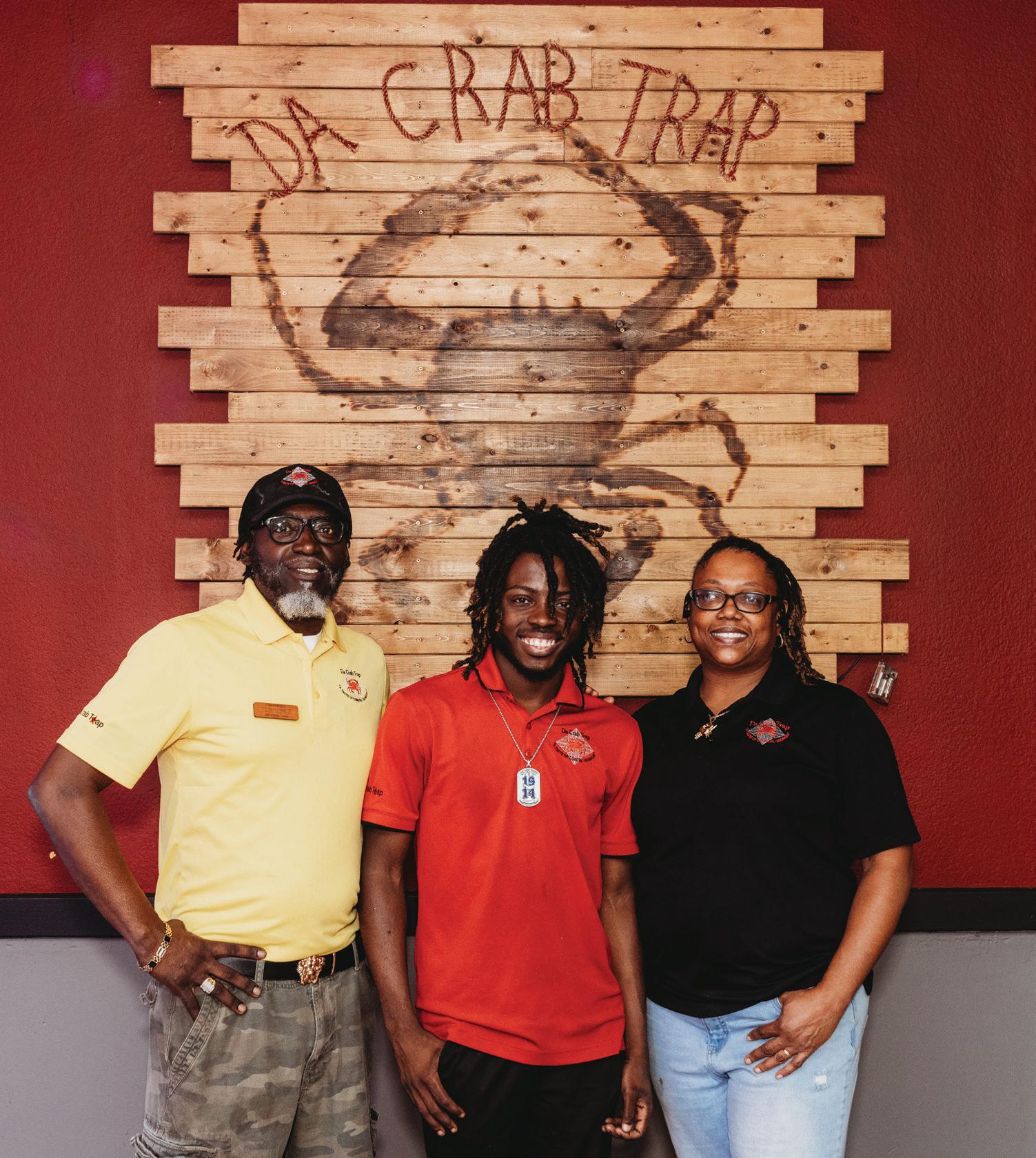
A lively seafood spot in far south Fort Worth serves what the owners call coastal Georgia cuisine
BY MALCOLM MAYHEW
Over the past two years, Fort Worth has seen an influx of restaurants that feature seafood boils — places like Red Claws Crab Shack and Crawlin’ Crab.
While most of these restaurants have styled their food in the vein of Cajun/Louisiana cooking, a newish seafood boil spot called Da Crab Trap is doing something a little different — what the owners call coastal Georgia cuisine.
This upbeat mom-and-pop spot (the couple’s son, Quantavious, works there, too), which opened two years ago in a strip mall in far south Fort Worth, comes

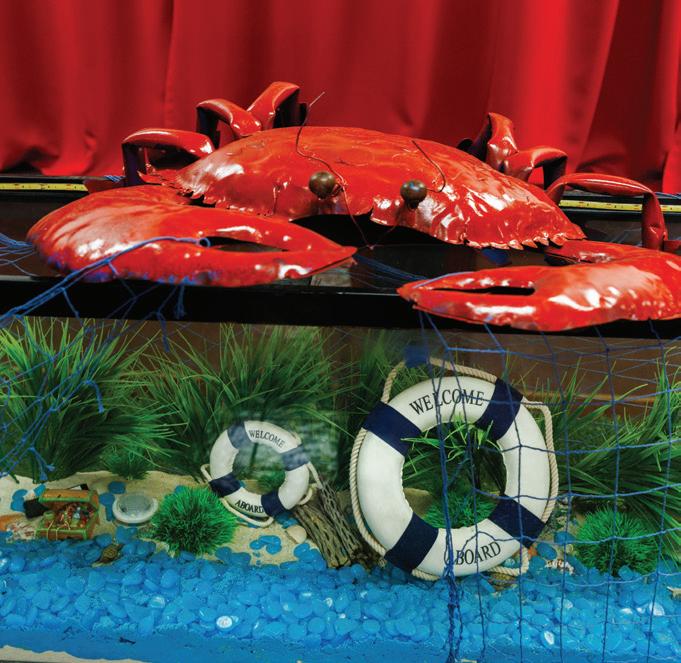
from a mom and pop who certainly know their seafood. Husband-wife owners Daisey and Terrence Shields are self-taught cooks who learned the old-fashioned way — from their families — how to cook shrimp, salmon, and the multiple varieties of crab.
What sets their restaurant apart, they say, is their unique blend of seasoning.
“It’s the seasoning; it’s the presentation,” Terrence says. “What a lot of places do is drown their food in sauce or make the spice level so high, you can’t taste anything. But the calling card of good coastal Georgia cuisine lies within the seasoning. It also has a lot to do with Georgia itself and the people who’ve lived there for generations. This is their food.” The restaurant also offers live entertainment on Saturday nights, from DJs to rappers.


The couple hails from South Georgia, where they were both raised on a steady diet of fresh seafood. “You could go down to the coast and find great crabs, great lobster,” Terrence says. “Florida was only a couple hours away, too, so we grew up surrounded by good seafood.”
When they moved to Texas, they decided to bring their family recipes with them and open a restaurant based on the food they knew and loved as children. They started small, renting out a space in a gas station in Forest Hill. When they continually ran out of food, they knew they were onto something.
Their signature dish is Low Country-inspired seafood boils, made with your choice of jumbo shrimp, salmon, and crab legs or clusters. Extras include sausage, red potatoes, boiled eggs, and corn on the cob. While you can’t go wrong with any of the seafood options, be sure to try the sausage, which is sliced and pan-fried, resulting in expertly blackened, magnificently crispy edges.
Other entrees include Daisey’s unique mac and cheese, filled with shrimp, crab meat, lobster, and Daisey’s secret five-cheese blend; fried seafood baskets; smoked turkey legs; and pineapple bowls. The latter are actual bowls made from pineapples split in two, then carved out and filled with your choice of seafood, sausage, steak or chicken.
“Daisey and I worked together on this recipe,” Terrence says. “Pineapple bowls are nothing new for some people, but for others they are. We knew we’d need to come up with something to make us different, so we took a classic idea and put our own unique spin on it.”
Most dishes come with a side of “trap butter” — an addicting blend of melted butter and various spices. The couple takes their seasonings super seriously, staying mum about what goes into them.
“It’s what makes coastal Georgia cuisine, coastal Georgia cuisine,” Terrence says, laughing. “That’s all I got to say about that!”
Da Crab Trap, 3401 Alta Mesa Blvd., dacrabtrap.com
One of Fort Worth’s most anticipated new restaurants should be open early fall. Calisience, a food truck that draws sell-out crowds for its birria tacos, is set to open a brick-and-mortar location in October at 2707 Race St., just around the corner from where owner Jacqueline Anaya first started cooking. The restaurant is taking over the large space occupied by Dino’s Live. It’s on the same street as La Onda and Tributary Café, two of the city’s most popular restaurants. Along with Birreria y Taqueria Cortez, a food truck that opened its own brickand-mortar recently, Calisience helped usher in a local birria tacos trend. Birria, of course, has been served at restaurants such as Birrieria Los Chivos De Oro for years, but through social media and word of mouth, Calisience brought new attention to a classic Mexican dish. Anaya has also won acclaim for her birria ramen. In addition to her ramen and tacos, she’ll serve street tacos, pasta salad, quesadillas, and her popular strawberry horchata drink, made fresh every day. Additional menu items will be added once the restaurant gets off the ground. calisience.com
The revolving sushi trend has finally come to Fort Worth, courtesy of Akarii Revolving Sushi, which recently opened at 628 Harrold St. between downtown and the West Seventh area. The restaurant offers more than two dozen varieties of sushi, sashimi, and nigiri, all served on a conveyor belt that revolves around the restaurant’s seating area. Grab what you want, make requests via iPads, or order from the regular menu. This is Akarii’s second location. The original opened two years ago in Mansfield. The Fort Worth store was supposed to open soon after Mansfield; the pandemic led to a two-year delay. akariirevolvingsushi.com
I’ve spent much of the past few months worrying that Fiesta Mexican Restaurant had permanently closed. But I breathed a big sigh of relief when their Facebook page lit up with news of a reopening. Whew! One of the very best restaurants in the city, the long-running Mexican restaurant closed for several weeks so owners could address some family issues. It’s one of the city’s oldest Mex/Tex-Mex spots; I’ve been going since I was a kid, when it was still located in a house. I’ll put their freshly made corn tortillas, bean and cheese nachos, and beef chimichangas up against anyone’s. Fight me, Fort Worth! 3233 Hemphill St. facebook. com/FiestaMexicanRestaurantTX

Restaurant news written and compiled by Malcolm Mayhew. You can reach Malcolm at malcolm.mayhew@hotmail. com or on Twitter @foodfortworth.
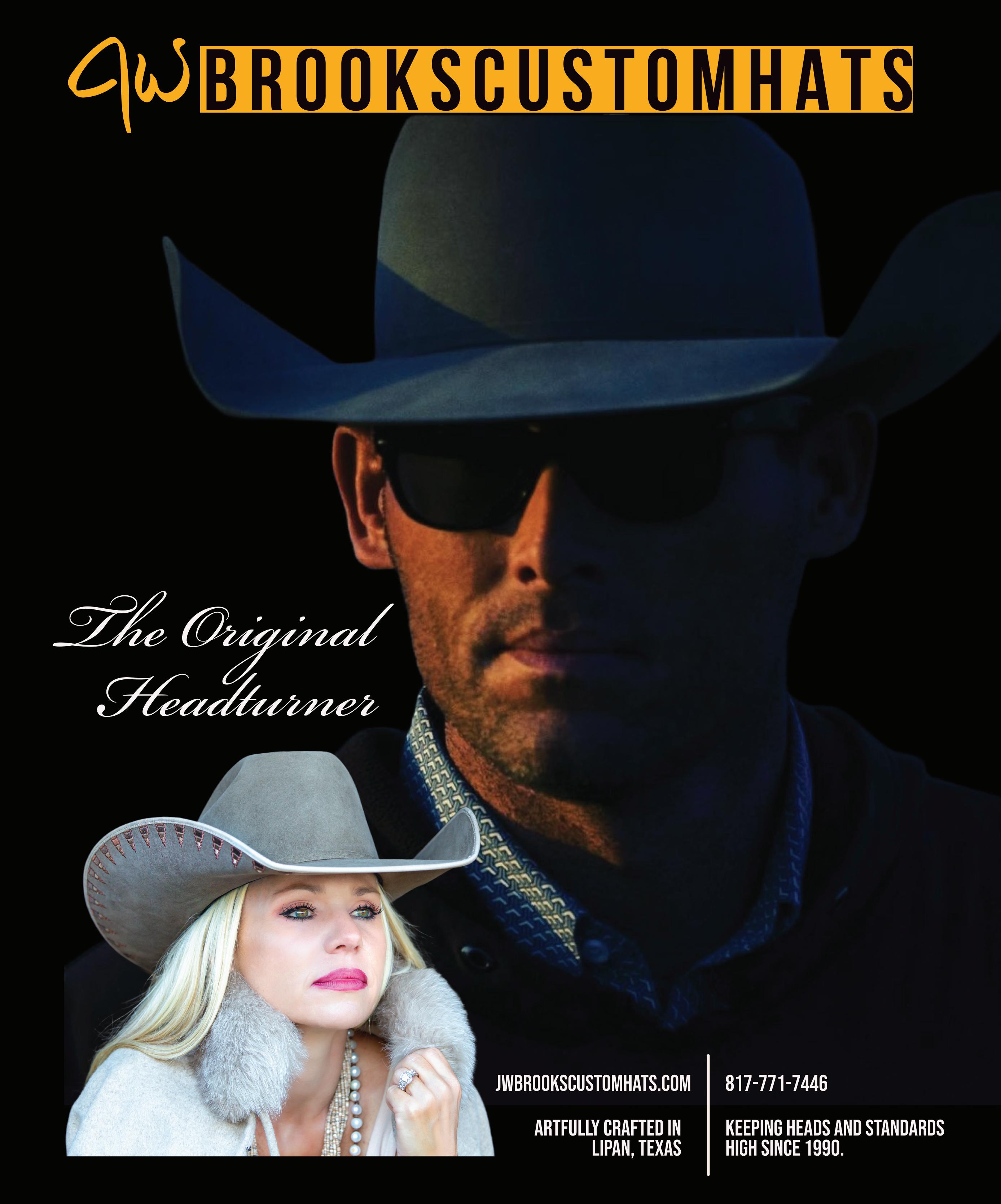






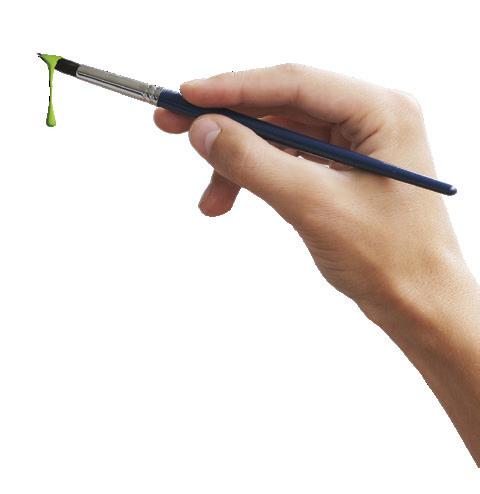




Sure, hats are the perfect combination of practicality and solid fashion. But let’s face it, sporting one is also the coolest dang thing about being a cowboy or cowgirl — or close to the coolest. From the material to molding to manufacturing (and more), this article has everything you ever wanted to know about our favorite item of clothing.
SHILO URBAN
Both beloved and beaten-up, practical yet iconic, the cowboy hat symbolizes the freedom and adventuresome spirit of the American West — and especially Texas (and even more especially, Fort Worth). More so than cowboy boots or even the horse, the hat’s instantly recognizable silhouette goes beyond style to convey a moral code and way of life. This common Western accessory has evolved in fits and starts, shaped by horse-riding cultures throughout history to become the wide-brimmed hat with a high crown that we know today. The Texas horseman rides not alone but alongside Mexican vaqueros, Mongolian warriors, and ancient Greek cavalrymen back into the wild and wooly mists of prehistoric time … and to the dawn of the cowboy hat.
When primitive humans crawled out of their caves, the first article of clothing they invented was most likely the hat, historians say. A large leaf, perhaps, or a stretch of animal hide served as a mobile extension of their cave’s roof, sheltering the face’s vital sensory organs from outdoor elements. Our earliest depiction of a headpiece may reside on the Venus of Willendorf, a bulbous fertility figurine carved 30,000 years ago near modern Vienna, Austria. The hunter-gatherer who crafted the totem topped her head with either braids or a close-fitting cap — it’s up for debate.

wool felt, hwol, has relatives in numerous daughter languages, from Sanskrit to Hittite to Welsh and, of course, in the English wool.
Felted hats had arrived, but what about the brim? Credit for the first known brimmed hat goes to the endlessly inventive ancient Greeks.
their headgear, perhaps the long-lost cousin of the doughboy helmet worn by American soldiers in World War I.
Long before the Allies and Central Powers ravaged the European countryside, however, another army appeared on the horizon: the Mongols. Genghis Khan and his fearsome hordes on horseback conquered the largest contiguous land empire in history, which stretched from Poland to the Pacific Ocean in the 13th century. Much of this terrain was blisteringly cold and windy in the winter, prompting another innovation: the high crown. The Mongols’ hats had tall, conical crowns for extra insulation along with ear flaps and an upturned brim at the front.
Did this pointed crown arrive in Europe with the Mongols, traveling to Spain and the New World to become the Mexican sombrero? Scholars are divided. Maybe it did, or maybe the sombrero was invented anew by mestizo cowboys in Central Mexico. Translated from Spanish as “shadower,” the word sombrero is older than the Mexican headpiece, and several variants exist in southern Spain, such as the sombrero de catite. In any case, the sombrero’s expansive size shadowed the shoulders as well as the head and neck. Its shade was desperately needed by vaqueros working in the fierce Mexican sun, many of whom matriculated north and taught skills to a new breed of horseman: the American cowboy.
Not up for debate: The world’s original horsemen were the Indo-Europeans, who domesticated the animal 6,000 years ago on the grassy steppes north of the Black Sea. A society of warrior-poets, they had herds of cattle and sheep, horse-drawn wagons, and (we think) warm wool hats. They certainly made wool felt, which entails pressing and matting the fibers together into a dense fabric (no weaving required). But it was their innovation of horseback travel that spread their culture far and wide; today, almost half the global population speaks a language derived from Indo-European. Their word for
Called the petasos, it paired a stiff brim with a low crown and chin strap. The messenger god Hermes (Mercury to the Romans) sported a petasos with wings on both sides, as befitted his fleet-footed nature. The patron of herdsmen and shepherds (and a rascally sort himself), Hermes was the overlord of livestock and trails, the same arena that American cowboys would inhabit centuries later. But the god’s sordid past as a cattle rustler (as a one-day-old baby, he stole 50 cows from Apollo) would win him no friends on the Texas range.
No wings decorated the petasos of the average Greek. It was a simple hat of wool, leather, or straw that was commonly worn by people in the countryside, including hunters and farmers. Fancy folks and philosophers in the big cities preferred to keep their heads bare. The hat’s utility was noticed by the Athenian cavalry, who adopted a metal version of the petasos as
If you could travel back in time to the opening of the Chisholm Trail, you’d probably see a few “sombreros” — but you wouldn’t see any cowboy hats. Cowboys and other frontiersmen wore a hodgepodge of headwear, including flat wool caps, old Civil War hats, captain-style caps, slouch hats, coonskins, and even the odd silk stovepipe. Many Westerners were newly arrived immigrants who just wore
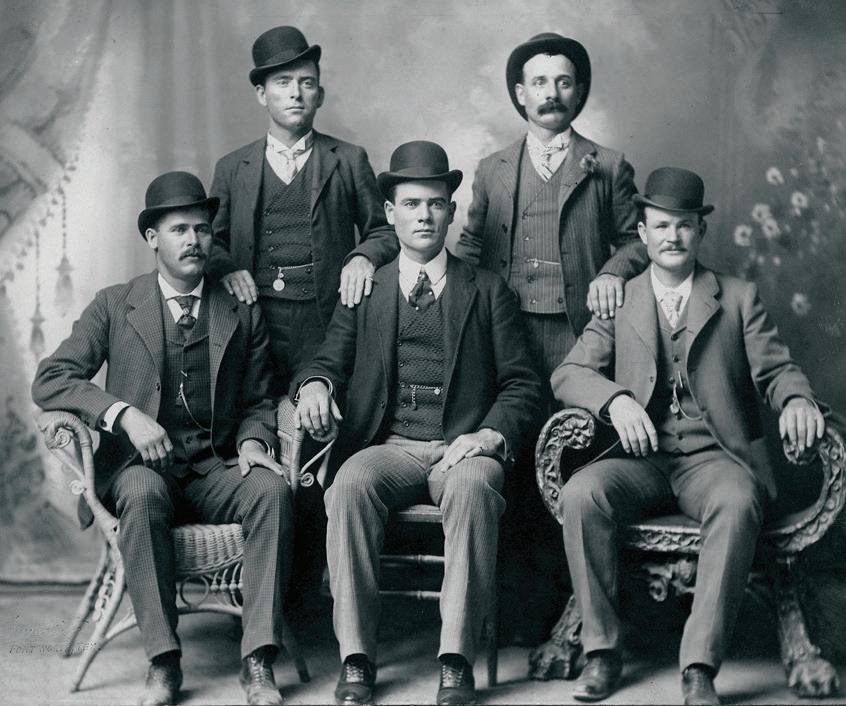
*Be on the lookout for stamps on every page that represent the different shapes
whatever they’d brought on the boat. Most of all, you’d see derbies.
Known as bowler hats in Britain, these hard felt hats have low, bowl-shaped crowns and narrow brims with pencil curls (think Charlie Chaplin and René Magritte). Bowlers were invented in 1850 as a riding hat for an English game warden who was tired of tree branches doffing and damaging his top hat as he scoured the landscape for poachers. The stiff and durable style was destined to become the century’s trendiest headgear and an emblem of the Victorian era. From rich bankers to working schleps, every social class wore the bowler — a modern hat for the modern man (and a few bold women) in a quickly changing world.
Its popularity extended deep into America, where it was renamed the derby. Called “the hat that won the West” by journalist Lucian Beebe, the derby proliferated across the ranches and railyards of the Great Plains. Whether you were driving a herd or poking your head out of a train window, the closefitting hat wouldn’t blow off. Lawmen and outlaws alike wore derbies, including Bat Masterson, Black Bart, and Marion Hedgepeth (aka the Derby Kid). Derbies don the heads of Butch Cassidy, the Sundance Kid, and everyone else in the notorious “Fort Worth Five” photograph, which was snapped at John Swartz’s studio (across the street from today’s Grace restaurant) in 1900. Pinkertons reprinted the image in the gang’s wanted posters, hats and all.
While it has many antecedents, the cowboy hat can be traced back to one man: John B. Stetson. His very name is synonymous with the design. Wikipedia’s “list of hat styles” page includes 134 entries from ascot to zucchetto, and you won’t find cowboy hat among them — but you will find Stetson. Born in 1830 to a New Jersey family of hatmakers, John was the seventh of a dozen children. He learned the skills of making felt and constructing hats alongside his brothers, planning to follow in the family business. Then plans changed. At age 24, Stetson was diagnosed with tuberculosis and not given long to live. He headed to the frontier on the advice of his doctor, hoping the dry air would provide a miracle cure (or at least a little adventure before his days were done). He signed up for a hunting expedition to

Pikes Peak from the trading post of St. Joseph, Missouri, located on the state’s western border. The 600-mile journey to the Rocky Mountains traverses some of the flattest, emptiest, most monotonous countryside in America (still to this day): Kansas and eastern Colorado. The hunting party found no trees, no shade, and no protection from the rolling rainstorms and blazing sun. Their untanned animal skin hats were no match for the climate and rotted quickly. But one of the guide’s straw sombreros sparked an idea for Stetson. He applied his felt-making skills to waterproof beaver pelts, which they had in abundance, and fashioned an unusually wide and tall hat. Like many brilliant inventions, his big hat was initially laughed at by his friends. But they soon came to see its appeal, especially after a passing wagon driver traded a $5 gold piece for it (worth about $90 today).
Stetson had sold his first hat. Even better, his health had returned. He headed back east for a fresh start in Philadelphia in the mid-1860s and opened his own hat business. His first designs mimicked contemporary European styles made of rabbit felt, but his profits barely covered the cost of supplies. When a fur company extended Stetson a week of credit when he was unable to pay, he took it as a sign from God: It was time to start making his Pikes Peak hat. He called it the Boss of the Plains. Lightweight, durable, and waterproof, the beaver-felt Boss of the Plains was designed with the Western working man in mind. It had a broad, flat brim and a high crown with rounded corners, plus an adjustable
hat band for sizing. Inside, Stetson added a sweatband and liner plus a little bow to indicate the back. Prices ranged from $5 for basic models to $30 for the finest beaver fur. Early adopters included the Texas Rangers and General George Custer, who went down in just such a hat during his infamous Last Stand in 1876. For the general public, however, the Boss of the Plains wouldn’t really catch on until the mid-1880s. By the turn of the century — it was everywhere. Cowboys loved the versatile hat, which offered much more than warmth and protection. It was also a cattle prod, a bellows, a drinking vessel, a storage compartment, a fly swatter, and a sleep mask for fireside shut-eye. You could wave the hat to catch the attention of a fellow rider across the range or tilt its brim to shield your face from blowing dust. Beaver felt was lighter than leather, maintained its shape better than straw, and withstood the harsh climate better than rabbit fur. It soon became an indispensable part of the cowboy’s gear.
The only “problem” with the Boss of the Plains stemmed from its rough-and-tumble environment. Beaten up on the trail, its brim gradually began to curl up while its open crown collected creases and dents. But cowboys preferred this distressed look and started curling and creasing their hats on purpose. Much like ripping holes in brandnew jeans today, it was a way to express one’s individuality and rugged, been-theredone-that character. Some geographic areas had their own unique indentations, like flat


crowns in Nevada (now called the telescope or gambler crease). Stetson caught on and began selling new models that already had curves and creases; the Boss of the Plains was slowly morphing into the cowboy hat.
In addition to its functionality, the hat owed its increasing appeal to its most famous fan: William Frederick Cody, known across the planet as Buffalo Bill. The celebrated hunter, soldier, and Pony Express rider dramatized his frontier stories in his hugely successful vaudeville show, “Buffalo Bill’s Wild West,” which ran from 1883 to 1913. Luminaries like Annie Oakley, “Wild Bill” Hickok, Calamity Jane, Geronimo, and Teddy Roosevelt’s Rough Riders appeared on stage with Buffalo Bill, ever the consummate showman. Audiences turned up in droves to watch the sharpshooting, rodeo stunts, and “historical” reenactments of Indian raids and stagecoach robberies. They went home with romanticized ideas of the American West, a wide-open landscape of opportunity and adventure and heroism — and the hero always wore a cowboy hat. A big one. Crowns grew from 3 inches to 7 inches during the early decades of the 1900s, the era when hatmakers like Resistol and American Hat Company opened their doors. Buffalo Bill’s 10-gallon hat, custom designed by Stetson, reflected this upward trend.
“Suddenly that hat became very popular,” says Rodger Chieffalo, who owns Chieffalo Americana boutique on Camp Bowie Boulevard with his wife, Jackie. Chieffalo is Fort Worth’s unofficial cowboy hat historian, a cowboy hat whisperer if you will, who transforms vintage pieces into luxe new accessories while respecting their soul and character. The couple specializes in Amon Carter-style hats, which were born one fateful day in 1920 on the streets of New York City. Chorus: New York City?!
Amon Carter (Fort Worth’s preeminent civic booster) was strolling along in Manhattan wearing his three-piece suit, cowboy boots, and 10-gallon hat — and he was mistaken for a vaudeville performer. “He took that as a personal insult,” says Chieffalo. Carter returned to Fort Worth and sat down with Mr. Peters of Peters Brothers Hats to create a different look. Carter’s new hat had the dimensions of an East Coast fedora, a 3-inch brim with a 5-inch to 6-inch crown, but it
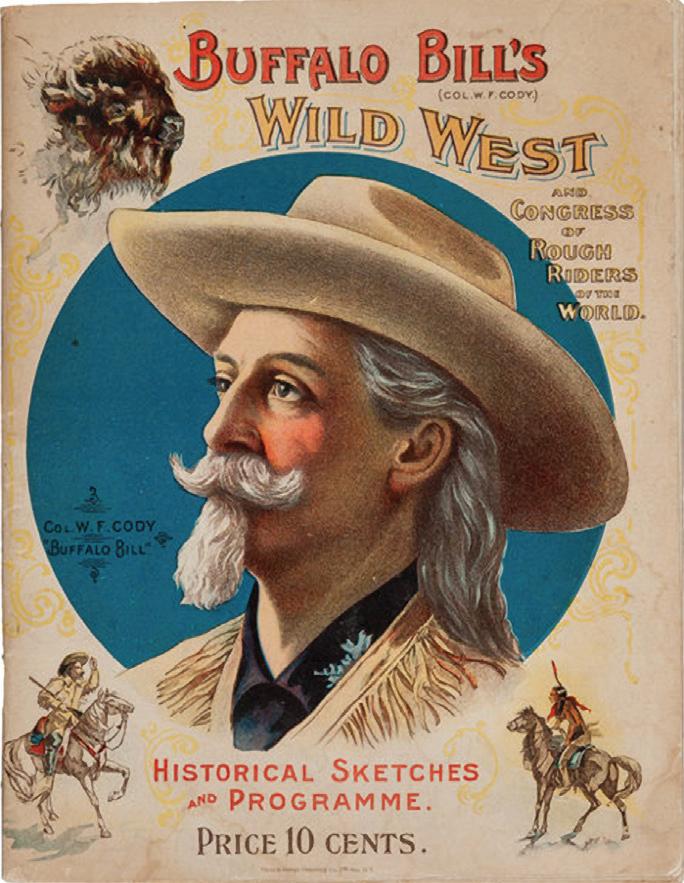
was made with beaver fur. Eastern hats used rabbit felt because it could be dyed multiple colors, unlike the waterproof (and dyerepellant) beaver felt.
“But out West here, hats had a different use,” explains Chieffalo. “They weren’t a fashionable thing; they were a functional thing.” Carter also wanted a thinner hat band and a different crease, something distinctively Fort Worth. He chose the same design that local men were wearing, a sleek, deep indentation in the middle of the crown with two creases on the side. “By Amon doing that, his hat became so popular in that style that they started calling it the Fort Worth crease.”

Carter named his new creation the Shady Oak. “He changed the hat business,” says Chieffalo. “He made a hat that was urban for the Western states. Suddenly, men that lived in cities all up and down the Midwest, from Chicago to San Antonio, they had their own hat style. If you were in a city in the West, you had one of those hats.” Hat shops all over began making the design and giving it their own name: the Open Road, the San Antonio, the Bankers Special, the Cattle Buyer. By the 1940s, most ranch owners were wearing this “cowboy fedora,” not only when they traveled to the city but back on the ranch as well. Their cowhands, however, still wore the big, wide-brimmed hats — they were “all hat and no cattle.”
Then came Hollywood. The cowboy hat reached new heights in the late 1940s and ’50s during the Golden Age of the Western genre. Gene Autry, Roy Rogers, and John Wayne swaggered across the screen in pristine, meticulously creased cowboy
hats, standardizing the style recognized worldwide today. Branded into the public imagination by the lights of the silver screen, the cowboy hat was now enshrined as an icon of the American frontier in humanity’s collective consciousness.
Straw cowboy hats were born in this postwar era, when a new lacquer was invented that stiffened the material so it could hold its creases and shapes. Those in hot climates rejoiced, for a hat was still an indispensable accessory for respectable men and women alike. That all changed in 1961 when John F. Kennedy gave his inauguration speech with a bare head. “People on the East Coast kind of abandoned hats,” explains Chieffalo, “but cowboys didn’t. They couldn’t. Because it’s a functional piece of gear, and everywhere else it’s just a fashion item.”
Cowboy hats would return to mainstream fashion with an exuberant peak during the “Urban Cowboy” craze of the late 1970s and early ’80s. John Travolta went lookin’ for love in all the wrong places (in his Stetson of course) and country music ruled the radio. Everyone from Massachusetts to Malibu started listening to Kenny Rogers, Anne Murray, and the Charlie Daniels Band. The Fort Worth crease was renamed the cattleman’s crease, and cowboy hat factories started operating 24/7 to meet the demand. A new resurgence of cowboy hat chic is underway at the current moment, fueled by the success of the television series “Yellowstone” (whose prequel, “1883,” was partially filmed in Fort Worth). More sophisticated than the purple rhinestones and peacock feathers of the 1980s, today’s look is all about authenticity: local and regional artisans, handmade items, and one-of-a-kind vintage finds (although if purple peacock feathers are your thing, hey — go for it).
Whether felted or straw, sleek for the city or dusty from the ranch, the cowboy hat is eternally linked to the mythic spirit of the American West. It evokes the value system required to survive in the rugged frontier landscape: courage and character, hard work, and self-reliance. As a utilitarian accessory, it speaks to the functionality of humankind’s earliest headwear — yet it retains a powerful hold on the modern imagination. The cowboy hat’s popularity may wax and wane, but the freedom and independence it represents will resonate through history forever.
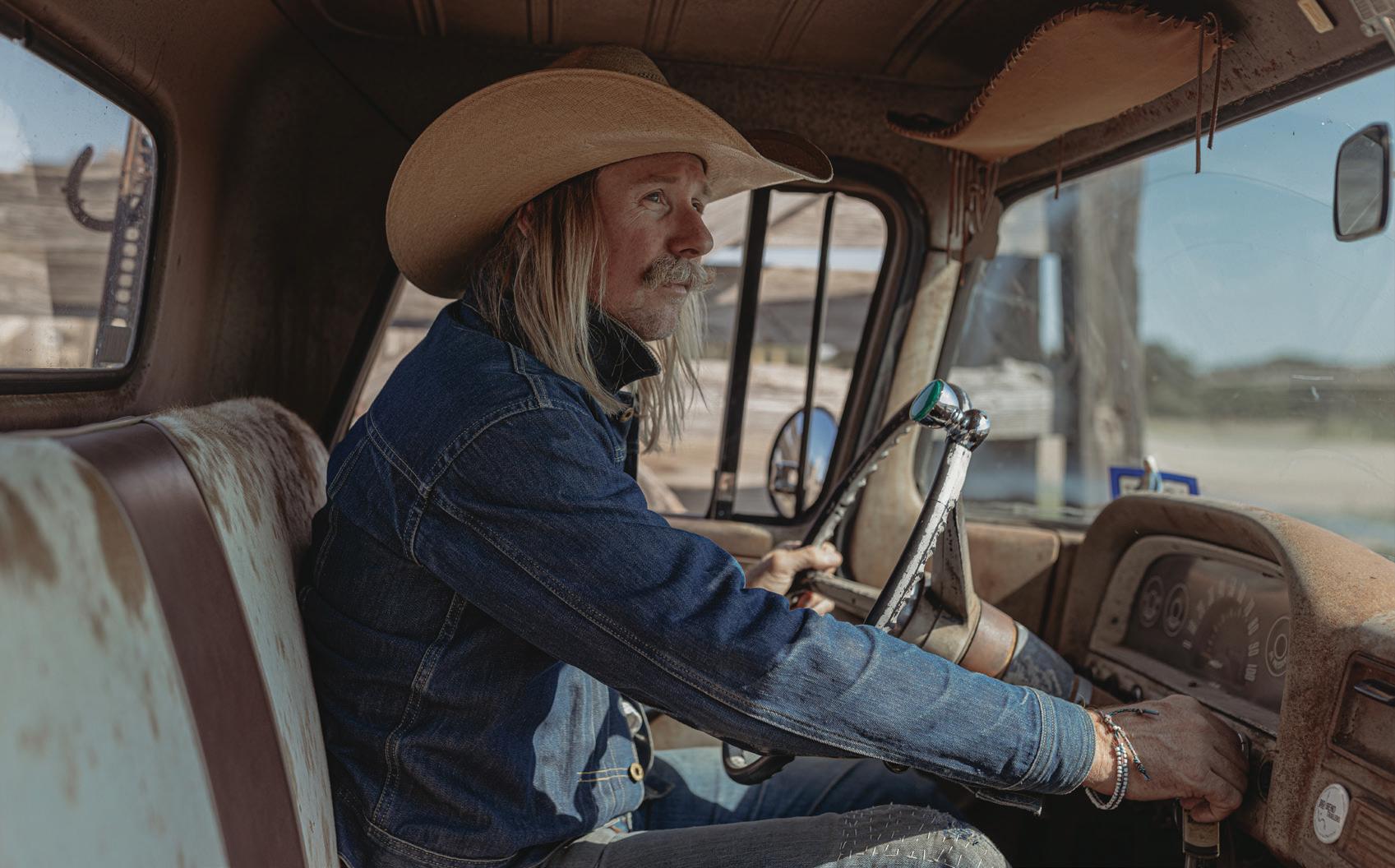
Before Ellis Aldridge bought Coker Hats in the late 1960s, he was a customer, making his first purchase at the store then on Throckmorton Street, part of the property where today sits the Fort Worth Convention Center.
He went in to buy a hat and settled on a 3X beaver, as the suggestion of then-owner Worth Coker.
The hat cost him $15.
“Well, I was looking after some calves, and I was wearing that hat,” he recalls. “And it came a big rain and, poof, that hat just collapsed and flopped around my head.
“I went back down there and asked him, ‘Do you have anything better than this?’ He said, ‘Yeah, a 7X beaver.’ I asked him how much it was, and he said $35. I asked him, ‘Will it do the same thing this one did?’ He assured me it wouldn’t.”
And it didn’t. Moral of the story: Beaver fur is the favored material because the hair interlocks well to create a dense, better weather-resistant material.
Most hats are made of some blend of
beaver, including silver belly, the fur from a beaver’s belly, and rabbit.

Hats are rated through a so-called X-factor system that indicates the percentage of fur used in the hat. Hats are graded on a 1X to 10X scale. Hats between 1X-5X are usually made of more hair — or wool — and a tiny amount of beaver, if any at all.
A 10X hat is 100% beaver.
The problem with the rating system is it’s not standardized. One man’s 5X might be another’s 3X.
One caveat: The more beaver in the hat the deeper you’ll have to reach into your bank account.
RULE 1: Never mess with another man’s hat. The hat is very personal property. Touching another man’s hat can lead to trouble, cowboy. HERE ARE SOME OTHER RULES OF THE RANGE:
When to take your hat off
1. Any time you enter a building or private home. If the occasion is informal, you may put it back on. If it’s a formal occasion, leave it off. Like a coat, the host will probably have a place for you to store it.
2. When sitting down at a table for a meal, unless there is not place to safely store it. If you’re sitting at a counter for a meal, you may keep the hat on. A fast-food restaurant? Keep it on.
3. During the national anthem, Pledge of Allegiance, in church or during prayer. The hat should come off at an indoor wedding or funeral. When in a respectful pose, such as the national anthem, holding your hat over your heart or in your left hand with your right hand over your heart is acceptable.
4. When you are introduced to a woman. If warranted, remove your hat — by the crown — with your left hand so that you may shake her hand with your right. The same rule applies to a man or woman of the cloth.
5. When you begin a conversation with anyone.
NOTE: When removed out of a show of respect, such as for the anthem or an introduction to lady, grasp the hat by the crown and hold it so that the lining doesn’t show.
How to remove your hat
Always remove your hat by the crown. If you need to adjust the hat, do so by the crown.
Cowboy hats are turned upside down, with the hat laying on its brim, when it’s laid down. Setting it down on its brim isn’t good for the crease and cause it to lose shape. A hat stand or coat hook works for temporary storage. Whatever it takes to keep pressure off the brim.
Superstition also is at play.
Never set your hat on the bed. It invites bad luck.
Do’s and Don’ts of Care
How you store the hat will greatly impact the fit and shape. A few tips:
1. Keep it out of the sunlight. The sun will cause fading and ruin the fit, too. Always store inside and in cool areas.
2. If your hat has gotten wet from sweat, rain, or snow, never use heat to speed the drying — it
can damage the hat. If the hat gets soaked, use a hat retainer or stretcher to set the hat to air dry. This will ensure the hat retains its size and shape as it dries and the fibers tighten up. Use a felt hat sponge to remove rain spots.
3. When traveling with the hat — and not wearing it — store in a hat box.
4. Use a hat brush to clean your hat after every wear. Brushes work best on felt but can be used on leather and straw. Start on the left side of the hat and brush counterclockwise so that you’ll brush the crown and brim in the same direction. On the underside of the brim, brush in a clockwise motion.
5. NOTE TO SWEATERS: Pay attention to your sweatband. The acidic bacteria in sweat will gradually eat away at the leather sweatband and cause it to rot. Even if it only gets a little sweaty, always clean away sweat using mild dish soap and a damp cloth. After cleaning, leave the hat on a stretcher so the sweatband doesn’t tighten up.
A general guideline exists: Wear a straw hat from Memorial Day through Labor Day. The reason: comfort. A felt hat is hot in the summer. And so too in the unofficial Texas season of false fall.
Let weather and comfort be your guide for wearing straw on the warmer spring days preceding Memorial Day and the warmer fall days after Labor Day.
Some prefer a leather or suede hat, though those guys probably aren’t working cattle. Those can be worn year-round, if comfortable.
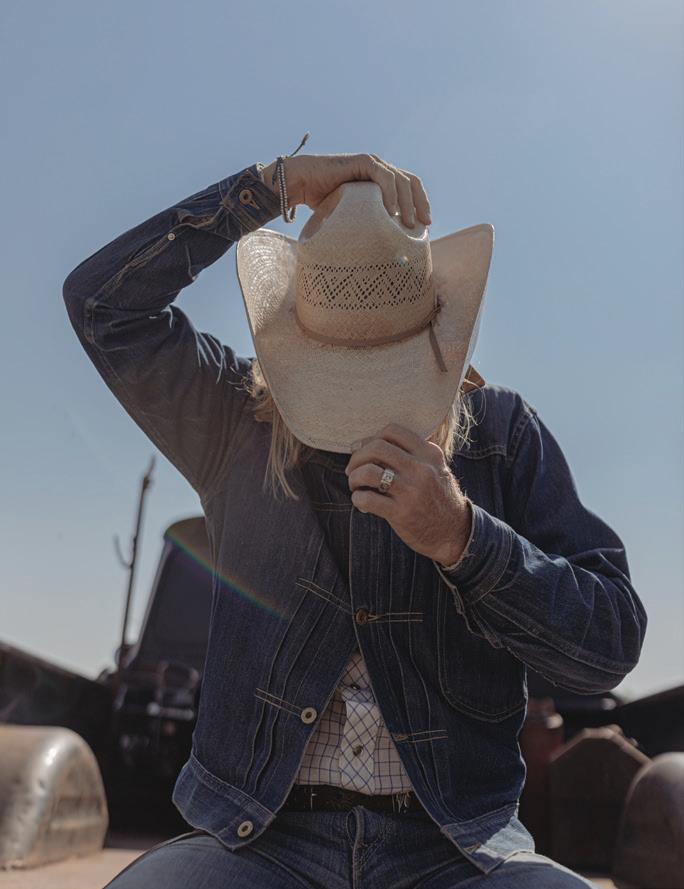
BY SHILO URBAN
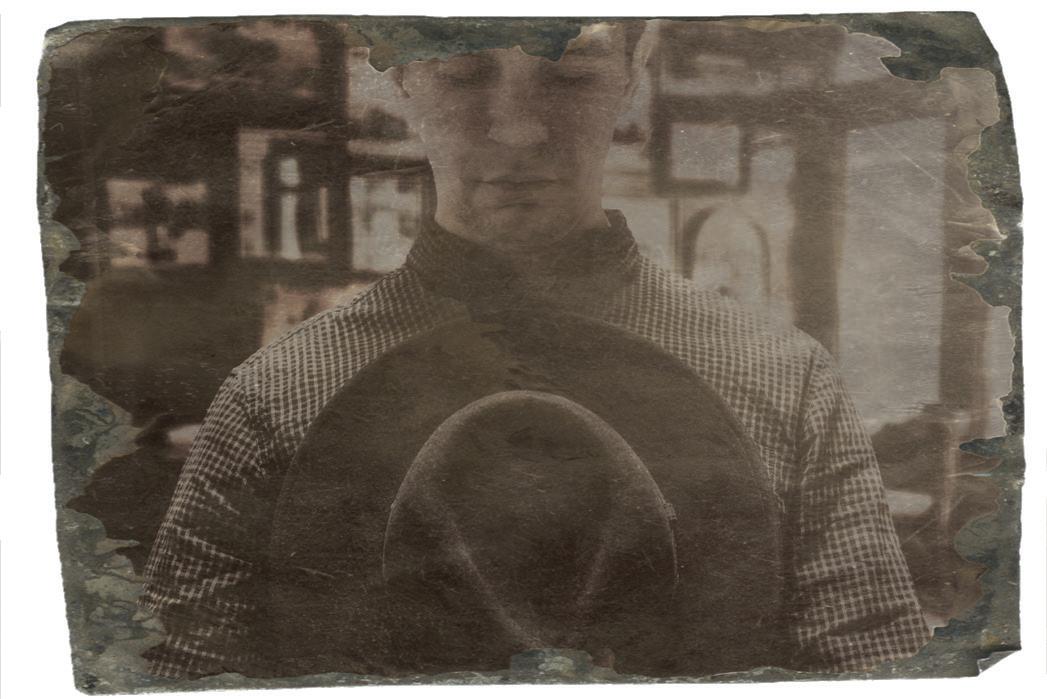
Like many in dangerous professions, cowboys were notoriously superstitious. Stampedes, rustlers, and flash floods were just a few of the perils they faced on a cattle drive. While many cowboys were also quite religious (like rodeo competitors today), it never hurt to hedge your bets — and the more luck you had on your side, the better.
Never set your cowboy hat on a bed, which brings on an argument, bad luck, injury, or even death. The roots of this famous superstition are hotly debated. One theory is that a person’s hat was often placed on top of their coffin, and no one wanted to conjure up that image in their bedroom. Another idea stems from the fact that for centuries, people thought evil spirits lived in your hair. When you take off your hat, they crackle and sometimes spark — and you certainly don’t need those little devils in your bed while you sleep. Today, we know this phenomenon as static electricity, but our ancestors weren’t taking any chances. A more practical explanation is
that those same ancestors had head lice. This was especially true for cowboys, who bathed once a month if they were lucky. Keeping your hat off the bed kept your nits from spreading to others. Whatever the case, should you ever find your cowboy hat on a bed, your only recourse is to spit in it, throw it to the ground, and stomp the bad luck out of it.
Hang your cowboy hat if possible, but if not, set it upside-down on its crown. This keeps your good luck from running out, and it might even catch additional good luck that’s floating around. It also helps to air the hat out and maintain the shape of its brim.
If you’d like to add a snake rattle, feather, or another goodluck talisman to your hat, it goes on the left side. This harkens back to the days of swords and rapiers when you didn’t want anything getting in the way of your dominant fighting arm. The left side is also closer to your heart, and many hat ornaments back then were tokens of love from fair maidens. Don’t wear a new cowboy
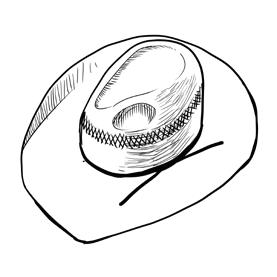

hat (new boots, new clothing, or new gear of any kind) on a hunting trip or when competing in a rodeo. If you’re a rodeo athlete, you’ll also want to avoid wearing yellow, eating chicken before you compete, and carrying change in your pocket (because that might be all you win). And be sure to shave; Lady Luck is not a fan of stubble.
The etiquette of the cowboy hat is almost as iconic as its silhouette. Remove it as a sign of respect during prayer, church, indoor weddings and funerals, the national anthem, and the Pledge of Allegiance. You should also take off your hat when speaking to an elder of the church or meeting a lady for the first time. Mealtime is a little tricky. In general, you should remove your hat in a restaurant unless you’re eating at a counter, at a fast-food joint, or if there’s no safe place to lay it. Tip your hat anytime you’d like to acknowledge and show courtesy to someone.
Keeping your cowboy hat off the bed might be the most popular custom, but the most important one is this: Never mess with another man’s hat. Don’t touch it, don’t ask to try it on, and for God’s sake — don’t take it off him. Purposely knocking off someone’s cowboy hat is a fighting offense. Women, however, have a little leeway. A man who lets a woman wear his hat indicates that he’s interested in seeing more of her — and if she takes it off him, it means that she’d like to take off some of his other attire, too.
No compilation of hat shapes is complete without Fort Worth crossing the mind. And it stands to reason that with Fort Worth’s place in Western culture, it should have a hat shape.
It does: The Fort Worth Crease, widely popular in the current day.
The shape is generally seen on a 3 1/2 -inch brim with a “cow kick” in the front and another in the back.
Another hat synonymous with Fort Worth was Amon Carter’s Shady Oak.
“That whole style of short-brimmed, silver-belly-colored dress hat was invented by Peters Bros. in 1920 at the request of Amon Carter,” says Roger Chieffalo, proprietor of Chieffalo Americana. “The hat became so popular in the ’20s that all the other hatmakers followed suit and made a hat like that.
“By the 1930s it was the most popular hat in America.”
wearing their hats that way,” Chieffalo says. Every celebrity who came to Carter’s Shady Oak Farm received a hat. According to Flemmons, Amon gave away thousands of his hats to visitors. He bought them in such numbers that Hat Life, an industry publication, declared him the “world’s greatest retail hat customer.”
For three decades many of America’s best-known personalities wore nothing but Amon Carter’s Shady Oak hats. Flemmons notes lunch in Los Angeles with a cohort of Patrick Hurley, FDR’s first secretary of defense, Will Rogers, Bernard Baruch, and Cornelius Vanderbilt Whitney.
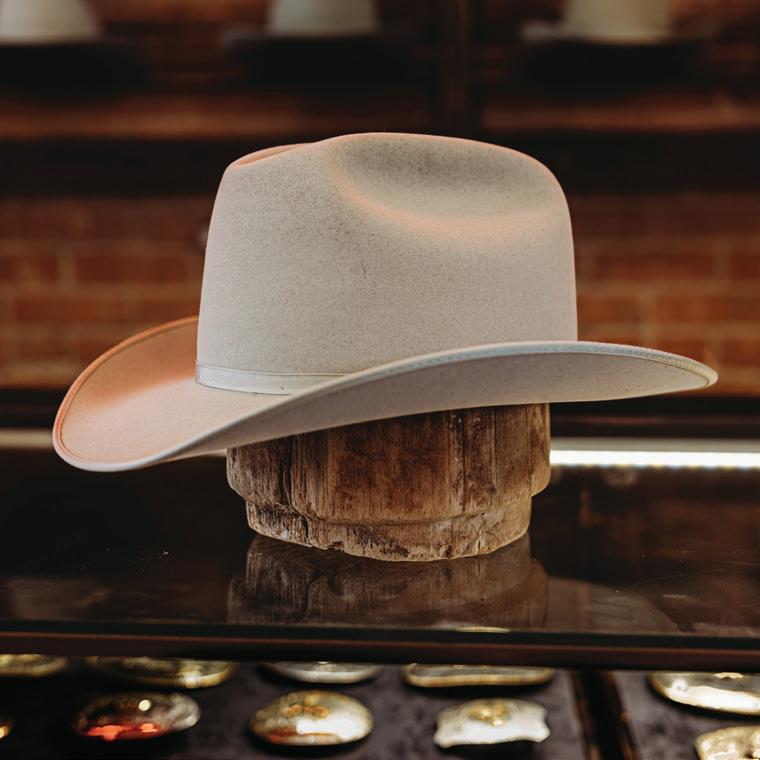
Stetson, with its broader audience, made an exact replica and called it the Open Road, which Lyndon Johnson popularized. Resistol called it the San Antonio.
Carter had been wearing a Tom Mix-style, 7-inch crown and 5-inch brim. Chieffalo recalls the story of when Carter went to New York with that hat he was mistaken for a vaudeville cowboy, and that insulted him.

When he returned to Fort Worth, he sat down with Tom Peters to discuss a hat that would fit in among Eastern fedoras but was Western in style.
Mr. Peters said to Amon, ‘How do you want to shape this hat?’” Chieffalo says.
“He said he wanted it to be distinctively ‘Fort Worth, Texas.’”
Carter’s Shady Oak and the replicas that followed were, Chieffalo says, synonymous with the Cattleman but silver bellied in color and with a shorter crown and brim of 2 2/3 inches, according Amon, the authorized biography written by Jerry Flemmons.
“He made that hat style so popular that cowboys started
Each wore a Shady Oak hat. Borsalino, the Italian hat company that made hats for European heads of state, supplied the hat bodies. They shipped to Peters Bros., who finished the hat and shaped it. Chieffalo says Amon bought so many hats that he became the No. 1 consumer of Borsalino hats in the world. This fact led to an interesting footnote in history. When Amon Carter Jr. was taken prisoner in 1943 during WWII in North Africa, he was initially held in Italy.
Amon sent a note to the head of Borsalino, who knew Mussolini, that asked him to intervene on his son’s behalf and assist with his release.
The head of Borsalino refused the request.
That led to a volcanic Amon, who threw his Borsalinos in the closest dumpster and demanded that Peters Bros. do the same.
“‘I don’t ever want any of my hats made by Borsalino again. I don’t ever want to see a Borsalino in your shop again. Any hats you have for me, get rid of them,’” Chieffalo recalls the story, paraphrasing Amon’s demands.
Chieffalo adds that Amon succeeded in shutting down Borsalino’s operation in Texas.

In 1943, Amon switched to Stetson from that point forward.
Stetson’s hat was a 5-inch crown and 2 3/4-inch brim.
But that was OK with Amon.
A NEW HAT, WITHOUT ANY CREASES OR BENDS, IS A BLANK CANVAS FOR A HAT SHAPER. THEY’LL TAKE A BORING FLAT BRIM AND ROUND CROWN AND CREATE A WORK OF ART — A MASTERPIECE. BY
BRIAN KENDALL, PHOTOS
BY
CRYSTAL WISE
You see, a cowboy hat doesn’t come out of the factory looking like it belongs on the head of John Wayne. Someone has to fashion it to look that way. All hats are, at first, basic models — no bells and whistles attached. A hat shaper, using the art of creasing and folding, is the one who customizes it.

The city’s preeminent hat shaper is a hard-fought title in a place like Fort Worth. Beswt Hat Store, alone, which sells in the neighborhood of 20,000 hats a year (that’s a lot of shaping), has eight legitimate contenders for the title. But, with over 20 years of experience shaping hats, it’s hard not to give the title to Danny Adams. Any Fort Worthian who’s purchased multiple hats has undoubtedly had an interaction with Danny. His knowledge, wit, and mustache are unmistakable and the reasons he’s become a city staple.
The Process: 1 2 3 4
TIP: Don’t overthink it. Just do what you like.
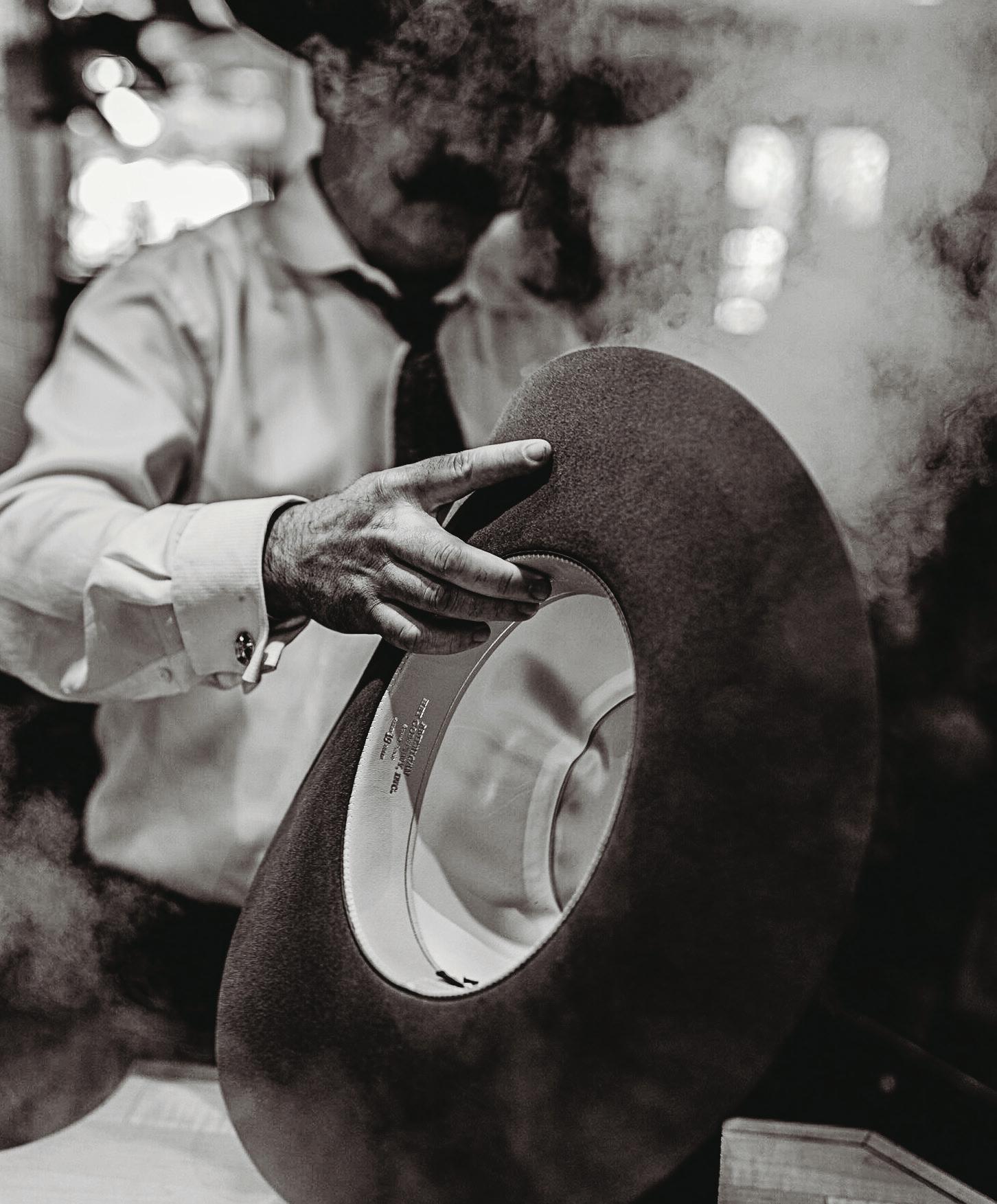
1. The hat shaper will first size up the person. Is their jaw round, square, or practically nonexistent? Is their face wide or narrow? Based on these traits, the hat shaper will know how to properly crease a hat to conform to the person’s face. It’s not about the cut but how they can make that cut look best on you.
2. Not everybody’s head is shaped the same, and not everyone’s head has the same, well, straightness. The shaper will next have the person put the hat on to see how it rests on their head. A major part of shaping is to make sure the hat appears straight on a person’s head.
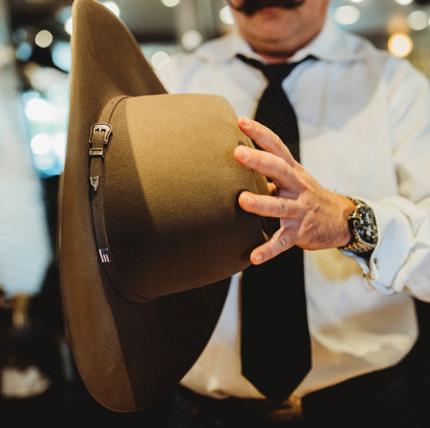

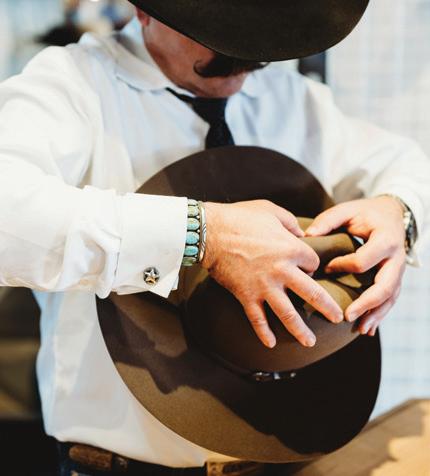

3. The hat shaper uses a pedal-activated steam machine that pushes steam out at 60 pounds of pressure and gets upward of 400 degrees. Waving the hat over the steam, the crown and brim will become malleable once it hits a certain temperature.
4. The shaper will have a handful of seconds before the hat cools down. During this time, he or she will begin creasing and folding the hat with their hands. They do this gently, careful not to put too much pressure on the hat, and with precision. This process can take up to 15 minutes as they communicate with the customer to ensure they’re getting what they want.
BY BRIAN KENDALL
When Hollywood was tasked with portraying the wild west on film, no costume decision was more important than that of the hat. Black, brown, large, small, clean, dirty, round crown, pinched crown, etc. The hat was a garment that had to portray the personality of the character and, in many cases, would become ubiquitous with the actors themselves.
SOME OF THE EARLIEST COWBOY HATS SEEN IN FILMS, SUCH AS TOM MIX’S FAMOUS 10-GALLON TAN FELT HAT, WERE FAR FROM HISTORICALLY ACCURATE.
While most cowboy hats today have a 6-inch crown, the crowns of Mix’s hats were customized to exaggerated heights, and their pristine appearance may appear to modern audiences like something ripe for a screwball comedy. However, filmgoers in the 1920s had little frame of reference — films and the Western genre were just kicking off — so the tall crown became a popular, if inaccurate, cowboy hat.
John Wayne often wore a taller crown, such as his iconic portrayal of Liberty Valance in “The Man Who Shot Liberty Valance.” In this film, the Duke is sporting a Montana Pinch.
• Tom Mix
• Roy Rogers
• Hopalong Cassidy, as portrayed by William Boyd
• Liberty Valance, as portrayed by John Wayne in “The Man Who Shot Liberty Valance”


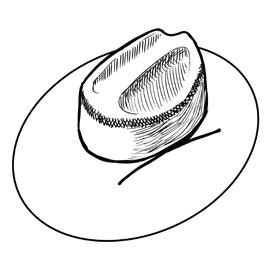
THE MOST HISTORICALLY ACCURATE DEPICTION OF COWBOY HATS IN HOLLYWOOD WILL BE IF CHARACTERS ARE WEARING THE ROUND CROWN AND SHORT BRIM STYLE OF THE DERBY. Yet, most directors prefer to ignore historical accuracy in favor of putting their hero in a hat that would be more palatable to a modern audience. Ultimately, the derby had utilitarian purposes, as it easily stayed on the head through windy conditions while riding a horse. However, in film, characters wearing a derby were often portrayed as city-dwelling intellectuals or, in the case of Bat Masterson, sophisticated yet unassuming gunslingers.
• Bat Masterson, as portrayed by Gene Barry in “Bat Masterson”
• W.W. Beachamp, as portrayed by Saul Rubinek in “Unforgiven”
• Calamity Jane
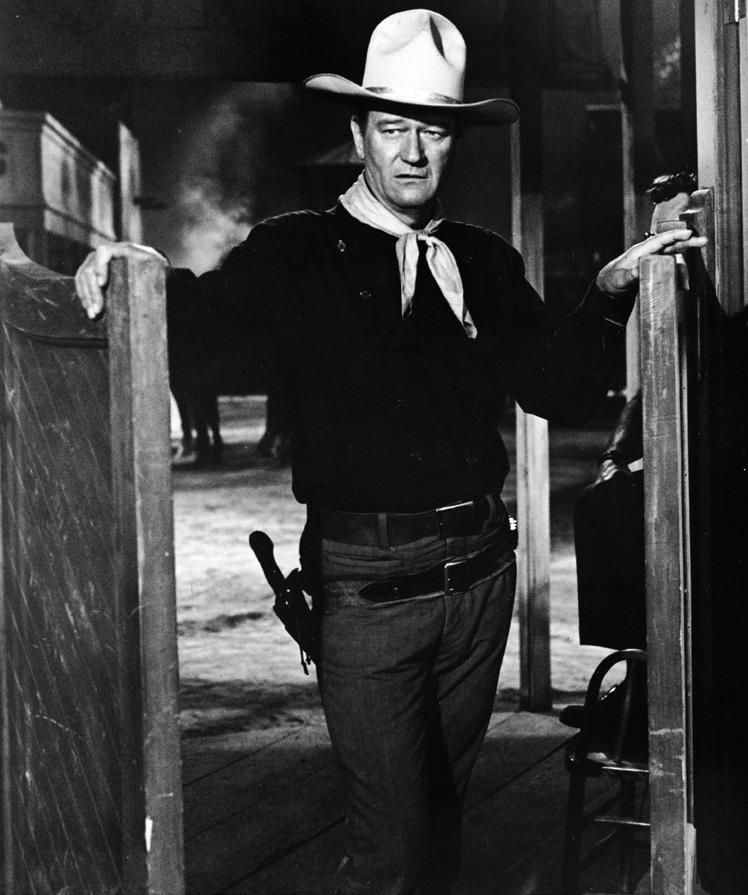

AFTER YEARS OF WEAR AND TEAR, A HAT WILL BEGIN TO TAKE ITS SHAPE AND CONFORM TO THE DEMANDS ONE PUTS ON IT. The brim will naturally bend, and a pinch will naturally occur in the crown where one puts it on and off. Of course, in Hollywood, many of these hats had to be forcibly distressed. This gave the hat a “worn” look, and the characters who donned them were often portrayed as untamed, rebellious, and workman-like.
• Lin McAdam, as portrayed by Jimmy Stewart in “Winchester 73”
• Dude, as portrayed by Dean Martin in “El Dorado”
• Vin Tanner, as portrayed by Steve McQueen in “The Magnificent 7”

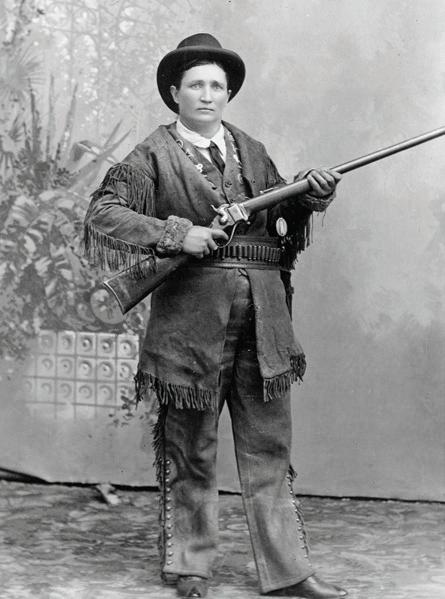

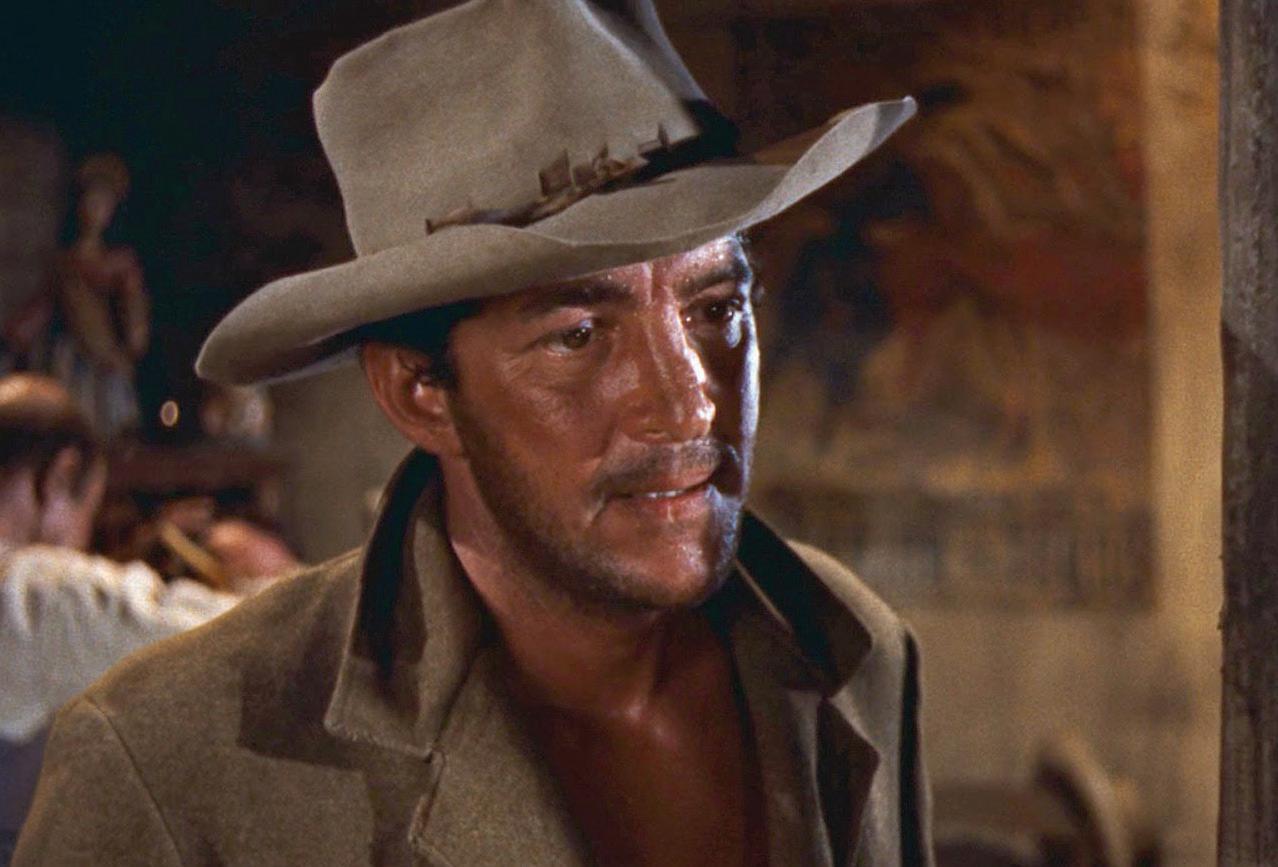

Telescope
WHILE TODAY’S AUDIENCE MIGHT ASSOCIATE THE TELESCOPE STYLE WITH BREAKING BAD’S WALTER WHITE, IT WAS ONCE ONE OF THE MOST POPULAR DEPICTIONS OF THE COWBOY HAT IN HOLLYWOOD. This is somewhat ironic, as, initially, its functionality outweighed its fashion; it was built for hard labor in the sun. However, some actors (or costume departments) put their own spin on the classic style. You might notice that Lee Van Cleef’s Angel Eyes has a wider brim than the standard telescope.
• Angel Eyes, as portrayed by Lee Van Cleef in “The Good, the Bad and the Ugly”
• Butch Cassidy, as portrayed by Paul Newman in “Butch Cassidy and the Sundance Kid”
• Blondie, as portrayed by Clint Eastwood in “The Good, the Bad and the Ugly”
• Marshal Will Kane, as portrayed by Gary Cooper in “High Noon”
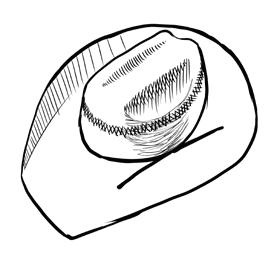
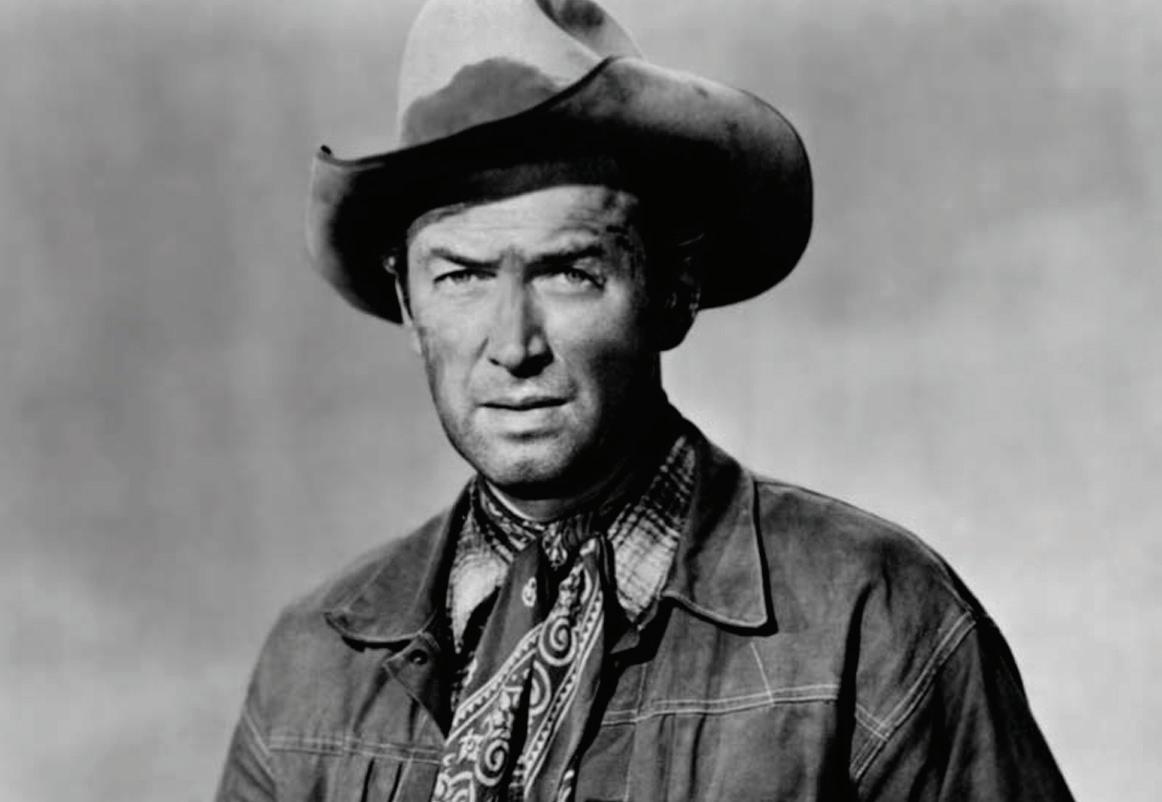
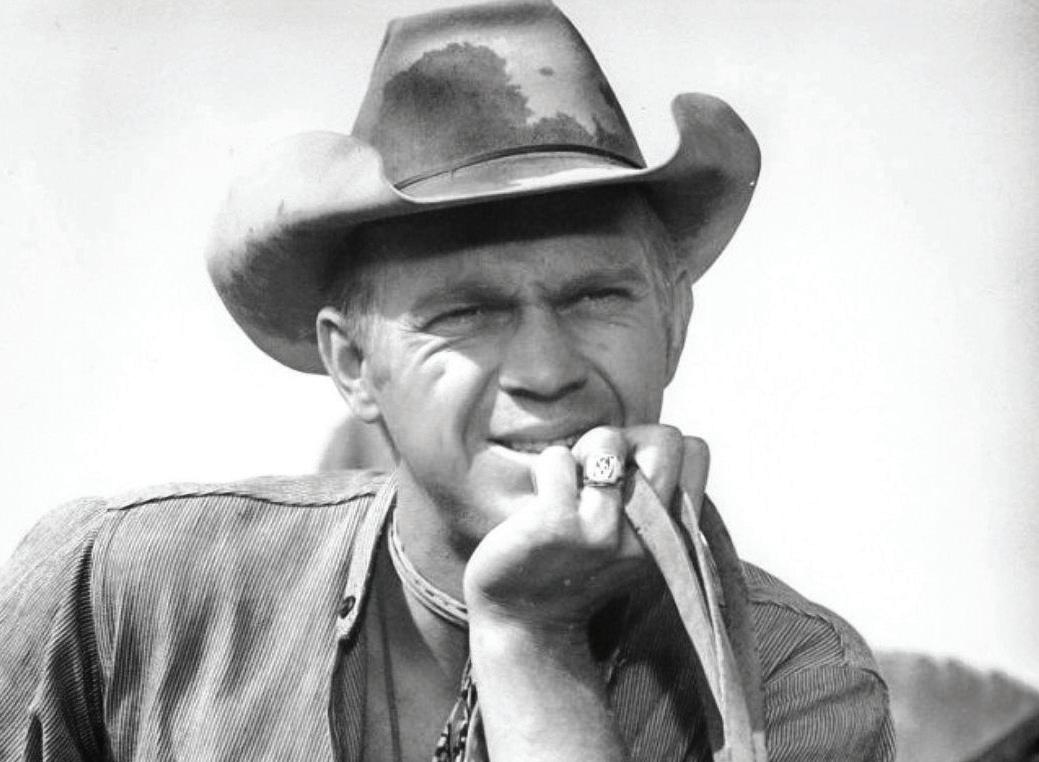


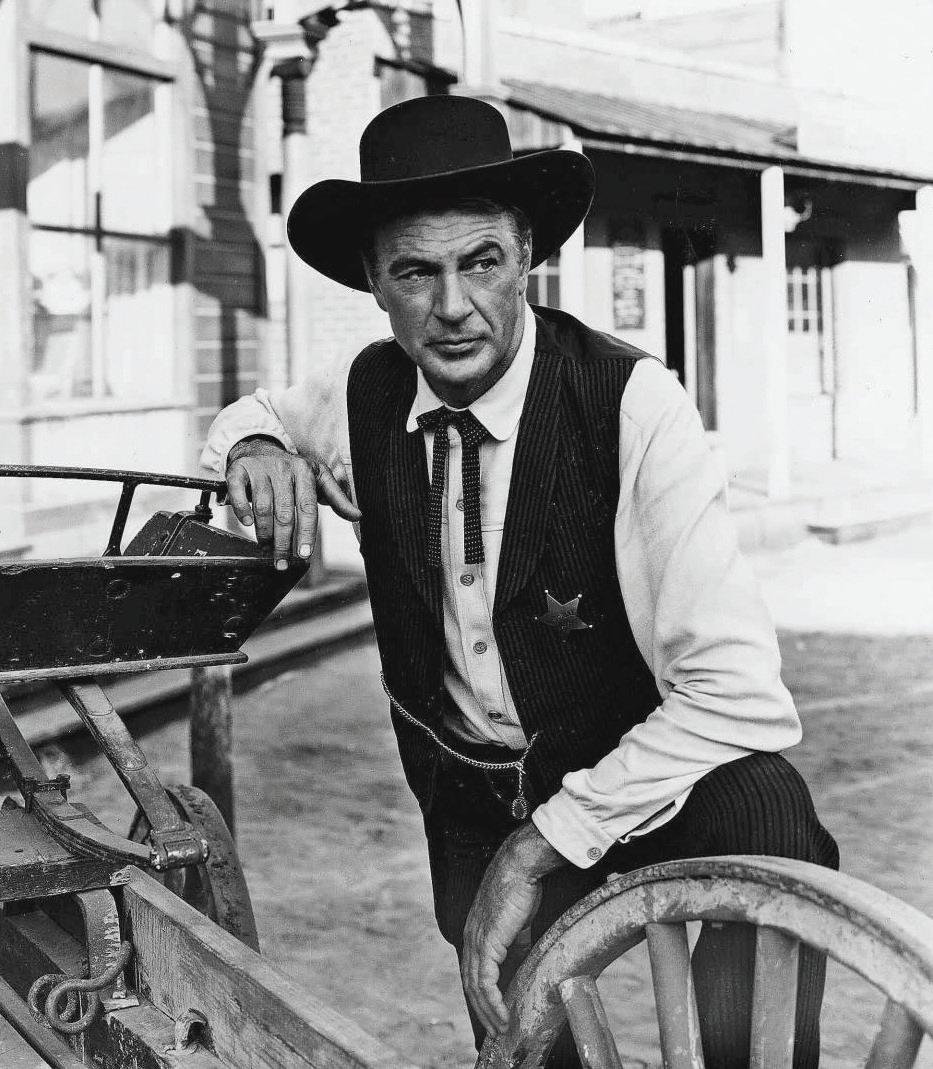

MANUFACTURERS
Alan’s Lids
606 W. Cleburne Road, Ste. 220, Crowley 817.9880927 alanslids.com
American Hat Company
1.800.392.4197 americanhat.net
Jobe’s Hats
4200 South Freeway, Ste. 1043 817.823.9485 jobeshats.com
J.W. Brooks Custom Hats
510 Natty Flat Road, Lipan 817.771.7446 jwbrookscustomhats. com
Peters Brothers Hats 909 Houston St. 817.335.1715 pbhats.com
Resistol
601 Marion Drive, Garland 972.494.0511 resistol.com

BY BRIAN KENDALL, PHOTOS CRYSTAL WISE
The construction of a good cowboy hat isn’t done in the assembly line of a Detroit factory. No ma’am. A good hat, one that’ll last a lifetime, is carefully crafted by the hands of those who work at places like Capital Hatters in Stephenville. While their process is more detailed than below, this’ll give you an idea of what it takes to build a hat. No software programs necessary.

MERCHANTS
The Best Hat Store 2739 N Main St. 817.625.6650 besthatstore.com
Cavender’s 5600 S.W. Loop 820 817.989-2887 cavenders.com
Maverick 100 E. Exchange Ave. 817.626-1129 maverickwesternwear. com
M.L. Leddy’s 2455 N Main St. 817.624.3149 leddys.com
Teskey’s 3001 W, I-20, Weatherford 817.599.3400 teskeys.com
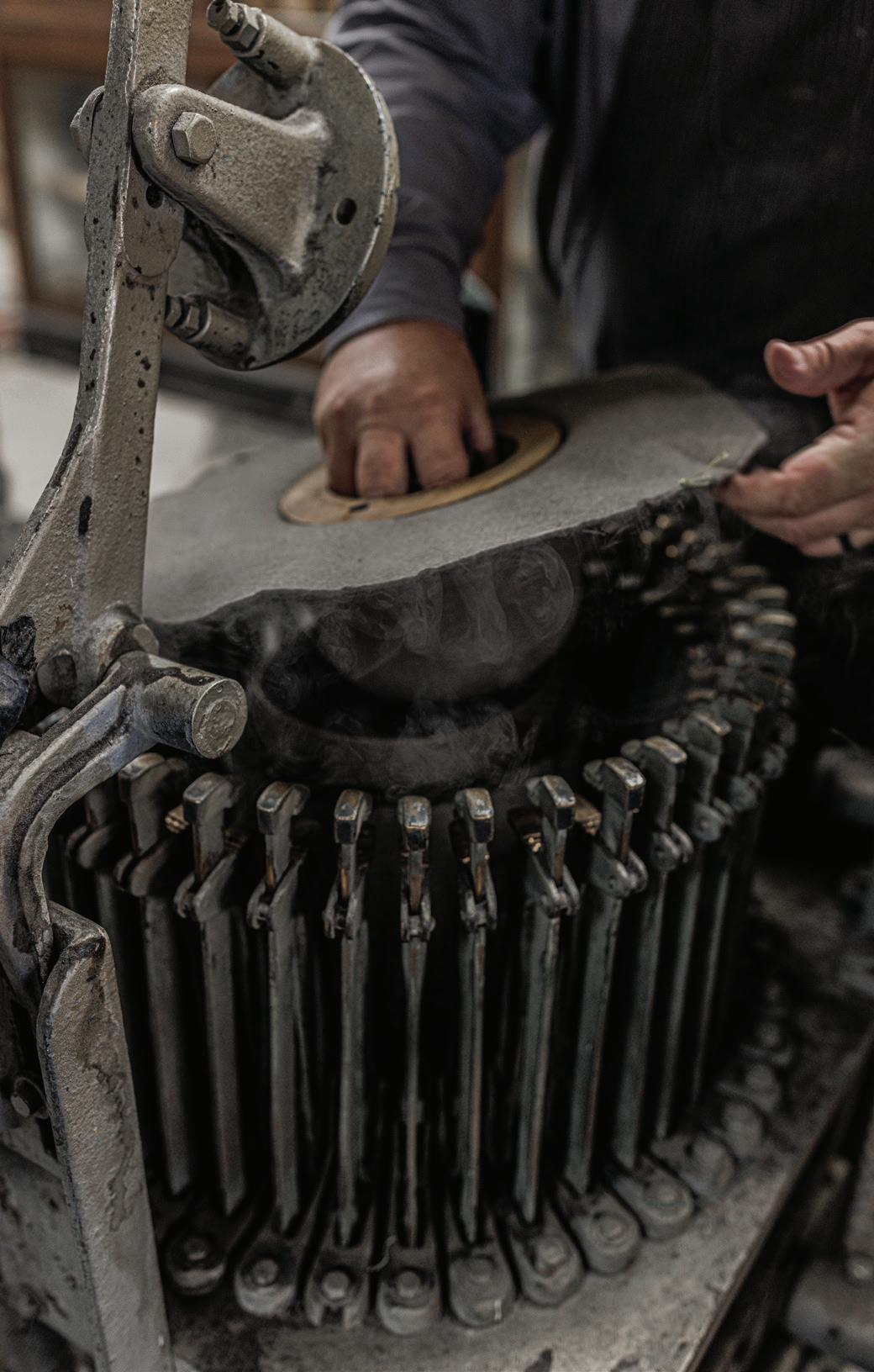
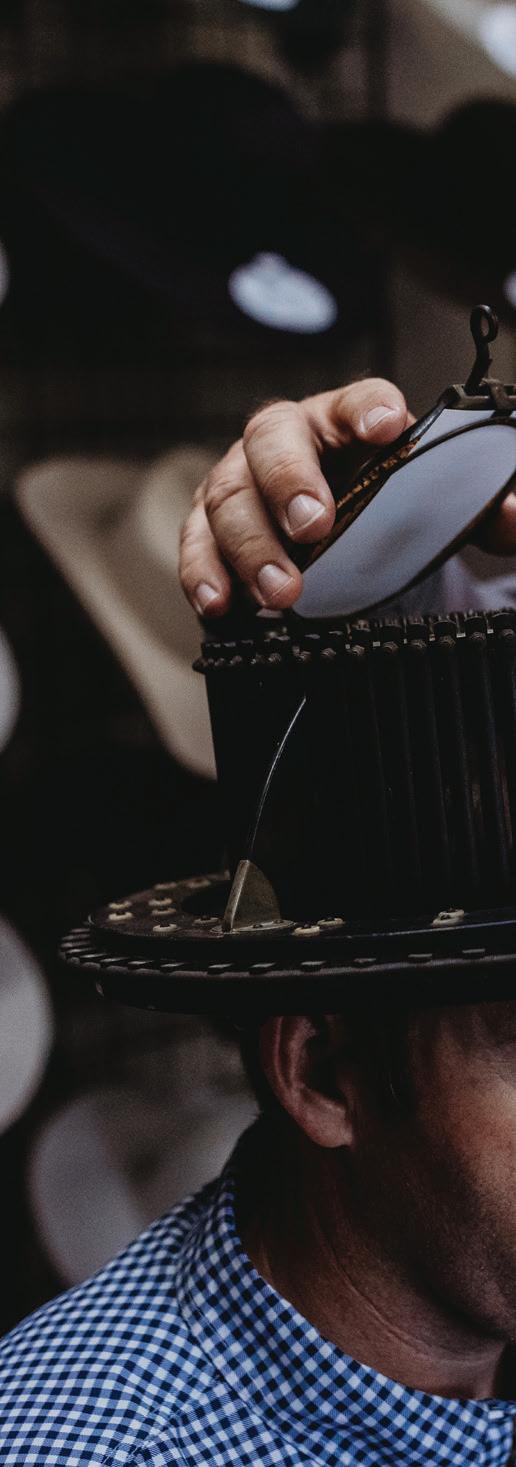

4
TEXTURE: To achieve the desired texture, Capital Hatters uses sanders and crown irons — and go back and forth between the two. This process is also called pounding.
2 MOLD: One will then pick a wooden block that matches the correct dimensions produced by the conformateur. In addition to head sizes, these blocks also serve as molds for crown heights and taper of the crowns. The customer will pick the one they like best.
3
FORM: The hat maker will then place the felt — usually made from beaver fur, rabbit fur, or some combination — over the wooden mold and place both in a blocking machine. These machines let out a large cloud steam onto the felt that allows it to form around the wooden mold.
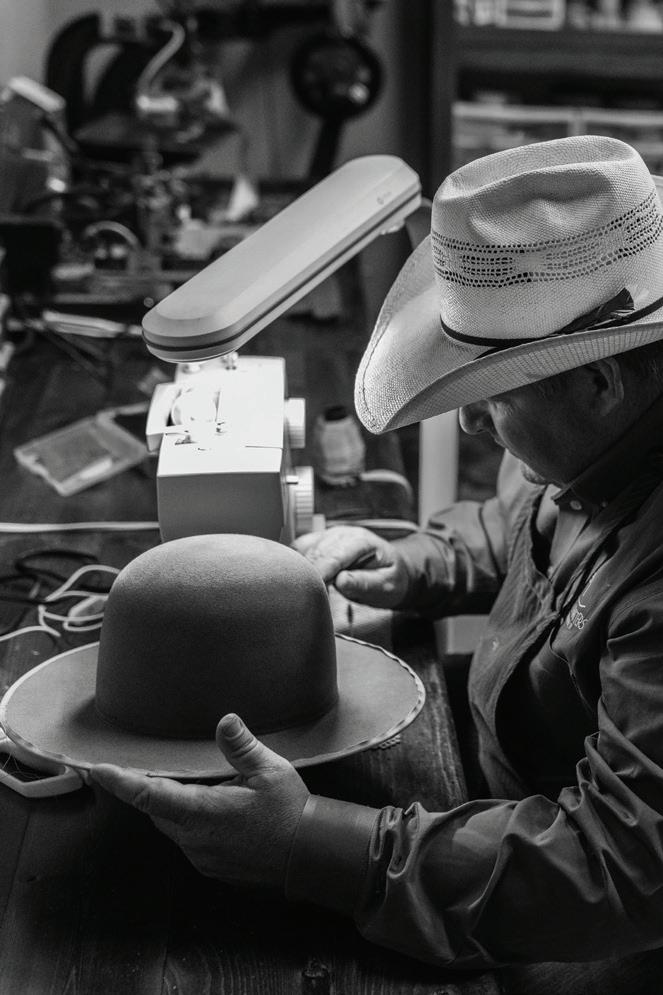

1MEASURE: The gadget that resembles a torture device from the 1800s is called a conformateur — a French-designed tool that measures the shape and size of your head. It doesn’t round up or down; these are your head’s exact dimensions — warts and all.




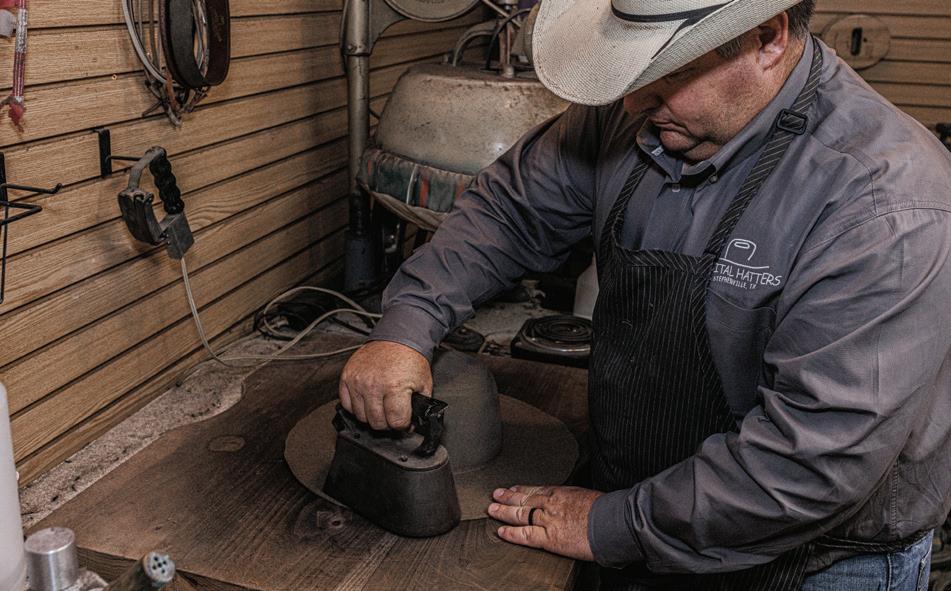

5 PRESS: The hat will then go into a brim press — what looks like a red kiln. As the name of the machine may suggest, this presses the brim of the hat, flattening and leveling it.


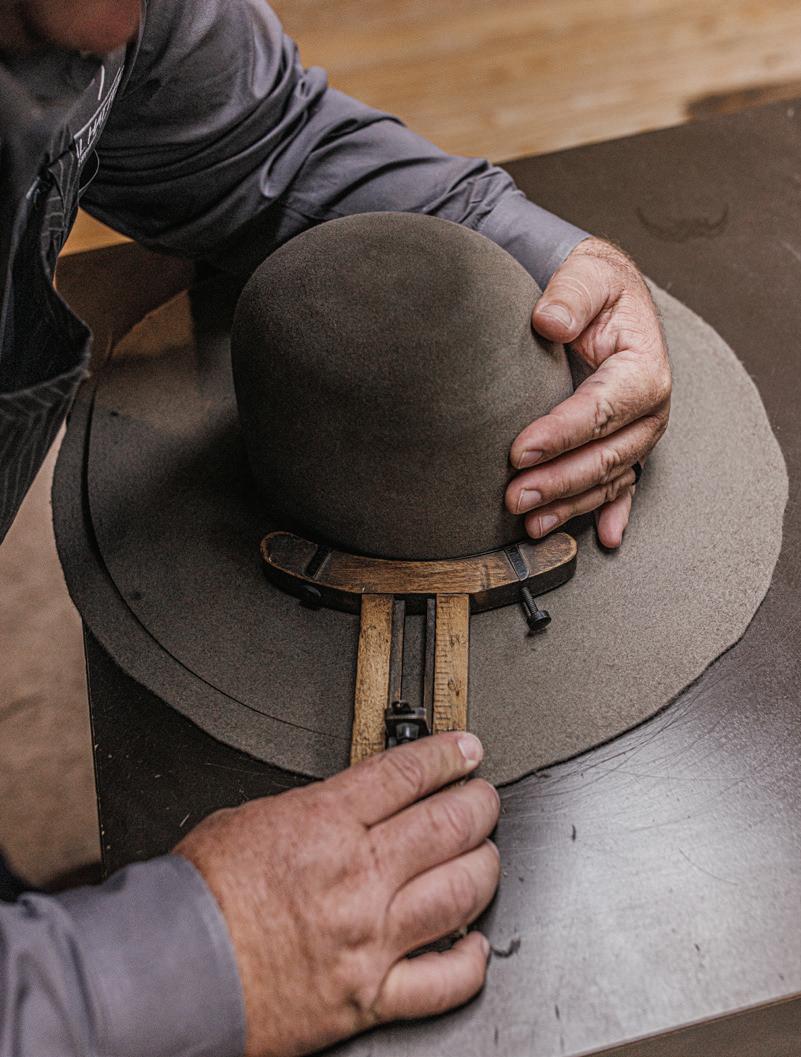
6
CUT: The next step is cutting the brim, which is done with a rounding jack. Like a compass one would use in school, this ensures a perfectly circular brim. Any leftover felt is used for hatband.
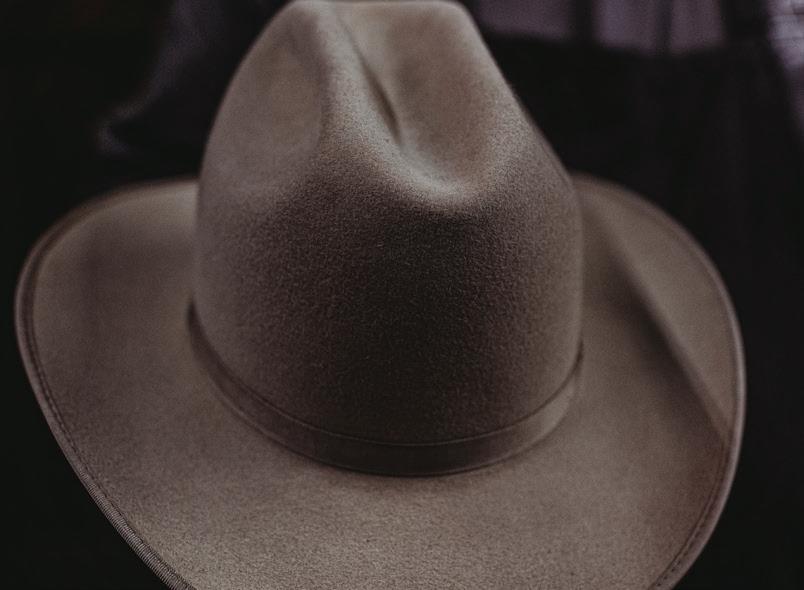
7
SEW: In the finishing room, the hat maker will put on the final touches: sewing in the leather sweat band, put in the liner, and put on the outside band.

WHITE ELEPHANT HONORS THE COWBOY HAT, WEARERS IN HALL-OF-FAME WALL, CEILING DISPLAY BY
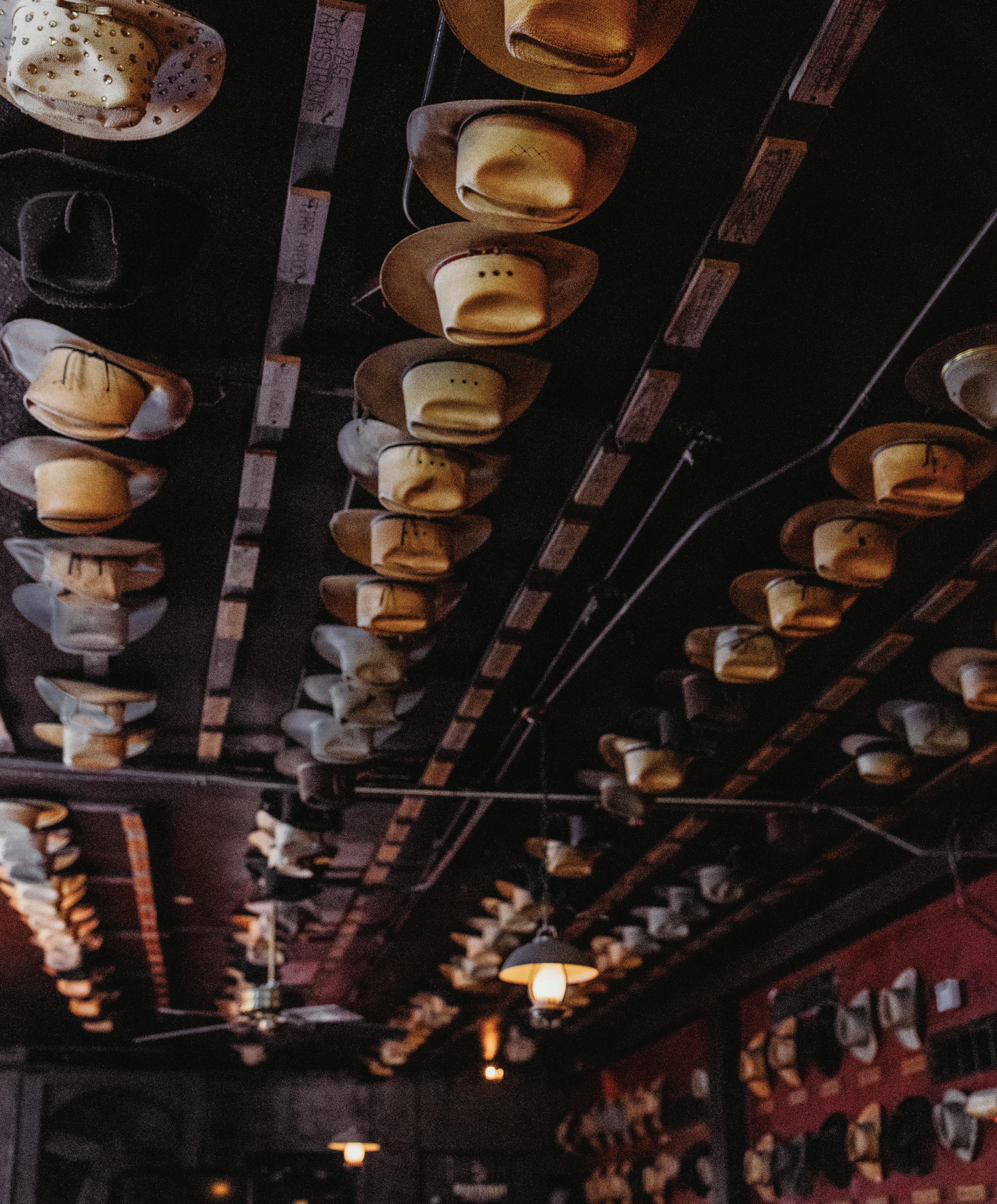

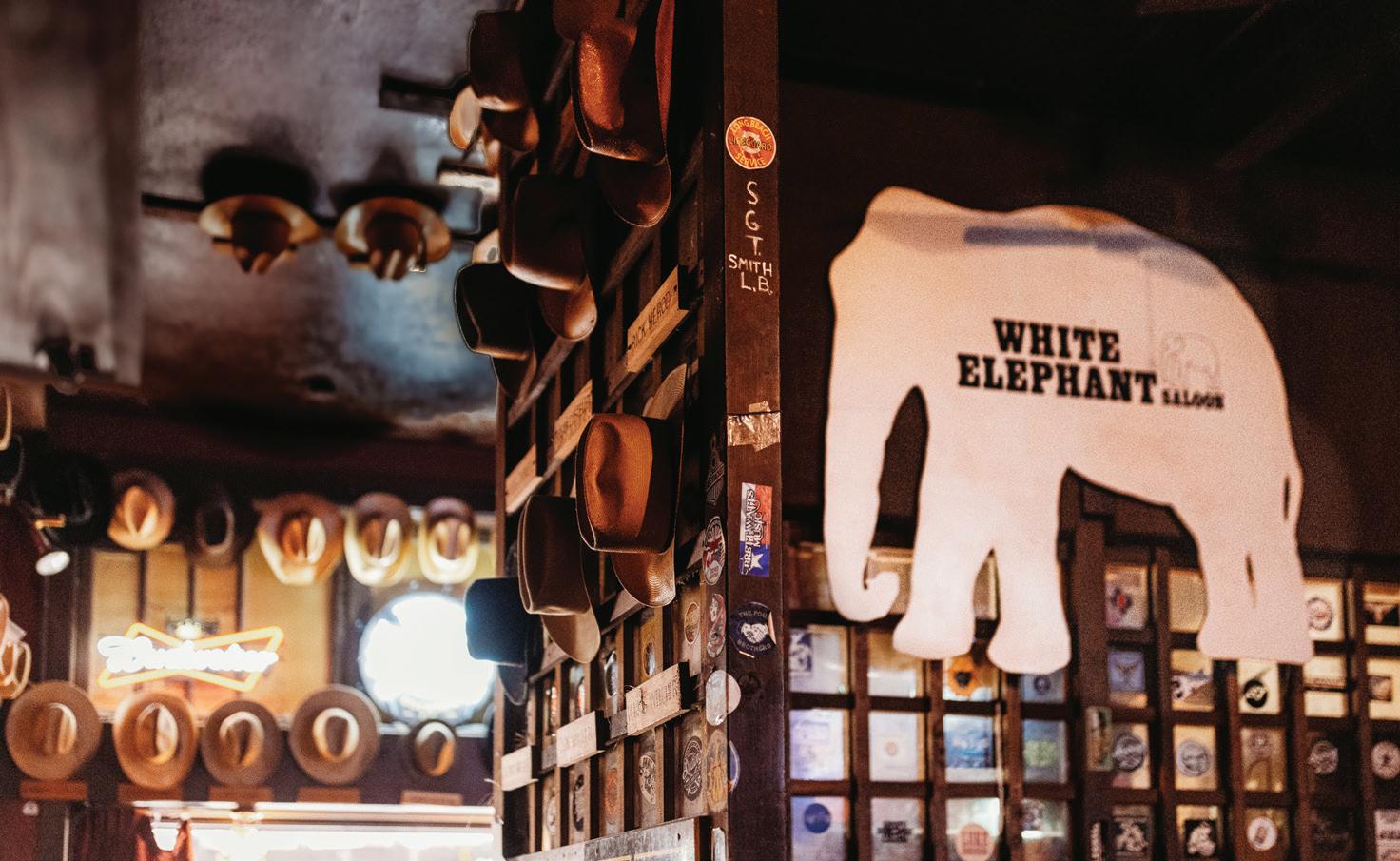
The White Elephant Saloon has carved out a place of distinctive excellence in identifying as something out of an Old West drama.
I’ve spent many an afternoon down there in this Stockyards dive. Today, really, it’s an institution. However, never once have I witnessed two fellers setting parameters to settle a disagreement over, say, a card game.
A: I mean to kill you in one minute, Ned, or see you hang downtown at Judge Gallagher’s convenience. Which shall it be?
B: I call that bold talk for a one-eyed fat man.
A: Fill your hands, you son-of-a-bitch!
None of that. The closest you’ll get to John Wayne is the museum down the street.
The second iteration of the White Elephant has more in common with a tourist attraction than the original version, located in downtown, which hosted cowhands and gamblers, not the mostly international tourists flashing American Express that we see today. (Well, at least during the day drinking hours.)
Not that there’s anything wrong with that. The purveyors of spirits prefer the pacifist to the fist of liquid courage.
The first White Elephant is the site of the lionized showdown between Luke Short and Jim Courtright. It made both famous, though Courtright paid the ultimate price for his infamy, and put Fort Worth on the map for, well, gunfights and myths and legends.
Yet, the bar has the look and, ahem, smell of yesteryear. And to any visitor there, the first thing they notice is the cowboy hats. There most certainly were no cowboy hats hanging from the original White Elephant.
In the White Elephant in the ’Yards, however, they line the walls and ceilings, a

hall-of-fame display of sorts of the notable who have planted roots at one time or another at the bar at the White Elephant. Represented are rodeo cowboys, singers and songwriters, and public servants, from firefighters and lost police officers (Don Manning), to mayors (Bob Bolen), police chiefs (Ralph Mendoza).
When this tradition began is unclear, memories having either been rusted by time or corrupted by the hooch, the very tasty beverages that are the business of the White Elephant. Or both.
This version of the White Elephant arrived on East Exchange in the mid-1970s. Our new friend, Ellis Aldridge, owned Coker Hats across the street, in the location of the H3 restaurant during that time and into the mid-1980s. He believes it started in the 1980s.
It is believed that a hat owned by a gentleman by the name of Jupe Allen was the first to hang. His hat, which looks as if it has stories to tell, is smack-dab in the middle of the bar, facing it.
As best as we can tell, this Mr. Jupe Allen was from Beaumont, an Aggie in every sense of the word. He graduated from Texas A&M in animal husbandry, where he was also in the band. After that he took a detour overseas to do what the very best Aggies did in those days: fight Hitler and the forces of fascism and their evil designs. He served in the U.S. Army in North Africa, Sicily, and Italy, according to his obituary.
We’re first introduced to Mr. Allen at a convention of the Texas Sheep and Goat Raisers Association in College Station. At the rodeo, we’re told that Duke Harrison and
“Jupe Allen of Beaumont clowned the show and did an Australian whip-cracking number.”
Hoyt Fincher’s Western headgear has a place at the Elephant. Fincher and family ran the family’s retail Western stores, including Fincher’s White Front Store in the Stockyards, for years.
Rather than cow punching, Fincher’s pursuit was bass. He is a Texas State Bass Tournament hall of famer and spent years taking trips to the Amazon chasing a world record for peacock bass.
Dave Coffey’s hat hangs on the ceiling over the part of the bar closest to the front door.
CIA agents are always thinking ahead.
Coffey was a graduate of Diamond Hill Jarvis and earned a degree in chemistry from UT Arlington in 1962 before going off to Vietnam. After his service there, he was recruited by the CIA, according to easily accessible documents online, including his 2008 obituary.
He served in the CIA from 196895, including working undercover in Europe, Africa, and the Near East on communications, counterterrorism, and nonproliferation of weapons. His work included the development of a covert communications system for intelligence operations.
In 1997, Coffey earned the CIA’s Intelligence Medal of Merit and later was recognized as one of “50 Trailblazers” of the agency.
Now, that’s something to hang your hat on.
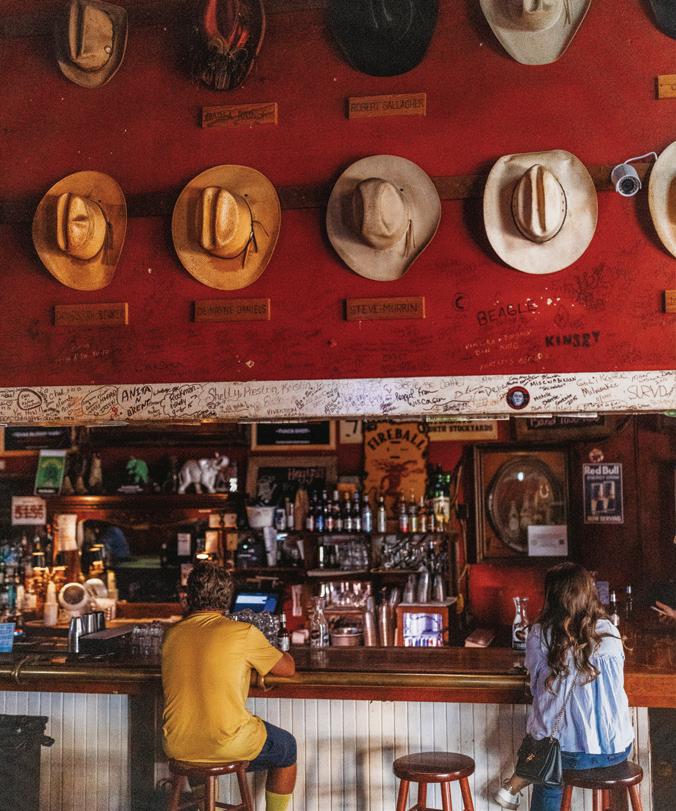

UPS, DOWNS, NEAR-DEATH EXPERIENCES, AND SENDING KIDS OFF TO COLLEGE. EVEN AFTER IT ALL, PAT GREEN REMAINS ONE OF TEXAS COUNTRY’S BIGGEST STARS — WE DON’T CARE WHAT YOU SAY … AND NEITHER DOES HE.

BY BRIAN KENDALL
It’s 9 a.m.,
and we’re at a cocktail bar. I had already decided that’s how I was going to start the article — being at such a place at such an hour seemed eccentric enough to warrant it — but the interview subject isn’t here just yet. I get a call on my phone, an 817 number. “Hi, this is Pat,” the caller said in a voice that conveys an everyman while remaining distinct at the same time. “I’m running a little behind, man. But I live close to where y’all are at, so I’ll be there soon.”
I tell him it’s no sweat. I have all day.
A few minutes later, Pat Green arrives to our joint interview/ photoshoot at South Main’s Amber Room. With a guitar in tow, he’s wearing a solid-colored golf shirt and a baseball cap — a slight departure from the head-to-toe denim he wore at Billy Bob’s the last time I saw him. After all, Green’s a dad, and he unashamedly dresses like it. A quick scroll through the gold-certified country artist’s Instagram feed will confirm this.
He’s tall. Taller than I expected, and with a slight case of nerves removing my filter, I comment on it. While changing into one of the two pearl snaps he brought for the photoshoot, he confirms that he stands a solid 6 foot, 2 inches, and, to my surprise, he also lets it slip that he’s also nervous.
“I have bad anxiety,” Green says with his hand to his chest — a gesture signaling his bpm is likely higher than normal. “I get this way with photoshoots and interviews. I can sing in front of 10,000 people, no problem. But this is the stuff that really makes me nervous.”
He’s proud of the shirt he changes into. He’d bought it recently and allows us to feel how soft it is. The customary oohs and aahs are far from forced — the shirt’s suede-like texture easily triggers an ASMR, and Green is giddy over our reactions. Once comfortably in his new brown button-up and felt hat to match
(“I’m a hat guy, especially after I started losing my hair,” he quips), he picks up his guitar — a Gibson chock-full of ornate mother-ofpearl flourishes, another recent purchase — and starts tuning it. The guitar was mostly meant to be a prop for the shoot, but like most who play, Green isn’t going to strum an out-of-tune guitar just for the hell of it.
Almost immediately, he starts belting out a song. It’s infectious and catchy and on its surface appears meaningful. The lyrics are personal. It’s a love song, and it seems like a hit. Something I’ve heard before, surely. A crossover between the country charts and Top 40.
“If I could say one thing about the way you make me feel,” he sings. He’s strumming basic chords, G, C, Am — standard country fare — but the melody flows differently. I know this song. It’s an obvious hit, so it’d be embarrassing to ask what it is. But it’s bothering me that I can’t quite place it.
“Hey, Pat, what tune is that?” I finally ask.
“Oh, I’m just fiddling around,” he says. “I made that up.”
“Just now?”
“Yeah.”
I almost don’t believe him until he starts searching for a specific chord to continue his melody. He tries a few out, hitting some offkey duds before finally stumbling upon the right one. The structure of the song seems almost complete.
“I like that,” he says with an affirming nod. “That’s cool.”
The guy who wrote Texas country’s indelible “Wave on Wave” and just released a new record elects to play none of that and, instead, writes an entirely new song the moment he picks up a guitar.
I’m in awe.
An hour later, we sit at the Amber Room’s bar with three plates of shareable appetizers.
In hindsight, it’s pretty ironic. Just as I finally bring out my tape recorder to kick off the interview — beginning at the beginning: his birthday on April 5, 1972 — he starts coughing. Turns out he’s choking on a chicken wing from the batch he’d ordered for all to share. He’s able to get whatever food was stuck in his windpipe out — or down — so no Heimlich is necessary.
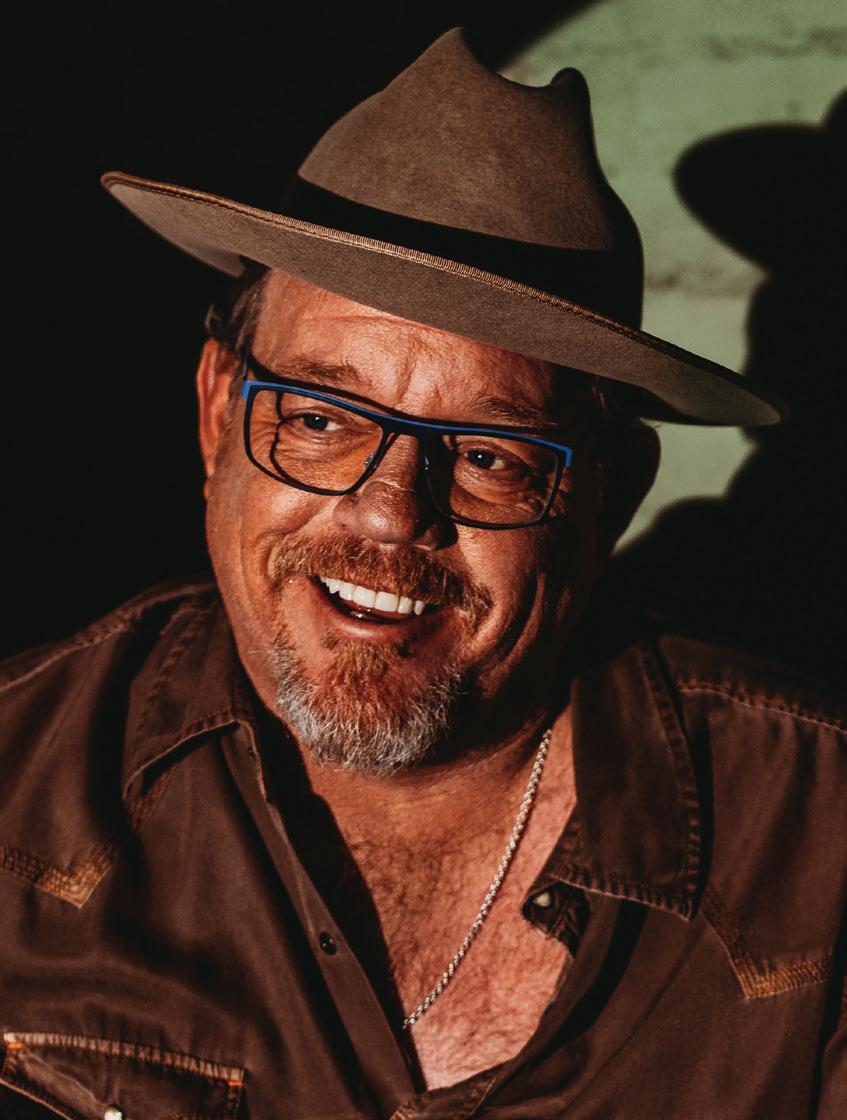
“I just almost died,” Green says. “Thing just came apart in the middle. I had the bones in my throat, and I was like, ‘Don’t swallow that!’”
I wryly tell him I’m glad he didn’t choke because I don’t know the Heimlich.
“Well, I know the Heimlich,” he says. “So, you’re safe, but I’m in trouble, I guess. I’ve actually been given the Heimlich before.”
“Really?”
“Seven years ago in North Carolina. I was eating a chicken wrap. You know, when you get to the end of the
wrap, and the end is real tightly rolled. Yeah.”
At this time, Green nearly slings a piece of Parmesan from his order of fries into my whiskey on rocks. It’s early, I know, but the watered-down drink feels apropos.
“Sorry about that,” he says. “But we might have just discovered a new concoction. Whiskey and heart truffle Parmesan. Awesome.”
Trying to take off, our intern, Victoria, who helped out our photographer during the photoshoot, is saying goodbye — she has to go to class.. Green bids her adieu by telling her to enjoy life and not to screw it up by taking it too seriously. Advice I hope she follows.
Green’s attention returns to the table.
“I’m sorry, what was your question again? Oh, right, my birthday.”
a kid, that shouldn’t even enter your brain. And, as I went through life — 18, 19, 20 — I really started understanding how hard it was to accomplish that goal. And, man, I had to make some real-life choices. It was somewhere around 20 or 21 years old when I came up with my own self mott: ‘You can’t outwork me.’”
In hindsight, Green is quick to admit that this wasn’t the right goal.
“Money isn’t really the trick, is it? Yeah, when you’re young, it’s big house and fancy car, then I’m all set, right? But that’s not at all how it works. I just turned 50 this year, and, yeah, money is a distant eighth or ninth on the list of crap I want to accomplish or achieve.”
After graduating high school, Green went to Texas Tech — compromising with his parents who wanted him to stay in-state, Green made sure his school of choice was at least 350 miles away.
Pat Green was born in San Antonio three years after his brother, whom his mother carried for 10 months before his birth. “He got an extra month for free in that womb motel,” Green jokes. After his dad got out of the Air Force, and before a toddler Green was making any memories, the family moved to a brand-new home in Hewitt, a suburb just outside of Waco, most famous for being the town where Willie Nelson was busted for weed.
So, though born in San Antonio, Green spent the entirety of his adolescence in the Waco area.
I ask why he says he’s from San Antonio so often.
“That’s exactly right,” he says. “I say San Antonio all the time, but I don’t know. I am from Waco.
“I’m a Texas transient. I’ve lived in every major city in the state except Houston and El Paso.”
The son of Baylor grads, the move to Waco seemed logical. The family had a record player — the giant cabinet type that’s connected to the TV and was likely all the rage in 1975-era department stores — which Green credits as his introduction to music.
“Learning to play guitar, learning how to play and sing at the same time, and learning how to play in front of people all happened in Lubbock in the first two years,” Green says on his documentary, “The Miles and Miles of Pat Green.”
Most importantly, Lubbock is where Green met Kori, his future wife and the muse for nearly 100% of his songs. The two have been married for 22 years, have two kids, and their intense love for one another is undeniable. It’s a honeymoonphase kind of love. Except the honeymoon is not just a phase; it’s persisted. In conversation, he touches on the subject of their love frequently because, well, it just might be his favorite thing to talk about.
“Money isn’t really the trick, is it? Yeah, when you’re young, it’s big house and fancy car, then I’m all set, right? But that’s not at all how it works. I just turned 50 this year, and, yeah, money is a distant eighth or ninth on the list of crap I want to accomplish or achieve.”
His parents divorced when he was 5 and got remarried quickly. Suddenly, he found himself with a significant uptick in brothers and sisters. He went from one of two, to one of eight. This made Green an independent kid growing up. The type of rogue 8-year-old who would ride his bike endlessly and aimlessly around town most summer afternoons. The adults, to put it bluntly, didn’t pay much attention to him.
“It bothered me that I didn’t get as much attention as the older kids, but they were going through stuff in their lives that needed more attention. A seventh and eighth grader doesn’t need a whole lot of attention. But when everybody else is 17, 18, 19, 20, 21, it’s a lot of shit going on.”
When Green was 13, he stumbled upon his stepdad’s tax return.
“It was a big number,” Green says. “Even bigger for 1984. I’ll never forget it — I said to myself at that instant that I’m going to make more than that.
“I don’t know why that was important to me. I have no idea. For
“What’s that line? She’s my lobster?” Green asks. I answer in the affirmative.
“I love being around her. I love talking to her. She gets really sick of hearing me talk about her, especially in public. But I don’t know. It’s a special thing. She’s everything, which is kind of sick. Or maybe it’s romantic. Yeah, I’ll choose the word romantic.”
It was Kori’s decision to attend UT Law School, not the city’s reputation for being the live music capital of the world, that motivated Green to move to Austin. The state’s capital is where Green got entrenched in the Texas country music scene and became one of the genre’s most prolific songwriters and performers. He started regularly opening for Willie Nelson and Jerry Jeff Walker. Seemingly overnight, his band started headlining shows for crowds of 15,000.
After a couple of independent releases, he eventually got the “we’ll make you a rock star” speech from Universal Records, who released the Grammy-nominated Three Days, followed by Wave on Wave, Green’s highest selling album to date.
It’s difficult to overstate the importance of “Wave on Wave,” the album’s title track. The song’s opening 15 seconds remain one of country music’s most enduring guitar licks, but it was a departure from the traditional Texas country sound that made Green one of the state’s most popular acts. Genre staples like consistent references to the Lone Star State and raw production were noticeably absent. Recorded in Los Angeles, the tune was
catchy and universally adored, but Texas country purists labeled it abandonment. The song became Exhibit A when music critics started deriding Nashville’s poppy influence on the Texas country music sound.
Green, for his part, has never seemed to care. Selling out? You mean, like, wanting people to listen to his music? Sure, Green says, if that’s what you call selling out, he’s selling out.
“I guess I’m opportunistic when it comes to getting myself out there, and that’s really important if you’re going to make it in this business. Why wouldn’t you sell out? Right? If this is what you want to do for a living and this is how you want to pay for your kids’ college, why wouldn’t you sell out? Why wouldn’t you just say, ‘I will do anything on this planet to accomplish the goal of having a career in this?’
“I don’t care if it’s house painting or photography or journalism or whatever it is, put yourself in the best position to make a living doing what it is you love to do. And then most of your life from that point on is really … it’s kind of breezy.”
Equal parts out of convenience — the flights for Green’s touring are easier through DFW — and because of their love for the city, the Greens moved to Fort Worth in 2005 when Kori was pregnant with their second child. Here, the family of four has made a home. Kori has a popular line of jewelry, Kori Green Designs, Pat regularly hits the links for a round of golf, and the family routinely takes in Cowboys and Rangers games. Green’s admittedly not as prolific as he once was, but he’s still occasionally touring and pumping out an album every now and then — mostly when the moment strikes. Here, the soon-to-be empty nesters are happy. They’re comfortable.
wilderness, and they’ll either retreat or rattle words to find their conversational comfort zone. Green does neither.
Nervous or not, it seems his guard is perpetually down. Maybe it’s a wisdom achieved through the years — Green turned 50 this year — but it’s not a stretch to suspect the musician’s comfort zone is simply living. He possesses the full spectrum of emotion and manages to feel deeply while also taking it all in stride. He has a happy-go-lucky disposition — an endearing and enduring pearlywhite smile that never seems to disappear — but he’s also quick to tear up when talking about dropping his oldest son off at the University of Texas at Austin, which he did a week prior to our interview.
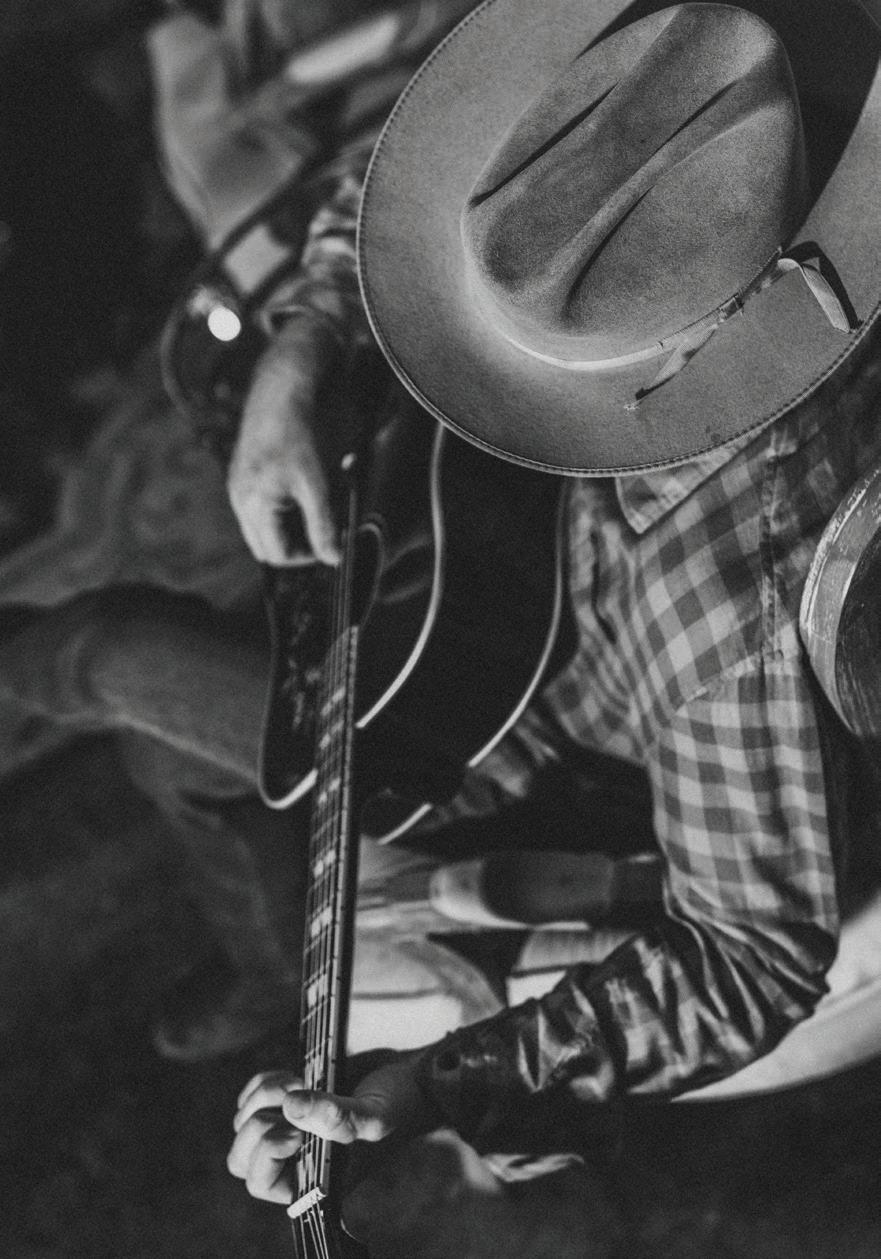
“I don’t think I know anybody who’s ever moved out of Fort Worth since I’ve been here,” Green says. “It’s just, once you get here, you’re like, ‘Eh, it’s pretty good stuff.’
“I don’t write as often as I used to. So, when I write now, it’s just like what happened [when I picked up the guitar] over there when we were just jacking around. I hear something come out, and I’m like, ‘Ooh, that’s pretty darn good.’”
At some point during the interview, Green reminds me of his anxiety and says he’s in interview mode.
Most people, when anxious, will clam up or ramble — one or the other. They’re out of their element, as if dropped in a treacherous
“I guess I’m just one of those guys who cries and shit,” Green says.
There’s just something inherently disarming about Green. Something … just so damn relatable. Few people have the same inflexions he has when he speaks. He gets excited; it gets you excited. He gets emotional; it gets you emotional. In other words, whether putting on a concert or talking or both, it’s a rare breed who can connect with their audience like Green.
But Green, like a true renaissance man, has outlets of expression outside of music. He doesn’t do music every day. But he does do art every day.
“I do a lot of sculpting, a lot of painting. I write all the time. I love my imagination. My imagination is my favorite. If you really want to get to know me, get to know my imagination. It’s my favorite side. I love expression, and I love being true to expression.”
In 2012, while visiting his children during their stay at a summer camp, Green was fascinated by the design of a collection of chandeliers that were above him.
“They were so intricate and amazing. You could tell that they were handcrafted. And there were these … Oh, I don’t know how to describe it, but they were fantastic. And the owner of the camp, Meg, was sitting next to me. I said, ‘Meg, I want to know who made those chandeliers.’ And she goes, ‘That’s funny, he’s sitting right next to you. Meet Gil Bruvel.’”
Green’s difficulty in describing Bruvel’s art is not surprising; his work would stump any master wordsmith. With that said, I’ll give it a shot: Bruvel creates highly textured, twisting, and complex sculptures and paintings made with various materials, including wood and stainless steel. You shouldn’t hesitate to look it up if you have a minute.
Bruvel, who’s from France, lives in Wimberley. Since his introduction to Green, the two have become very close friends,
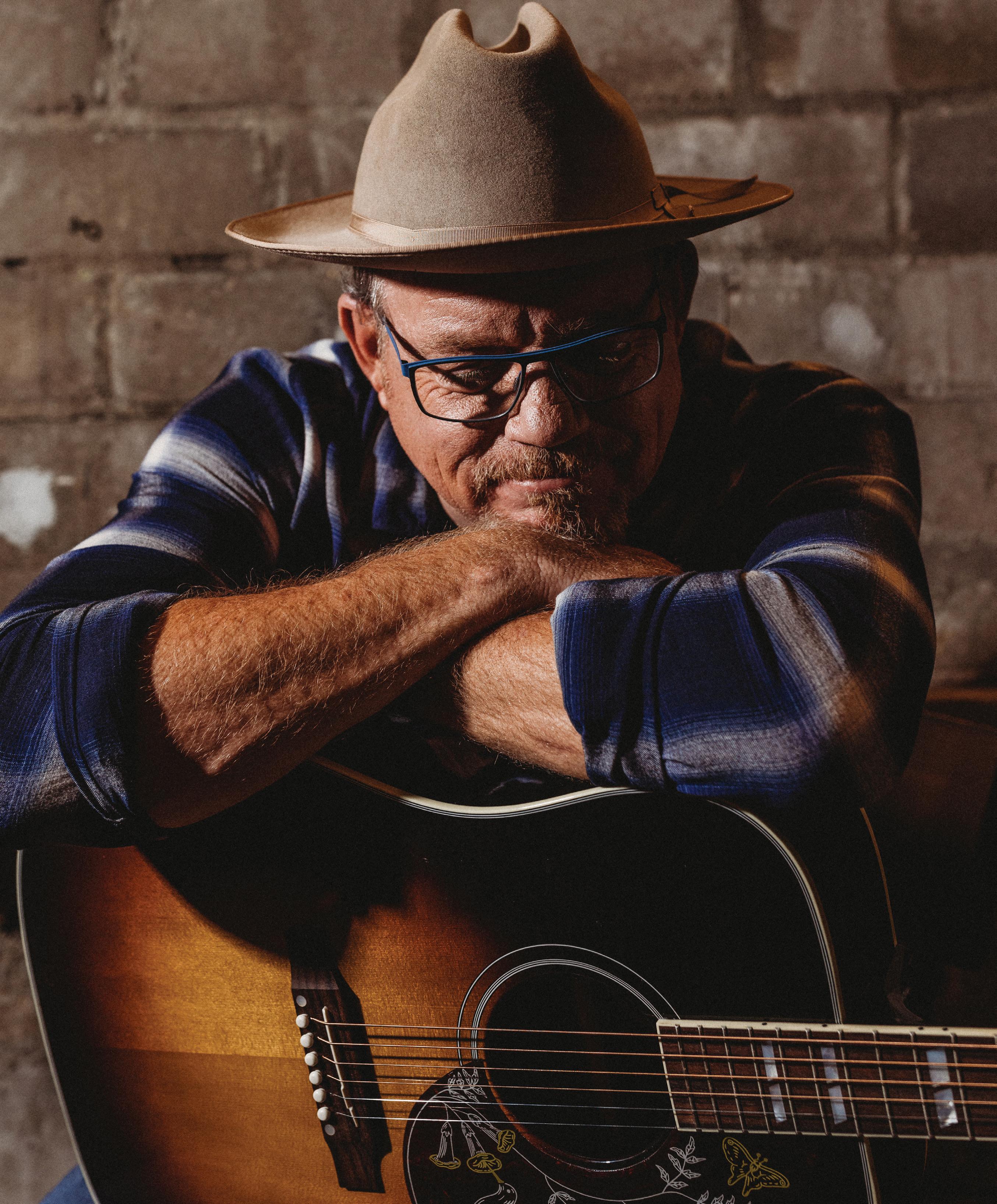
“I don’t care what you call it. God. Jesus. It doesn’t matter. It’s there. I got to learn from Willie Nelson and Jerry Jeff hands-on. Hands-on, right next to them in the flesh. So, it’s like I’ve been given this tremendous pile of ‘Hey, open door.’ I’m the happy idiot.”

“I love that people sing along to my songs. I love that I have had a lifelong career, and I love that I love music.”
with Green occasionally going to Wimberley on weekends. “I’ll go down to his place and just hibernate, or not hibernate … marinate. Marinate in art.”
Becoming a bit of a protégé, Green even interviewed Bruvel for Juxtapoz, a highly influential art and culture magazine based in San Francisco. Bruvel and Green, who’s no slouch at interviewing, chatted about metaphysical flow, creating art in the meditative state, and how lighting affects the color palette of an artwork. It’s an excellent interview that, if you’re still in the mood to read after finishing this article, I highly recommend checking out.
Since diving deep into painting and sculpting, Green opened an art space that housed his and other artists’ works. While the gallery, which opened in 2018, has since closed, Gallerywinter Gallery remains an art collective that routinely collaborates.
Speaking to the serendipitous circumstances in which he met Bruvel, Green is convinced it’s no coincidence.
“When we met, I was dabbling in sculpting and painting, but I wasn’t serious,” Green says. “Call it what you want, but I believe there’s a higher power in this universe. I really believe in that. And I don’t necessarily think about things like fate because I don’t think He’s really trying to throw you in one direction or another, but I do believe that opportunities present themselves that are good for your life.
“I tend to do that with my work. Some people write songs in their niche. Jimmy Buffet has a niche. He fills that spot and writes about specific things and legions of people will show up. Now, I foolishly didn’t do that with my work. I write exactly what I think right then.”
Miles and Miles of You (2022)
Build You a Bar (2022)
Carry On (2001)
Three Days (2001)
Whiskey (2001)
Take Me Out to a Dancehall (2001)
Wave on Wave (2003)
Guy Like Me (2003)
Girls From Texas (featuring Lyle Lovett) (2015)
Baby Doll (2004)
Til the Last Whistle Blows (2019)
While I Was Away (2015)
Let Me (2009)
Feels Just Like It Should (2006)
I Like Texas (Live) (1998)
Songs About Texas (1997)
Southbound 35 (1995)
George’s Bar (1997)
“I mean, here I was sitting next to a guy who changed my life. That’s been the thing that I think of when I’m talking about the higher power, the spirit of the universe. I don’t care what you call it. God. Jesus. It doesn’t matter. It’s there. I got to learn from Willie Nelson and Jerry Jeff hands-on. Hands-on, right next to them in the flesh. So, it’s like I’ve been given this tremendous pile of ‘Hey, open door.’ I’m the happy idiot.”
Green’s new album, Miles and Miles of You, was just released to the streaming public. That’s why we’re talking. That’s why we’re photographing him.
It’s his first album in seven years, it’s getting a lot of positive press, and it’s really damn good.
Green calls the record a release valve for COVID. After losing 40 pounds and being in the deepest darkest depression of his life — and Kori threatening to burn the chair he incessantly sat in — he got to work on a new record.
“It was very painful to come out of that, but in that spirit came a lot of release-valve songs,” Green says. “Songs like ‘I’m Going Home,’ songs like ‘Bad Bones,’ songs like ‘Steady.’ All these songs that are about being a little vulnerable and talk about ‘Hey, here’s what’s going on.’
Continuing a theme from his 2015 album, called Home, that very word, “home,” is also splattered throughout the songs on his latest release.
“In all these years, I spent a lot of time on the road being in Nashville and New York. Those were the places where my record label was and still is. But my roots are here in Texas. I’ve never lived anywhere else.
The state of Texas is almost shaped like [a baseball field’s] home base. It’s almost a perfect home base, right?
“Yet, there’s so many people who go to these big cities to be movie stars, country singers, rock and rollers, whatever they want to be. And they go to these places to be something that they’re not or something that they want to be, which is fine. Hey, I’m not taking that away from anyone because it works for a handful of people.
“While I signed my record deal in New York, and I had a record deal in Nashville, I was still a Texas artist who wanted to be in Texas.
“It’s not even a long story to tell. Home is Texas.”
Pat Green is a Texan through and through. And Pat Green is an artist through and through.
Like the paintings and sculptures he produces, Green does what he wants irrespective of and unrestrained by genre or classification. Call it country, call it music, heck, just call it art.
When one takes a cursory glance at artists who have collaborated with or paid tribute to Green, they’ll find a murderer’s row of respected industry personalities: Willie Nelson, Jerry Jeff Walker, Chris Stapleton, Lyle Lovett, Sheryl Crow, Cory Morrow, and Marc Broussard, just to name a few. But they’ll also find a wide range of artists who themselves defy any tropes of a specific genre.
All of this begs the question: At what point is being authentic simply staying true to you and not a specific subgenre with a myriad of constraints?
Of course, to Green, I’m posing a futile question and likely wasting ink writing about the gatekeepers of Texas country, red dirt country, New Mexico country, and fill-in-the-blank country. Pat Green could not care less what they think. Just attend one of his live shows, and you’ll see he has the ultimate trump card.
“I love that people sing along to my songs. I love that I have had a lifelong career, and I love that I love music.” Green playfully hits the stop button on my recorder. While his silver tongue has a wonderful way with words, he couldn’t possibly come up with a better line to end the interview. I agree.
IN BREAST CANCER TREATMENT, radiation oncologists increasingly aim to protect the heart from unnecessary radiation, and Dallas/Ft. Worth-based Texas Center for Proton Therapy finds its high-end technology well positioned for the trend.
The move toward avoiding exposing cardiac tissue to radiation is an evolution in care that can make a significant difference in women’s heart health later in life, explains Jared Sturgeon, M.D., Ph.D., a radiation oncologist at Texas Center for Proton Therapy. “Excess radiation can damage several critical areas of the heart, which can lead to a higher risk of coronary artery disease, including myocardial infarction and heart failure,” he says.
With the most advanced proton therapy in the state, the Center provides an excellent option for protecting women’s hearts, Dr. Sturgeon says. “Our technology is especially suited to concentrating treatment on the target tissue and avoiding the heart and lungs,” he says. “Proton therapy uses a focused beam only a few millimeters wide to precisely ‘paint’ the target with therapeutic proton radiation, minimizing damage to healthy surrounding tissue.”

In fact, proton therapy consistently demonstrates the lowest average dose to the heart in treatments of the breast, the chest wall and nearby lymph nodes, according to a major study by University of Oxford researchers published in the November 2015 International Journal of Radiation Oncology, Biology, Physics.
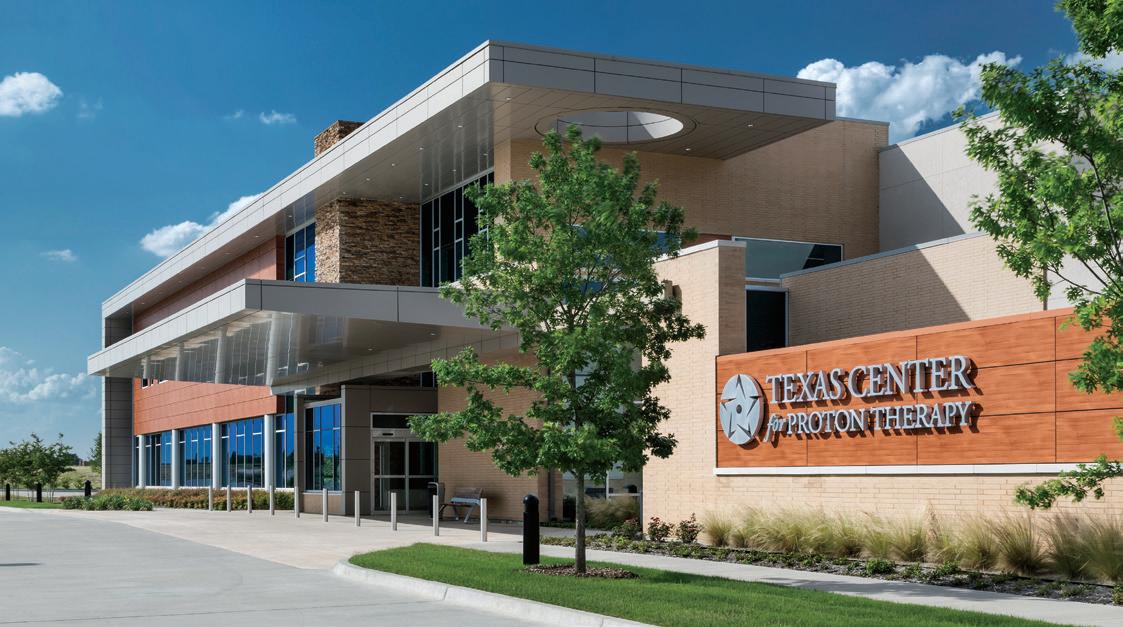
Advanced targeting technology is also crucial for avoiding needless irradiation of the heart at Texas Center for Proton Therapy. “With its pinpoint accuracy, our proton beam treats tumors layer by layer, in three dimensions,” Dr. Sturgeon says. “With our advanced technology, we can also ensure that the proton beam doesn’t exit the body through tissue that shouldn’t be exposed to radiation.”
Additionally, the Center’s cone-beam CT image guidance system provides clinicians a three-dimensional view of a patient’s anatomy, allowing them to develop a tailored approach. Using the CT imaging scans, the Center’s physicists, dosimetrists (who calculate radiation doses) and radiation oncologists program the proton beam equipment to deliver the optimal dose to each target tissue, even if it’s irregularly shaped.
While the field of oncology continues shaving down cardiac risks related to breast cancer treatment, Texas Center for Proton Therapy plans to keep getting the most out of its considerable technology and expertise. “We’re dedicated to providing our patients the best possible treatment for their immediate needs and for years to come,” Dr. Sturgeon says.
Targeting Cancer, Precisely

hospitals, diagnostics, cancer and rehab centers
JPS Oncology & Infusion Center 1450 Eighth Ave. Fort Worth 76104
817.702.8300
jpshealthnet.org/locations/oncologyinfusion-center
Moncrief Cancer Institute | UT Southwestern
400 W. Magnolia Ave. Fort Worth 76104
817.288.9970 moncrief.com
Texas Breast Specialists - Arlington Cancer Center North 906 West Randol Mill Road, Suite 200 Arlington 76012
817.664.9600
Texas Breast Specialists - Bedford 1609 Hospital Parkway Bedford 76022
817.662.0008
Texas Cancer Specialists 6801 Oakmont Blvd., Ste. 101 Fort Worth 76132
817.438.0259
Texas Health Harris Methodist Hospital Fort Worth, Klabzuba Cancer Center
1300 W. Terrell St. Fort Worth 76104
817.820.4848 texashealth.org
Texas Health HEB Cancer Services 1600 Hospital Parkway Bedford 76022
817.848.4000 texashealth.org/locations/texas-health-heb
Texas Oncology - Arlington Cancer Center North
906 W. Randol Mill Road, Ste. 200 Arlington 76012
817.664.9600
Texas Oncology - Arlington South 515 W. Mayfield Road, Ste. 101 Arlington 76014
817.664.4400
Texas Oncology - Bedford 1609 Hospital Parkway Bedford 76022
817.359.9000
Texas Oncology - Cleburne 191 Walls Drive Cleburne 76033
817.648.0120
Texas Oncology - Fort Worth Cancer Center
500 South Henderson St. Fort Worth 76104
817.413.1500 texasoncology.com
Texas Oncology - Granbury 1310B Paluxy Road, Ste. 2000 Granbury 76048
817.579.3700
Texas Oncology - Grapevine 1631 Lancaster, Ste. 150 Grapevine 76051
817.251.9080
Texas Oncology - Keller 100 Bourland Road, Ste. 130 Keller 76248
817.359.9000
Texas Oncology - Mansfield 252 Matlock Road, Ste. 140 Mansfield 76063
817.435.5800
Texas Oncology - Southwest Fort Worth 6500 Harris Parkway Fort Worth 76132
817.263.2600
Texas Oncology - Weatherford 911 Foster Lane Weatherford 76086
817.597.7900
Texas Urology Specialists - Mansfield
252 Matlock Road, Ste. 140 Mansfield 76063
214.948.3101
The Center For Cancer & Blood Disorders - Burleson 11805 S. Freeway, Ste. 201 Burleson 76028 817.759.7000
The Center for Cancer & Blood Disorders - Granbury Lake Granbury Medical Center 1308 E. Paluxy Road, Ste. 205 Granbury 76048 817.759.7000
The Center for Cancer & Blood Disorders - Medical City Arlington 515 W. Mayfield Road, Ste. 102 Arlington 76014 817.759.7000
The Center for Cancer & Blood Disorders - Mineral Wells 400 SW 25th Ave. Mineral Wells 76067 817.759.7000
The Center for Cancer & Blood Disorders - Southwest Fort Worth 6100 Harris Parkway, Ste. 260 John Ryan Building Fort Worth 76132 817.759.7000
The Center for Cancer & Blood Disorders - Weatherford 920 Santa Fe Drive Weatherford 76086 817.759.7000
The Center for Cancer and Blood Disorders - Central Campus 800 W. Magnolia Ave. Fort Worth 76104 817.759.7000 thecentertx.com
USMD Arlington Cancer Center Urology Clinic 801 W. Interstate 20, Ste. 1 Arlington 76017 817.784.8268
usmd.com/services/services-specialtycare/usmd-urology.html
USMD Imaging Center for Breast Health
811 W. Interstate 20, Ste. G40 Arlington 76017
817.505.1400
usmd.com/services/imaging-centers/ breast-health.html
Touchstone Imaging Downtown Fort Worth Rosedale 1701 W. Rosedale St. Fort Worth 76104
817.922.7780
touchstoneimaging.com/locations/dt-fortworth-rosedale
Touchstone Imaging Fort Worth 6900 Harris Parkway, Ste. 100 Fort Worth 76132
817.294.1131
touchstoneimaging.com
Touchstone Imaging Fossil Creek 5455 Basswood Blvd., Ste. 550 Fort Worth 76137
817.428.5002
touchstoneimaging.com/locations/fossilcreek
Touchstone Imaging Grand Prairie 2740 N. State Highway 360, Ste. 200 Grand Prairie 75050
972.579.4480
Akumin – Fort Worth 851 Grainger St., Ste. 101 Fort Worth 76104
817.659.2870 akumin.com
Gateway Diagnostic Imaging –Weatherford 831 Eureka St. Weatherford 76086 817.599.8995
gatewaydiagnostic.com/locations/ weatherford-2
Touchstone Imaging Arlington 601 W. Arbrook Blvd. Arlington 76014 817.472.0801
touchstoneimaging.com/locations/ arlington
Touchstone Imaging Burleson 665 NE Alsbury Blvd. Burleson 76028
817.447.3443
touchstoneimaging.com/locations/ burleson
touchstoneimaging.com/locations/grandprairie
Touchstone Imaging Hurst 1717 Precinct Line Road, Ste. 103 Hurst 76054
817.498.6575
touchstoneimaging.com/locations/hurst
Touchstone Imaging Keller 601 South Main St., Ste. 100 Keller 76248
817.482.2000
touchstoneimaging.com/locations/keller
Touchstone Imaging Southlake 925 E. Southlake Blvd., Ste. 220 Southlake 76092
817.424.4800
touchstoneimaging.com/locations/ southlake
Baylor Scott & White All Saints Medical Center — Fort Worth 1400 Eighth Ave. Fort Worth 76104
817.926.2544
bswhealth.com/fortworth 578 beds
Baylor Scott & White Medical Center – Grapevine 1650 W College St. Grapevine 76051
817.481.1588
bswhealth.com/locations/grapevine 302 beds
Baylor Scott & White Surgical Hospital – Fort Worth 1800 Park Place Ave. Fort Worth 76110
682.703.5600
bshfw.com | 30 beds
Cook Children’s Medical Center 801 Seventh Ave. Fort Worth 76104
682.885.4000
cookchildrens.org | 444 beds
JPS Hospital 1500 S. Main St. Fort Worth 76104
817.702.1100
jpshealthnet.org | 582 beds
Kindred Hospital Tarrant CountyFort Worth Southwest
7800 Oakmont Blvd. Fort Worth 76132
817.346.0094
kindredhealthcare.com | 92 beds
Every October, women band together with pink ribbons in hand to spread awareness for breast cancer. With one in eight U.S. women developing breast cancer in their lifetime, what can women do to reduce their risk of a late-stage breast cancer diagnosis?
Other than adopting a healthier lifestyle, early detection with regular mammograms remains the most effective way for combating breast cancer. Understanding when and why to schedule regular screenings and knowing the signs and symptoms can result in better outcomes. Over the past few decades, there has been a steady decline in breast cancer deaths among women as a result of early detection.
Why are screenings important?
As a result of the pandemic, fewer women are going into doctors’ offices for their annual checkups or screenings, leading to more late cancer diagnoses. Early detection is key because cancer in its early stages, and localized to one location, is the most treatable. Screenings can detect cancerous cells before symptoms show, allowing patients to start treatment before the cancer has a chance to spread.
Women who receive regular mammograms are more likely to detect cancer early, require less aggressive treatment, and have better outcomes. According to the American Cancer Society, early-stage breast cancer that hasn’t spread has a 99% five-year survival rate, versus a 29% five-year survival rate for cancer that has spread to other parts of the body.
Signs and symptoms
While a lump in the breast, under the arm, or around the collarbone is the most well-known symptom of breast cancer, other indicative symptoms include:
• Change in breast size or shape
• Thickening of breast or underarm
• Nipple retraction or nipple discharge
• Dimpled skin or skin resembling orange peel
• Tenderness or pain in breast or nipple
• Irritation, redness, scaliness, or swelling on the breast, nipple, or skin near the nipple
• Swollen lymph nodes
If you notice any of these symptoms or changes in your breasts, consult your physician immediately.

Women of every age should discuss individual risk factors with a physician to determine recommended timing and appropriate screenings. Women with a family history of breast cancer, or who are known to be of higher risk, should start screening early and take further preventive measures.
Beginning at age 20 and onward, women should check their breasts monthly, note any changes, and report them to a physician immediately. Women aged 40-44 have the choice to start annual mammograms, and those aged 45-54 should get mammograms every year. Women aged 55 and older should have a mammogram at least every two years.
Ultimately, it is up to patients to take control of their health and be proactive in taking measures for early detection of breast cancer. Texas Breast Specialists encourages all women to prioritize their long-term health with regular breast cancer screenings. For more information, visit TexasBreastSpecialists.com



Texas Breast Specialists provide leading edge surgical approaches and integrated care that includes a multidisciplinary team. From 18 dedicated breast surgeons in the DFW area to our experts in medical and radiation oncology, genetic risk evaluation, and supportive care, we compassionately collaborate with you to help you better understand your disease and develop a personalized surgical treatment plan.
Alison Unzeitig Barron, M.D., FACS Carrollton and Dallas
Katrina E. Birdwell, M.D., FACS Dallas, Mansfield and Midlothian
W. Lee Bourland Jr., M.D., FACS Dallas
Mary B. Brian, M.D., FACS Bedford
Lynn Canavan, M.D., FACS Denison, McKinney and Plano
Bindupriya Chandrasekaran, M.D., MRCS
Dallas
Tuoc N. Dao, M.D., FACS Dallas
Allison A. DiPasquale, M.D. Dallas
Amy Eastman, M.D., FACS Rockwall
Archana Ganaraj, M.D. Dallas
Meghan Hansen, M.D. Frisco and Plano
Jennifer Hecht, D.O., FACOS Fort Worth and Granbury
Melissa Kinney, M.D. Flower Mound and Lewisville
Martin L. Koonsman, M.D., FACS, CPE Dallas
Jeffrey P. Lamont, M.D., FACS Dallas, Paris and Plano
Kerri L. Perry, M.D., FACS Denton
Angela E. Seda, M.D. Arlington and Keller

Lake Granbury Medical Center 1310 Paluxy Road Granbury 76048
817.573.2273
lakegranburymedicalcenter.com
LifeCare Hospital of Fort Worth 6201 Overton Ridge Blvd. Fort Worth 76132
817.222.8300
lifecare-health.com | 45 beds
Medical City Arlington 3301 Matlock Road Arlington 76015
682.509.6200
medicalcityarlington.com | 433 beds
Medical City Fort Worth
900 Eighth Ave. Fort Worth 76104
817.336.2100
medicalcityfortworth.com | 48 beds
Medical City North Hills 4401 Booth Calloway Road North Richland Hills 76180
817.255.1000
medicalcitynorthhills.com | 164 beds
Medical City Weatherford
713 East Anderson St. Weatherford 76086
682.582.1000
medicalcityhealthcare.com/locations/ medical-city-weatherford/
Methodist Mansfield Medical Center
2700 E. Broad St. Mansfield 76063
682.242.2000
methodisthealthsystem.org/mansfield 262 beds
Parker County Hospital District 1130 Pecan Drive Weatherford 76086
817.341.2520
pchdtx.org
Texas Health Arlington Memorial Hospital
800 W. Randol Mill Road
Arlington 76012
817.960.6100
texashealth.org/arlington | 369 beds
Texas Health Harris Methodist Hospital Alliance 10864 Texas Health Trail Fort Worth 76244
682.212.2000
texashealth.org/alliance | 151 beds
Texas Health Harris Methodist Hospital Azle 108 Denver Trail Azle 76020
817.444.8600
texashealth.org/azle | 36 beds
Texas Health Harris Methodist Hospital Cleburne 201 Walls Drive Cleburne 76031
817.641.2551
texashealth.org/cleburne | 137 beds
Texas Health Harris Methodist Hospital Fort Worth 1301 Pennsylvania Ave. Fort Worth 76104
817.250.2000
texashealth.org/fortworth | 707 beds
Texas Health Heart & Vascular Hospital Arlington 811 Wright St. Arlington 76012
817.960.3500
texashealthheartandvascular.org 47 beds
Texas Health HEB
1600 Hospital Parkway Bedford 76022
817.848.4000
texashealth.org/heb | 322 beds
Texas Health Huguley Hospital Fort Worth South 11801 S. Freeway Burleson 76028
817.293.9110
texashealthhuguley.org | 168 beds
Texas Health Neighborhood Care & Wellness Willow Park 101 Crown Pointe Blvd. Willow Park 76087
817.757.1500
texashealth.org/Locations/texas-healthwillow-park
Texas Health Southwest Fort Worth 6100 Harris Parkway Fort Worth 76132
817.433.5000
texashealth.org/southwestfw | 261 beds
USMD Hospital at Arlington 801 W. I-20 Arlington 76017
817.472.3400 usmdarlington.com | 34 beds
UT Southwestern Monty and Tex Moncrief Medical Center at Fort Worth
600 South Main St. Fort Worth 76104
817.882.2400 utswmed.org
Advanced Rehabilitation and Healthcare of Burleson
275 SE John Jones Drive Burleson 76028
817.730.4603 ahstexas.com/burleson
Allegiant Wellness and Rehab 724 W. Rendon Crowley Road Crowley 76036
817.297.4141 allegiant wellness.com
Baylor Scott & White Outpatient Rehabilitation - Fort Worth - Carter
Rehabilitation 1400 Eighth Ave. Fort Worth 76104
817.922.7105 bswrehab.com
Burleson Nursing & Rehabilitation Center
600 Maple Ave. Burleson 76028
817.295.8118
seniorlivingproperties.com


Cityview Nursing and Rehabilitation 5801 Bryant Irvin Road Fort Worth 76132
817.346.3030 regencyhealthcare.com/locations/cityview
ClearSky Rehabilitation Hospital of Weatherford
703 Eureka St. Weatherford 76086
682.803.0100 clearskyhealth.com/weatherford 26 beds | 7 physicians
College Park Rehabilitation and Care Center
1715 Martin Drive Weatherford 76086
817.458.3100 collegeparkrehab.com
Emerald Hills Rehabilitation and Healthcare Center 5600 Davis Blvd. North Richland Hills 76180
817.503.4700 emeraldhillsrehabhcc.com
Encompass Health Rehabilitation Hospital of Arlington 3200 Matlock Road Arlington 76015 817.468.4000 encompasshealth.com/arlingtonrehab
Encompass Health Rehabilitation Hospital of Cityview 6701 Oakmont Blvd. Fort Worth 76132
817.370.4700 encompasshealth.com/fortworthrehab
Fort Worth Transitional Care Center 850 12th Ave. Fort Worth 76104
817.882.8289 regencyhealthcare.com/locations/fortworth
Granbury Care Center 301 South Park Drive Granbury 76048
817.573.3726 granburycarecenter.com
Hilltop Park Rehabilitation and Care Center
970 Hilltop Drive Weatherford 76086
817.599.0000 hilltopparkrehab.com
Holland Lake Rehabilitation and Wellness Center
1201 Holland Lake Drive
Weatherford 76086
817.598.0160
hollandlakerehabilitationandwellness.com
Medical City Rehabilitation –Weatherford 879 Eureka St. Weatherford 76086
682.582.2991 medicalcityhealthcare.com
Santa Fe Health & Rehabilitation Center
1205 Santa Fe Drive Weatherford 76086
817.594.2786
ahstexas.com/santafe
Southwest Nursing & Rehabilitation Center
5300 Altamesa Blvd. Fort Worth 76133
817.346.1800
Southwestnursingcenter.com
Sports Rehabilitation Specialists
1901 Cooper St. Fort Worth 76104
817.877.8977
Sportsrehabspecialists.net
Texas Health HEB Cardiac Rehabilitation
1600 Hospital Parkway Bedford 76022
817.848.5600
texashealth.org/heb/services/heart-andvascular/cardiac-rehabilitation
Texas Health HEB Pulmonary Rehabilitation
1600 Hospital Parkway Bedford 76022
817.848.5600
texashealth.org/en/health-and-wellness/ heart-and-vascular/pulmonaryrehabilitation
Texas Health Neighborhood Care & Wellness Burleson
2750 SW Wilshire Blvd. Burleson 76028
817.782.8000
texashealth.org/locations/texas-healthburleson
Texas Health Southwest Fort Worth 6100 Harris Parkway Fort Worth 76132
817.612.9715
texashealth.org/southwestfw/services/ rehabilitation
Texas Rehabilitation Hospital of Arlington
900 W. Arbrook Blvd. Arlington 76015
682.304.6000
texasrehabarlington.com 40 beds
Texas Rehabilitation Hospital of Fort Worth 425 Alabama Ave. Fort Worth 76104
817.820.3400
texasrehabhospital.com 66 beds
Willow Park Rehabilitation & Care Center
300 Crown Pointe Blvd. Willow Park 76087
817.757.1200 willowparkcare.com

Dallas Nephrology Associates (DNA) and DNA Fort Worth Kidney Centers have been trusted sources of information and top-quality kidney care in the Dallas/Fort Worth area since 1971. DNA provides care for patients with kidney disease, hypertension, kidney transplants and complicated electrolyte disorders. As one of the largest teams of kidney specialists in the United States, we are focused on providing patients and referring physicians with expert care and evaluation of kidney disorders.
Our physicians continue to take the lead in fighting chronic kidney disease, diabetes and hypertension through leadership roles in education and research.

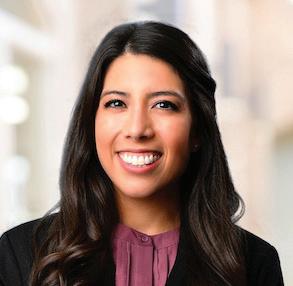
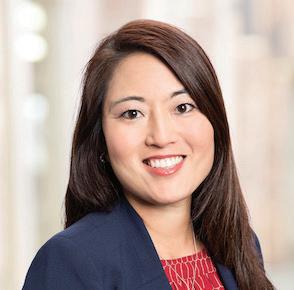
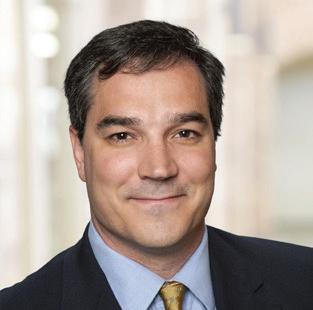


McLemore,

Dr. Faryal Niazi, MD
FORT WORTH OFFICE LOCATIONS:
• Crowley
• Fort Worth
• Keller
• Weatherford
RESEARCH:
• Renal Disease Research Institute
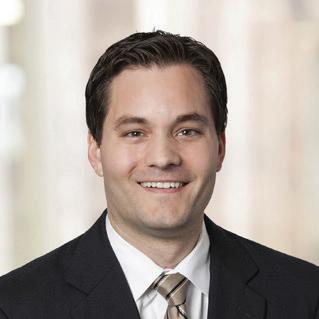
S.
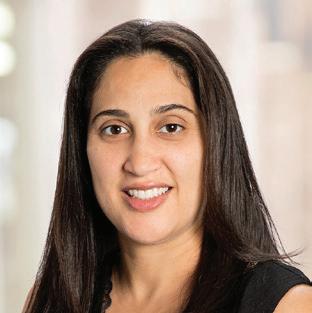
Mariana Yager,
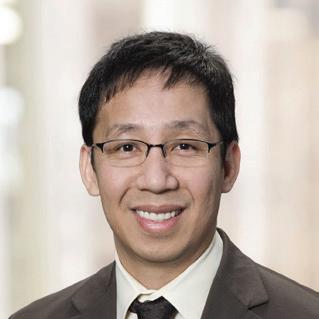
TRANSPLANT:
• Dallas Transplant Institute
• Baylor Scott & White All Saints Medical Center - Fort Worth
• Baylor University Medical Center Dallas
• Medical City Dallas Healthcare
• Methodist Dallas Medical Center
VASCULAR ACCESS CENTERS:
• Vascular Center Dallas
• Vascular Center Plano


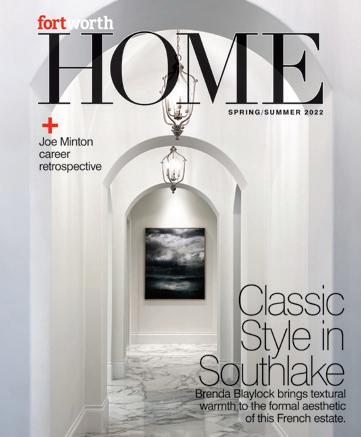
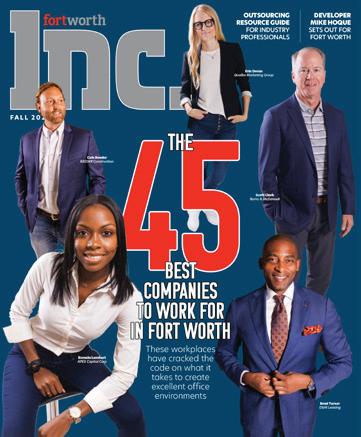
For over 20 years, we’ve had our ears to the ground, our eyes on the ball, and our fingers on the pulse of Fort Worth. This gives us an edge to deliver the city’s best lifestyle, business, and home content. Don’t miss out on anything Fort Worth. Subscribe now.
Reliable Repairs, Replacements & Installs: Faucets, Toilets, Water Heaters, Sewers, Drains, and much more! Call For The Solutions To Your Plumbing Problems (817) 999-7363 | 1319 Madeline Pl, Fort Worth www.eclecticplumber.com Plumber license number M-42930

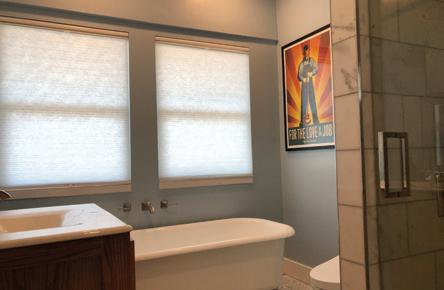

Print creates an emotional connection. Print builds relationships.
Physical material is more “real” to the brain, involves more emotional processing, is better connected to memory, with greater internalization of ads—all important for brand associations. (FORBES)


The partnership between you and your doctor is one of the most vital pairings for a happy and fit lifestyle. In matters of health, you should never settle. Selecting the right practitioner can make all the difference. To aid in choosing the perfect person for your medical needs, a few local physicians have purchased space to tell you more about themselves, their practices, and how partnering with them will improve your quality of life.
The information in this section is provided by the advertisers and has not been independently verified by Fort Worth Magazine.
Y. Anthony Nakamura, M.D., F.A.C.S., P.A.
Accent on You
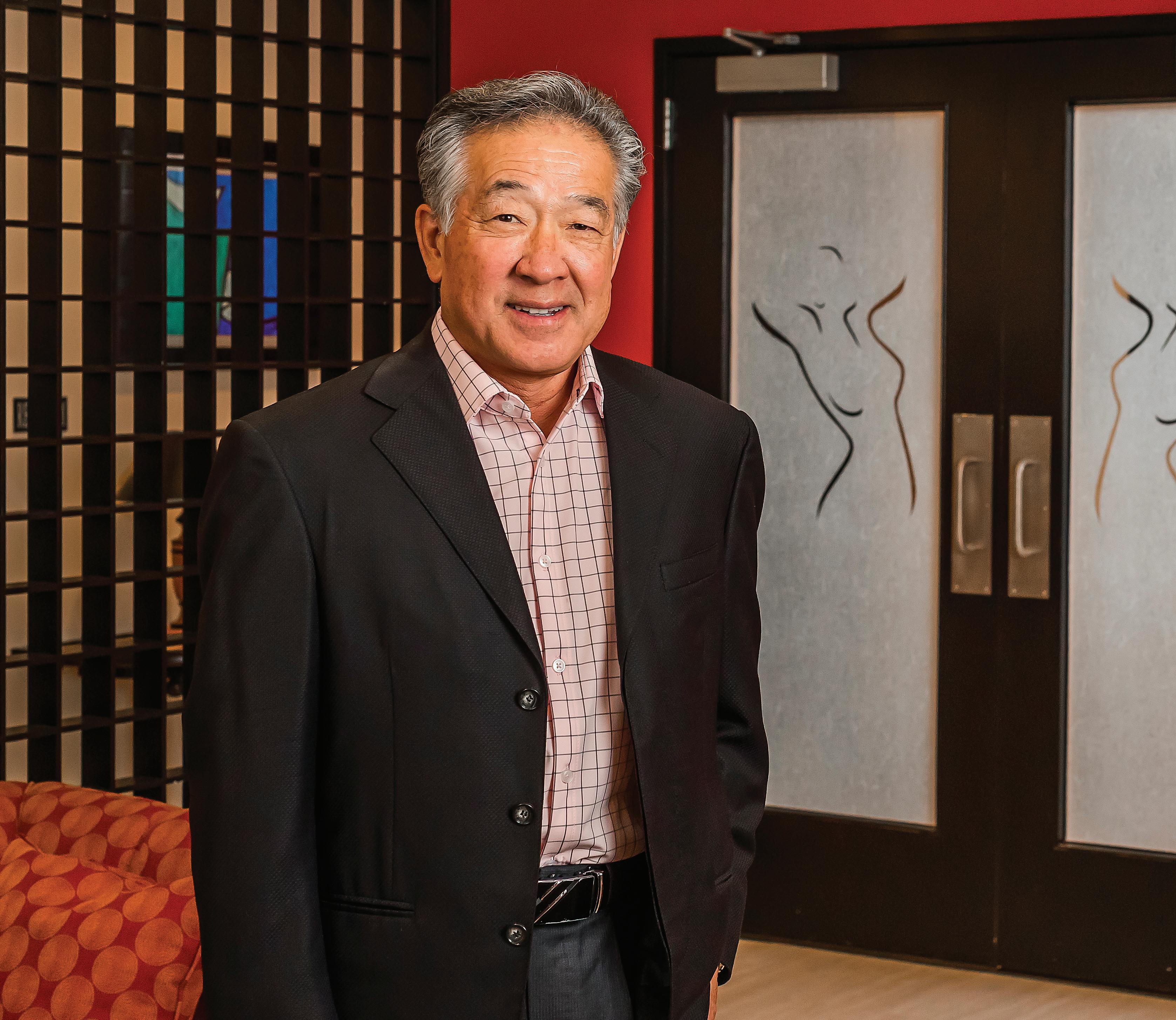
MEDICAL SPECIALTY: Cosmetic Surgery, specifically body contouring. EDUCATION/CERTIFICATIONS: Board Certified, American Board of Plastic Surgery. WHAT SETS THEM APART: With over 30 years of experience as a board-certified plastic surgeon and cosmetic enhancement expert, Dr. Nakamura offers a warm, personalized approach for each patient from consultation to aftercare. Dr. Nakamura places patient safety, comfort, and satisfaction at the foremost of his practice to ensure the best possible experience and aesthetic outcome. SERVICES: Accent on You practice has a fully accredited, free-standing surgery center in the building along with a medical spa that specializes in injectables, chemical peels, and other treatments. HOW THEY CONTRIBUTE TO OVERALL WELL-BEING OF CLIENTS: Dr. Nakamura understands that every patient’s cosmetic and health goals are as unique as their personality, and that’s why he takes a personal approach to every patient. PICTURED: Dr. Y. Anthony Nakamura.
Accent on You
3030 South Cooper St. Arlington, Texas 76015
817.417.7200
accentonyou.com
Cityview Audiology & Hearing Aids
Dr. Diane Blaising and Dr. Rachel Ruiz

MEDICAL SPECIALTY: Audiology, hearing aid prescription and fitting; expert advice in hearing aid technology comparisons; tinnitus evaluation and treatment; cognitive brain health screening. EDUCATION/CERTIFICATIONS: Dr. Diane Blaising – Doctor of Audiology, A.T. Still University for Health Sciences. Dr. Rachel Ruiz –Doctor of Audiology, The University of Texas at Austin; Certification in Tinnitus Management by The American Board of Audiology. Dr. Reagan Moody – Doctor of Audiology, The University of Texas at Dallas. WHAT SETS THEM APART: We offer tinnitus treatment options and a cognitive brain health screening. Hearing loss is one of the major contributing comorbidities and one of the top nine modifiable risk factors for cognitive decline. Studies show that treating a hearing loss with hearing aids may improve cognitive function in as little as six weeks, as measured with this tool. HOW THEY CONTRIBUTE TO THE OVERALL WELL-BEING OF PATIENTS: Improving our patients’ cognitive abilities is a focus of our practice. FREE ADVICE: Have a baseline hearing test when you are 50 years old. In the future if you experience hearing loss, it is a reference point to your earlier hearing status. Also, there is treatment for tinnitus. Many of our patients have found relief from that ringing in their ears.
PICTURED: (front, left to right) Dr. Rachel Ruiz, Dr. Diane Blaising, Dr. Reagan Moody.
Cityview Audiology & Hearing Aids
7801 Oakmont Blvd., Ste. 109 Fort Worth, Texas 76132
817.263.1800
cityviewhearing.com
info@cityviewhearing.com
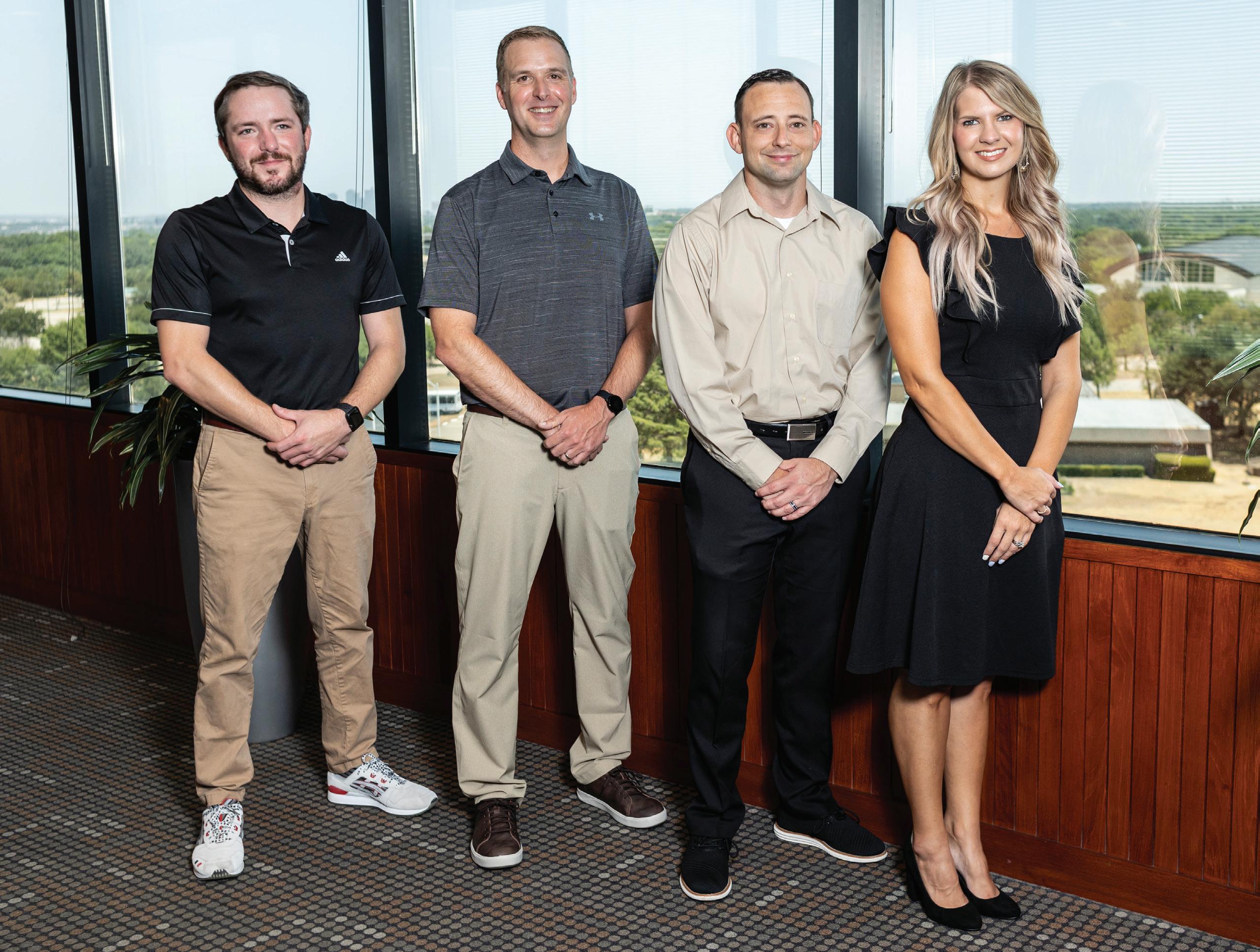
MEDICAL SPECIALTY: Neurology Headache Medicine. EDUCATION/CERTIFICATIONS: Dr. Peter O’Carroll – MD, Louisiana State University School of Medicine; APBN Board Certified in Neurology and Neurophysiology. Andrew LaVear, PA-C – Added Qualification in Headache Medicine. MEMBERSHIPS/AFFILIATIONS: Dr. O’Carroll – Member of the American Academy of Neurology (AAN) and the National Headache Foundation. Andrew LaVear – American Headache Society, International Headache Society, Southern Headache Society, Texas Associations of Physician Assistants, American Associations of Physician Assistants, National Headache Foundation, Military Officers Associations of America. GREATEST PROFESSIONAL ACHIEVEMENTS: Dr. O’Carroll’s greatest accomplishment has been marrying his wife, Kelly, while they both attended medical school and providing more access to quality neurology care for patients in the Greater Fort Worth area. LaVear’s greatest professional achievement has been obtaining his Added Qualification in Headache Medicine and opening the only headache-focused center in Fort Worth and starting a family. INNOVATIONS: Infusion therapy for migraine attack and migraine prevention. UNIQUE PATIENT CARE: We treat patients like they’re family; we understand our patients’ struggles and are here to listen and treat each patient to the best of our abilities. FREE ADVICE: If you’re having more than two headaches a month, it isn’t normal, and it should evaluated. PICTURED: (left to right) Chad Roth, BS, MA; Peter O’Carroll, MD; Andrew LaVear PA-C, AQH; Brittany LaVear, Practice Manager.
CowTown Headache
4055 International Plaza, Ste. 660 Fort Worth, Texas 76109
817.592.8427
cowtownheadache.com
brittany@cowtownheadache.com

SPECIALTY: Fort Worth Snoring and Sleep Center is limited to the treatment of snoring, sleep apnea, and TMD. EDUCATION: Baylor College of Dentistry, DDS in 1985. HONORS: Fellow with American Academy of Craniofacial Pain; Diplomate with American Board of Craniofacial Dental Sleep Medicine. MEMBERSHIPS/AFFILIATIONS: Member of Texas Dental Association, American Dental Association, American Academy of Dental Sleep Medicine, American Academy of Craniofacial Pain, American Academy of Orofacial Pain. GREATEST PROFESSIONAL ACHIEVEMENT: Achieving board certification in Dental Sleep Medicine. UNIQUE PATIENT CARE: We give patients an option to treat their snoring or sleep apnea without the use of a CPAP machine and almost always without requiring patients to sleep overnight in a sleep lab. Most major health insurance policies cover the treatment. FREE ADVICE: Don’t believe snoring is just a nuisance. It is usually a sign of a potentially deadly disorder called sleep apnea. PICTURED: Dr. Mitch Conditt.
Fort Worth Snoring and Sleep Center
451 University Drive, Ste. 102
Fort Worth, Texas 76107
817.527.8500
fortworthsnoringandsleepcenter.com
office@fortworthsnoringandsleepcenter.com

MEDICAL SPECIALTY: Obstetrics and Gynecology. GREATEST PROFESSIONAL ACHIEVEMENTS: Everyone participating in client care at Grace Obstetrics & Gynecology has expertise in their field and contributes to an environment of safe and respectful care. As care providers, it is a privilege to be invited to be a part of the experiences that women have bringing their baby into the world.
PROFESSIONAL MEMBERSHIPS/AFFILIATIONS: American Board of Obstetrics and Gynecology; American College of Obstetricians and Gynecologists. UNIQUE PATIENT CARE: Grace Obstetrics & Gynecology offers a modern model of health care for women. Whomever you prefer to work with on our staff of providers, you will experience consistent, compassionate, evidence-based care. Our providers serve women at two office locations (in Southwest Fort Worth and Granbury) and provide delivery and hospital care at their Texas Health Southwest location. FREE ADVICE: Find an OB that you trust and who is willing to partner with you to work toward your desired birth experience. Make sure you feel heard and respected throughout your pregnancy. We strive to provide this kind of care with each of our patients at Grace. PICTURED: Alyson B. Pico, D.O.; Madeline Manning, D.O.; Steven A. Suba, M.D.; Elise Rex, M.D.; Michelle Arevalo, M.D.; (not pictured) Leslie Phillips, M.D.
Grace Obstetrics & Gynecology 6100 Harris Parkway, Ste. 140 Fort Worth, Texas 76132
817.776.4722
Fax 817.984.5434
1200 Crawford Ave., Ste. A Granbury, Texas 76048 817.776.4722
Fax 817.984.5434
graceobgyntx.com

SPECIALTY: Ophthalmology: Cataract Surgery, Premium Lens Implants (Toric Lens, PanOptix, Vivity, Tecnis Symfony), Diseases of the Retina and Vitreous, Diabetic Retinopathy/Lasers, Macular Degeneration, Glaucoma Treatment.
EDUCATION: B.A., magna cum laude, Harvard University, 1986; M.D., University of Texas Southwestern Medical School, Dallas, 1990; Ophthalmology Residency, University of Kansas Medical Center, Kansas City, 1995; Vitreoretinal Fellowship, Massachusetts Eye and Ear Infirmary, Harvard Medical School, Boston, 1997.
CERTIFICATIONS: Board Certified, American Board of Ophthalmology. AWARDS: Physician’s Recognition Award, American Medical Association. PROFESSIONAL MEMBERSHIPS: American Academy of Ophthalmology, American Society of Cataract and Refractive Surgery, Texas Ophthalmological Association, Texas Medical Association, Tarrant County Medical Society. AFFILIATIONS: Baylor Scott & White Surgical Hospital Las Colinas, Baylor Scott & White-Irving, Texas Health Presbyterian Hospital Dallas, Texas Health Surgery Center Arlington. PATIENT CARE: A commitment to excellence in eye care is enhanced by our outstanding, caring staff. Dr. Reinke is a uniquely talented surgeon who personally provides all preoperative and postoperative care.
Reinke Eye and Laser Center
1310 N. White Chapel Blvd. • Southlake, Texas 76092
817.310.6080 • Fax 817.310.6014
1916 Central Drive • Bedford, Texas 76021
817.283.6607 • Fax 817.283.2674
7433 Las Colinas Blvd. • Irving, Texas 75063
972.556.1915 • Fax 972.556.1877
reinke.southlake@gmail.com dfwlasercataract.com
Martin Reinke, M.D.

MEDICAL SPECIALTY: Weight Loss, Nutrition and Fitness consulting. WHAT SETS THEM APART: SciFit Center’s all-encompassing program includes no pills, powders, or gimmicks, with weekly one-on-one appointments directly with Dr. Bryce and Ashley. They address all the components of a healthy lifestyle including nutrition, exercise, hormonal balance, musculoskeletal health, and balancing healthy eating habits with indulging in the foods you love. Together, they make a great team that provides the necessary components of an extremely effective program. SERVICES: SciFit Center takes a new age approach toward weight loss, nutrition and wellness by integrating 3D Body Composition Scanning, Food Sensitivity, and DNA testing. They provide personalized, all-encompassing programming that’s effective and sustainable. HOW THEY CONTRIBUTE TO CLIENT’S WELL-BEING: Weekly consultations help you stay accountable as well as provide constant guidance and education throughout your entire program. There’s no such thing as a one-size-fits-all approach, and SciFit helps you discover the unique methods that work best for your body type. FREE ADVICE: When it comes to weight loss, there are so many different philosophies out there. From keto or paleo to intermittent fasting, the selections can become quite overwhelming. The most efficient way to make progress is to find something that works well for you, your body type, and preferences.
SciFit Center
2408 Forest Park Blvd. Fort Worth, Texas 76110
817.975.7583
scifitcenter.com
healthylife@scifitcenter.com
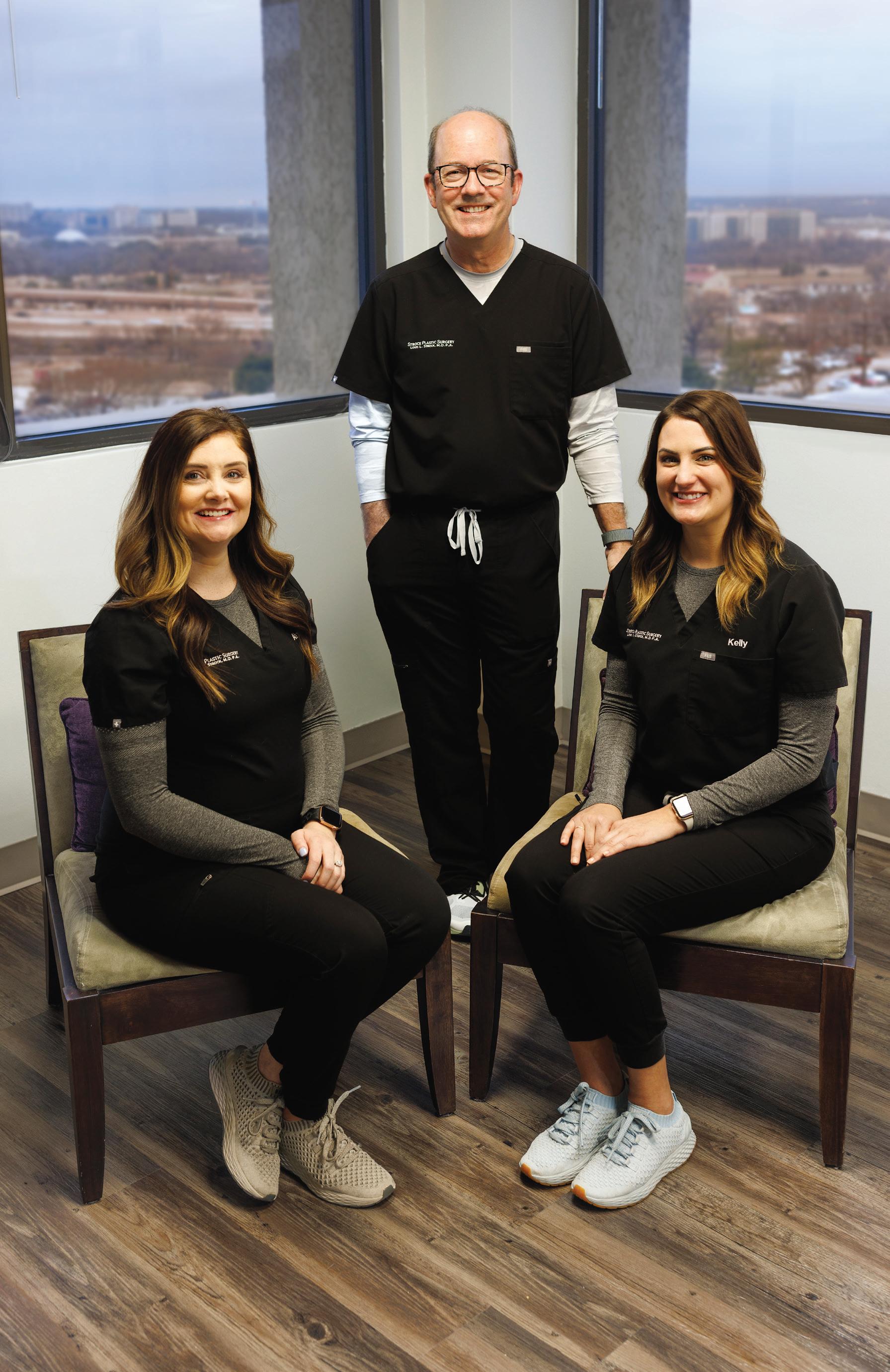
SPECIALTY: Cosmetic surgery of the breast, body and face, and breast reconstruction.
EDUCATION/CERTIFICATION: B.S., Amherst College; M.D. and residencies in Surgery and Plastic Surgery at UTMB Galveston; Board Certified by the American Board of Plastic Surgery. MEMBERSHIPS: The Aesthetic Society, American Association of Plastic Surgeons, ASPS, TSPS. INNOVATIONS: Dr. Strock is an internationally recognized authority on breast implant surgery. He is widely known for his expertise in the treatment of complications from previous breast implant surgery, including both implant replacement and removal with use of the patient’s own tissue to create optimal breast shape. He is well known for his expertise in first-time breast enhancement, including transaxillary endoscopic breast augmentation, an approach that allows patients to have silicone gel implants placed using a short incision in the armpit, avoiding any incisions on the breast. Dr. Strock teaches plastic surgeons in practice the latest concepts and techniques in breast implant surgery at The Aesthetic Society’s Annual Aesthetic Meeting and Sponsored Symposia. He has served as Traveling Professor for The Aesthetic Society and serves as clinical faculty at UTSW and president of The Aesthetic Surgery Education and Research Foundation. This dedication to education and his specialty gives him access to the latest information that he applies to help his patients. PICTURED: Patient Coordinator Alexx Rouse, Dr. Strock., and Clinic Coordinator Kelly Sheldon.
Louis L. Strock, M.D., P.A.
800 Eighth Ave., Ste. 606 Fort Worth, Texas 76104
817.335.1616
drstrock.com
Jerry Barker, Jr., M.D.
Nilan Naik, M.D.

SPECIALTY: Radiation oncology – the treatment of adults with cancer using radiation therapy.
EDUCATION/CERTIFICATIONS: Dr. Barker –UT Southwestern Medical Center (medical school); University of Washington Medical Center (residency); MD Anderson Cancer Center (fellowship); board certified in radiation oncology by the American Board of Radiology; board certified in hospice and palliative medicine by the American Board of Internal Medicine. Dr. Naik – UT San Antonio Medical Center (medical school); University of Texas Medical Branch at Galveston (residency); board certified in radiation oncology by the American Board of Radiology. AWARDS/HONORS: Although our staff has received many formal awards for research, patient care, and teaching, our greatest honor is from our patients who routinely give us perfect scores for customer service.
GREATEST PROFESSIONAL ACHIEVEMENTS: Without question, our greatest achievements are the cancer survivors our team has been humbly able to serve. We are so proud of you!
UNIQUE PATIENT CARE: With more than 140 years of combined experience caring for cancer patients, our team of oncology professionals routinely assist with multidisciplinary care with other oncology providers and practices across the region. We believe our patients should have world-class, cutting-edge cancer care without having to travel beyond North Texas to get it.
PICTURED: (back, left to right) Nilan Naik, M.D., and Jerry Barker, Jr., M.D.; (front, left to right) Kelly Gutowski, Melody Hendrix, Beth Beavers, and Dana Diabmarzouk.
Texas Cancer Specialists
6801 Oakmont Blvd., Ste. 101 Fort Worth, Texas 76132
817.438.0259
TexasCancerCares.com


Baylor Scott & White Neurosurgery and Spine Associates
MEDICAL SPECIALTY: Neurosurgery. EDUCATION/ CERTIFICATIONS: Medical School, University of Mississippi School of Medicine; Internship and Residency, UT Southwestern Medical Center; Fellowship, Spine Surgery, UT Southwestern Medical Center; Board Certification, American Board of Neurological Surgery. GREATEST PROFESSIONAL ACHIEVEMENTS: Consistently rated as a top doctor in the community, I receive word-of-mouth referrals to see prior patients’ family members and friends. INNOVATIONS: Whenever possible, I try to recommend motion-sparing surgery, including artificial disc replacement. UNIQUE PATIENT CARE: So many patients tell me that they have never actually met their surgeon — only his or her assistant(s). I have built my practice from the ground up to be able to see every patient, every time, myself.
Baylor Scott & White Neurosurgery and Spine Associates
1400 Eighth Ave., Ste. A1131 • Fort Worth, Texas 76104
817.912.9250 • NeurosurgeryAssociates.com
Physician is an employee of HealthTexas Provider Network, a member of Baylor Scott & White Health. ©2022 Baylor Scott & White Health.
Baylor Scott & White Signature Medicine – Fort Worth
SPECIALTY: Concierge Medicine. EDUCATION/ CERTIFICATIONS: Drs. Craig Kneten and James A. Murphy – Medical School, UT Health Science Center at Houston; Internship & Residency, John Peter Smith Hospital; Board Certification - American Board of Family Medicine. UNIQUE PATIENT CARE: As full-service concierge doctors, we provide you with private, attentive primary care services at an affordable annual rate. We keep our patient list relatively small, which allows us to give you and your family the attention you deserve. With concierge medicine, you have access to many services beyond those offered through a traditional practice, some of which include a personalized wellness exam, enhanced availability and communication, and specialist referrals and care coordination. PICTURED: Craig Kneten, M.D., and James A. Murphy, M.D.
900 W. Magnolia Ave., Ste. 202 • Fort Worth, Texas 76104 817.912.8090 • BSWHealth.com/SigMedFtWorth
Physicians are employees of HealthTexas Provider Network, a member of Baylor Scott & White Health. ©2022 Baylor Scott & White Health.
Young professionals from across the metroplex attended the Fort Worth Chamber’s 2022 YP Summit, presented by Wells Fargo. The afternoon micro-conference featured conversations on professional development, personal growth, and community involvement.

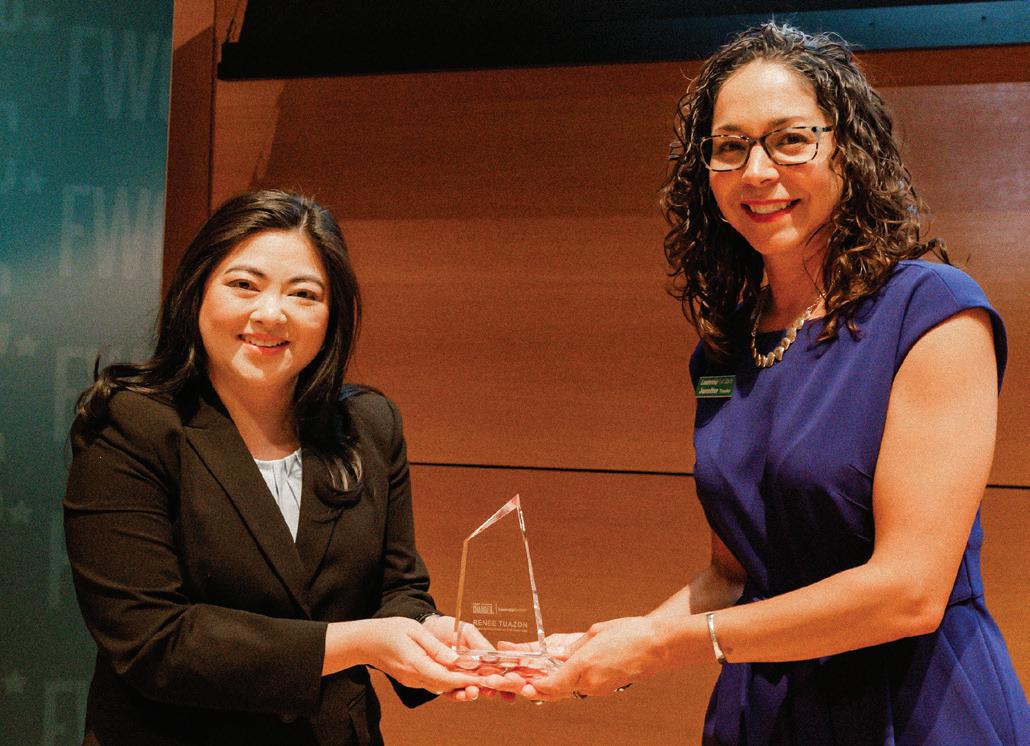
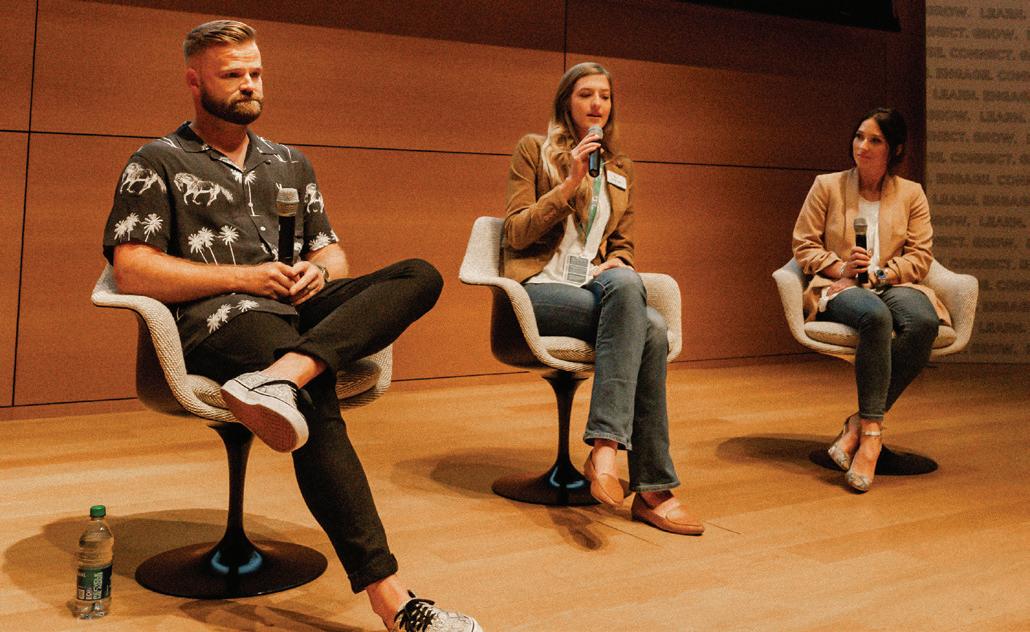

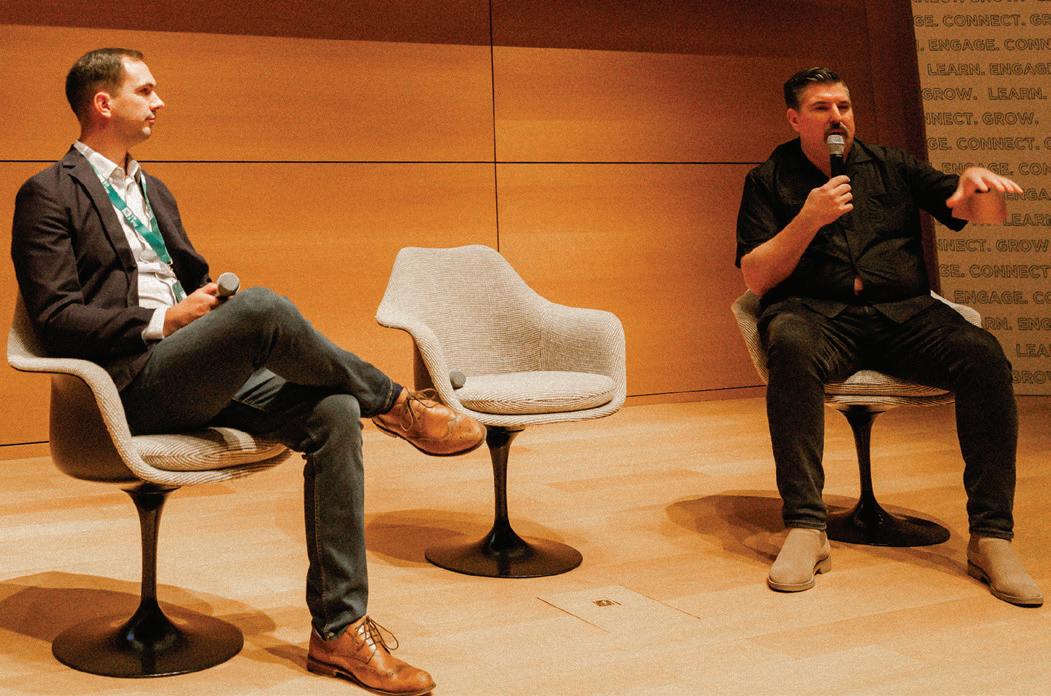
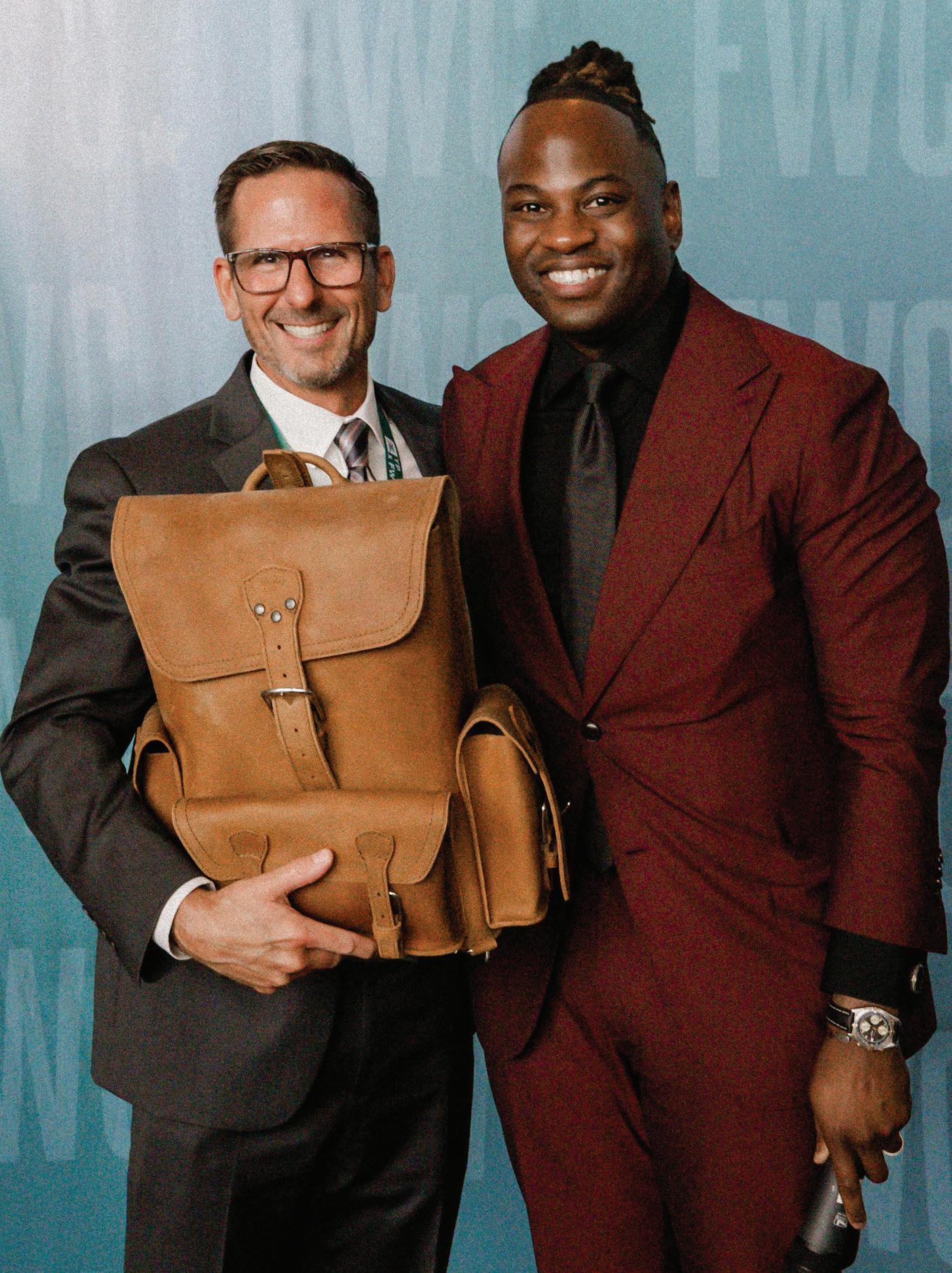


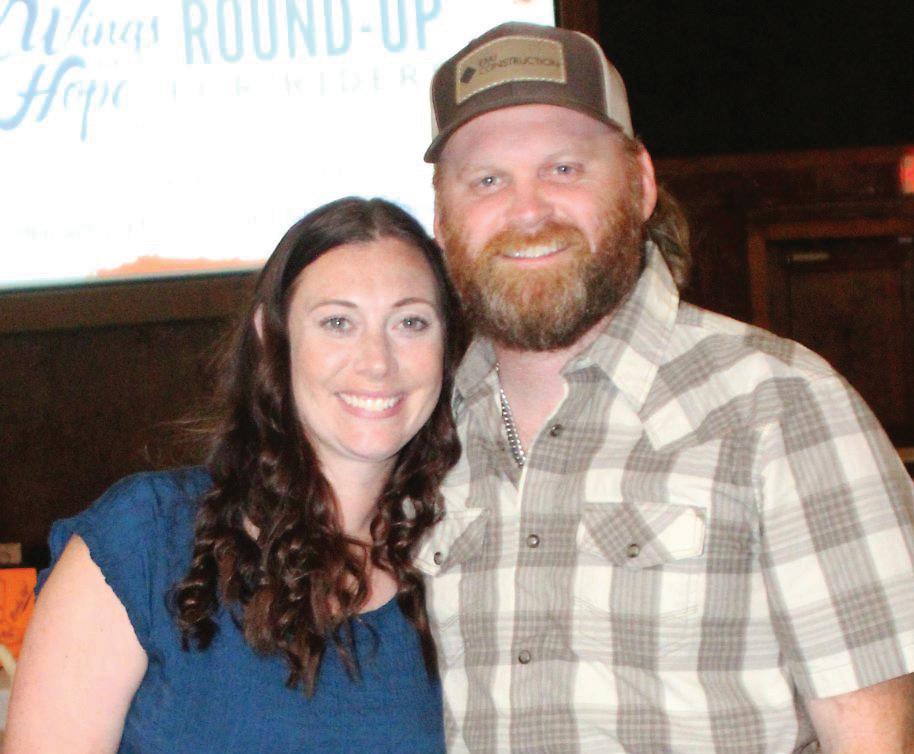
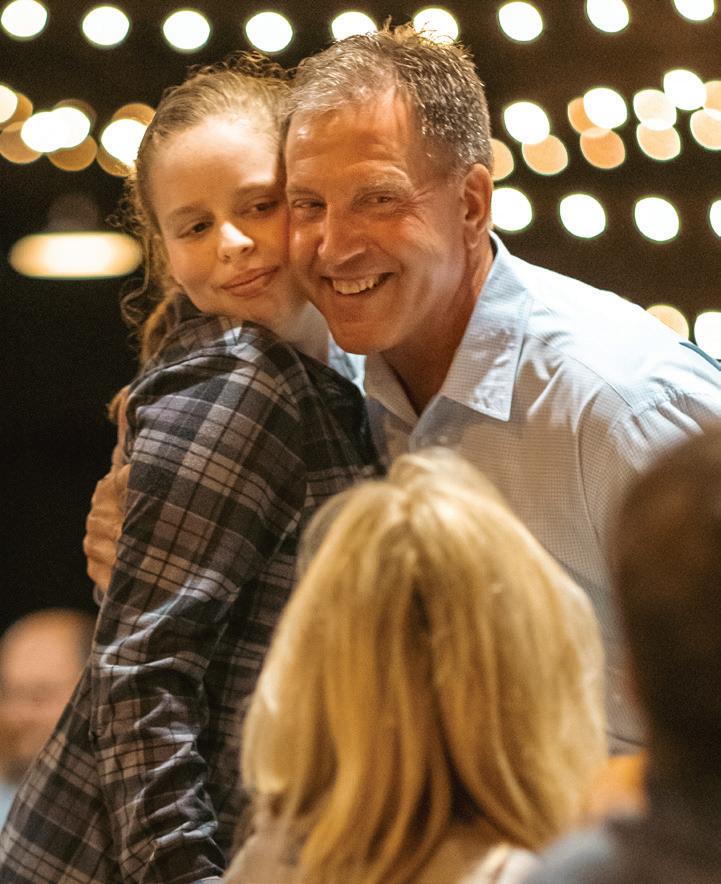
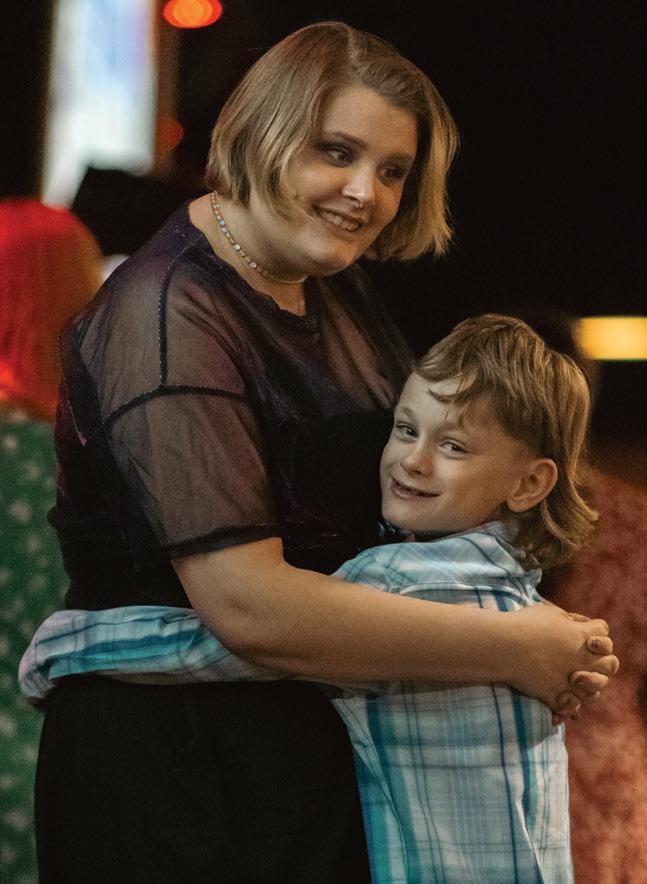


On Aug. 5, Wings of Hope hosted its annual Party with a Purpose event, Round-Up for Riders, at River Ranch Stockyards in Fort Worth. This event benefits the Wings of Hope Equestrians and Equine Service Partners. The night began with Texas cuisine and music provided by Dan Quinn of DQB Entertainment. The night’s master of ceremonies was Malone Lankford from 95.9 The Ranch. Guests participated in games, old-time photos, a silent auction, and a live auction.
There’s nothing more rewarding than giving back and making a difference in the lives of people in this great community. As the city’s magazine — which has the eyes and ears of some of Fort Worth’s most affluent and philanthropic citizens — we feel a responsibility to give back to the people of the city that is our namesake, which is why Philanthropy is one of our core values.
Every year, Fort Worth Magazine sponsors more than 100 charity events, which range from luncheons to black-tie galas. The following promotional section is devoted to these charities and their fundraisers. We invite you to consciously peruse and consider lending a helping hand by either making a donation or attending these events.
OCT. 1
The Party in Fort Worth 2022
Fort Worth Promotion & Development Fund
OCT. 6
Desert Rose Luncheon, Fashion Show, and Shopping 2022
National Cowgirl Museum and Hall of Fame
OCT. 6
37th Annual Luncheon
Texas Women’s Foundation
OCT. 12

Signature Chefs Auction 2022
March of Dimes
OCT. 13
Youth of the Year Gala 2022
Boys & Girls Clubs of Greater Tarrant County
OCT. 13
Feast in the Fort Parenting Center
OCT. 13-16
Christmas in Cowtown
The Junior League of Fort Worth
OCT. 14
Monster Mash 2022
The Women’s Center
OCT. 14
Day of the Girl
Girls Inc.
OCT. 15
Our Step Up for Down Syndrome 5K & Family Walk 2022
Down Syndrome Partnership of North Texas
OCT. 16
Cookin’ for Kids 2022
Kids Who Care
OCT. 19
Public Figures, Private Artists
The Art Station
OCT. 21
Bras for a Cause
Bras for a Cause
OCT. 21-23
Art Worth Fest
Art Worth
OCT. 22
Passport with a Purpose 2022
Alzheimer’s Association
OCT. 25
Heart for the Homeless 2022
Union Gospel Mission
OCT. 29
Wings for Wishes 2022
a Wish with Wings

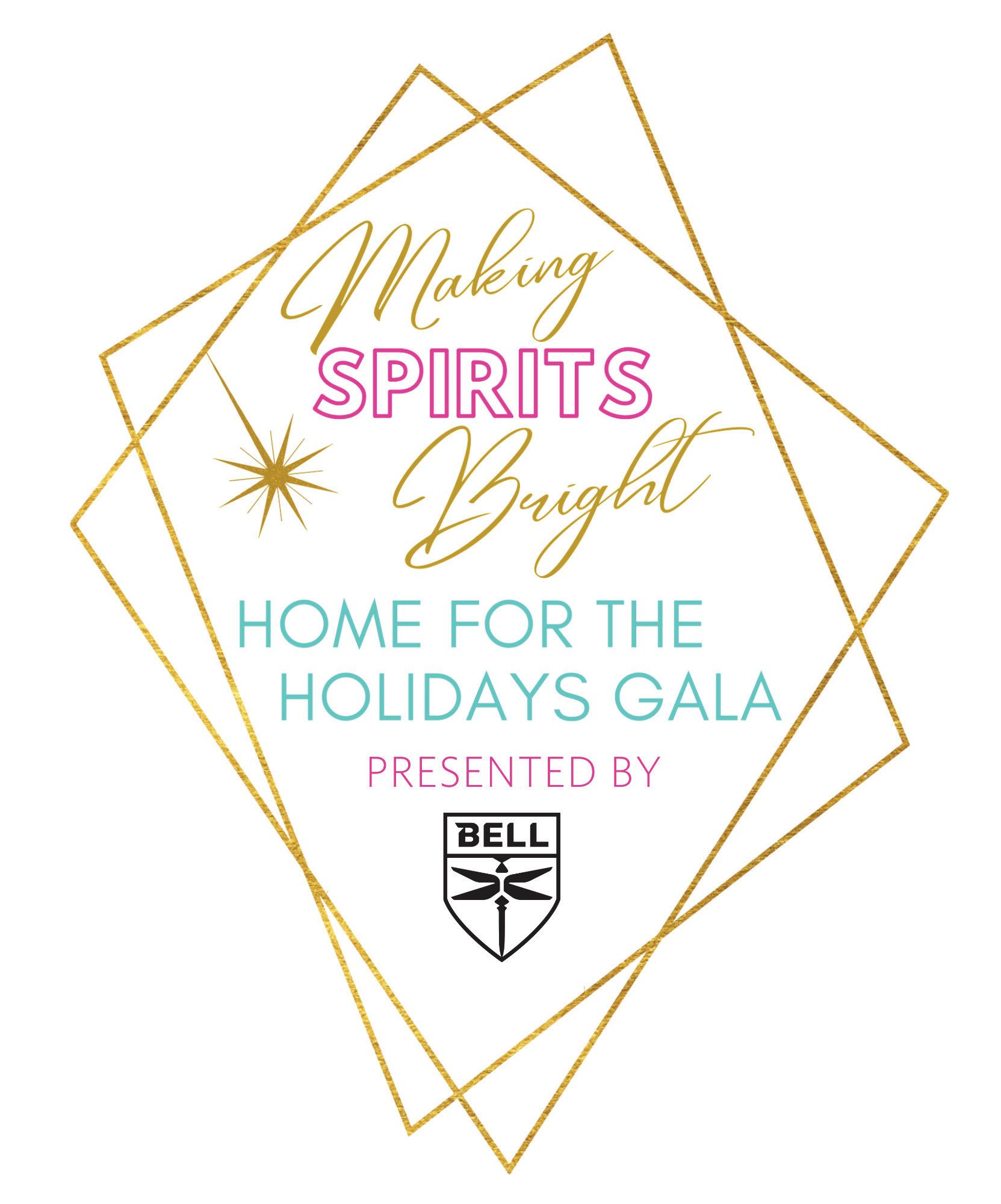
THANK YOU TO OUR GENEROUS SPONSORS!
PRESENTING
BELL
POINSETTIA
Jere C. Robertson
Virginia Street Smith
HOLLY
BNSF Railway
Jim Lacamp
Carol Sweeney
Tug Hill
MISTLETOE
Mike and Susi Bickley
BrevAll Technologies, Inc.
Frost
Rev. Dr. Kevin and Dr. Robin Henson
Luther King Capital Management
JJ and Steven Magsig
Frank W. Neal
Jamie Rambo
Michele and Fred Reynolds
The Rios Group
Burch and Lisa Waldron
IVY
Carol Adcock
Charity and J.T. Aughinbaugh
Baird – The Ryan-Jones Group
Balcom Agency
Barretts, Kilhoveneys, Newburns, Pressleys and Virdens
Dr. Jason Biggers and Kaci Roan
Bourland, Wall & Wenzel P.C.
Amy and Jason Brown
CLA
Deborah Connor
First Presbyterian Church of Fort Worth
Fort Worth Ladies of DAR
JPS Foundation
JPMorgan Chase & Co.
Kathy and Micky Severson
Matthew Loynachan
Meta Alice Keith Bratten Foundation
Claire and Herd Midkiff
QuikTrip
Sara and Matt Robison
Satori Capital
Mitch and Molly Snyder
Jodi and Todd Spake
For information about the event or sponsorships scan the QR Code

Courtney and Brian Tulbert
MEDIA SPONSORS
Fort Worth Magazine
The Video Zoo
ursday, October 6, 2022
11 a.m. - Noon: Silent Auction Noon: Luncheon, Fashion Show & Live Auction GIVE BACK
e Desert Rose Lunchen will be held at River Crest Country Club. For further information, contact the National Cowgirl Museum (817) 336-4475









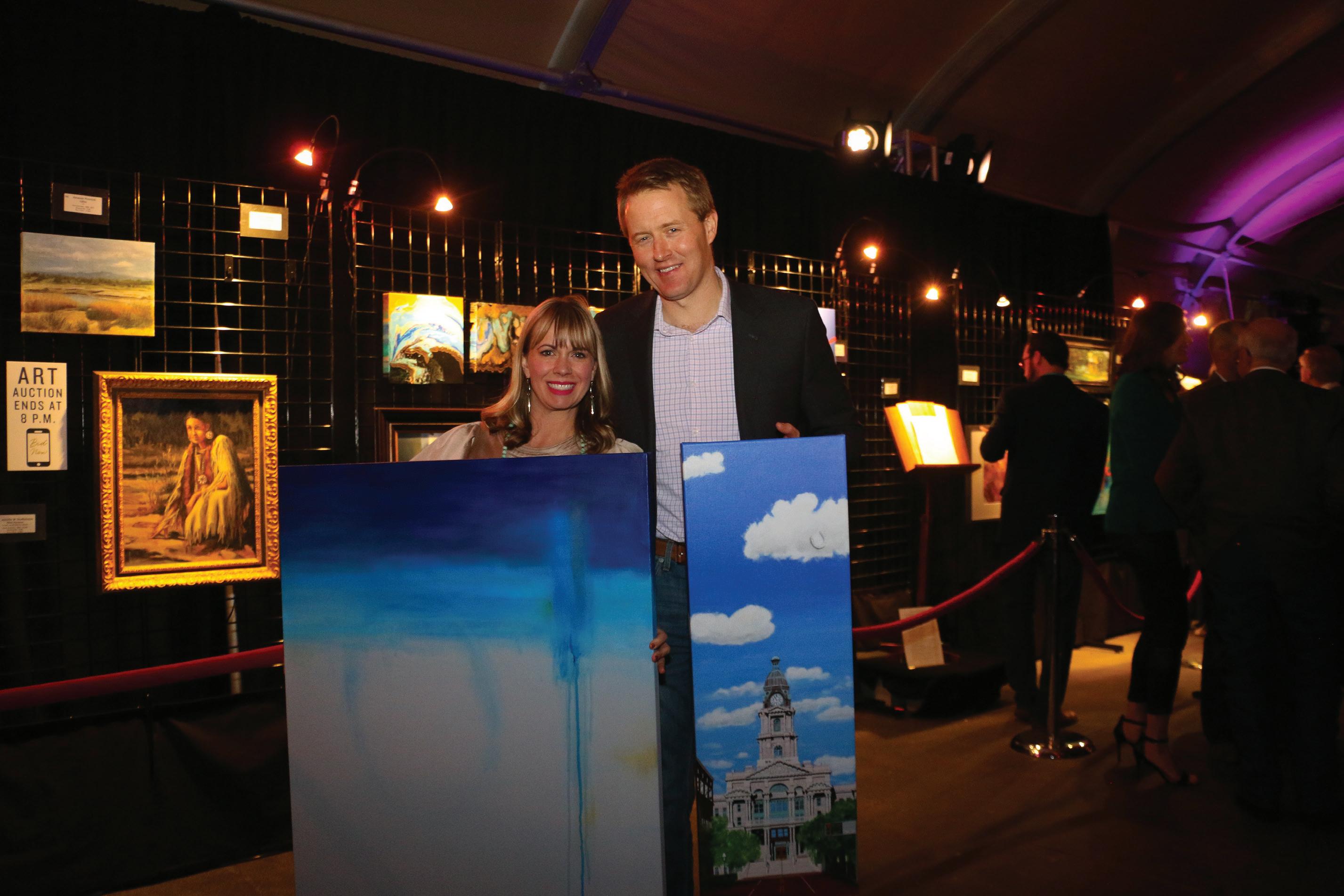





O ct O ber 13 - 16, 2022 | Will Rogers Memorial Center
We would like to thank our sponsors for their support and generosity!

Champion
The Robert Brockway Family
Amber & Troy Robertson Fort Worth Magazine
Ambassador
Baylor Scott & White All Saints Medical Center Fort Worth
Williams Trew • J.P. Morgan Private Bank
Texas Health Resources Foundation
Jean Roach, Amy Bailey & Lori Davis
The Ryan Foundation

Clara & Samson Cantu • Carrie Cappel & Natalie Martin
Gail W. Rawl • Glenda Diaz-Keller Williams Realty
JLFW Board of Directors 2022-2023 • Melissa Taylor
Lawrence, Marlow, Pate, Tuomey & Wright • Nan Matson

Vantage Bank Texast • Olivia Kearney
Tarrant Property Tax Service
Partner Frost
Bank of Texas • Kim & Glenn Darden • Jana Poland
Becky & Taylor Escott • HUB Fort Worth • Suzie Russell Fort Worth Primary Care • Junior League Gems
Martha V. Leonard • Luther King Capital Management
The Northern Trust Company • Blackbeard Operating, LLC
Lindsey & Ron Hopton-Jones • Janeen Lamkin
Peggy Sims/Steamatic DFW & Jane Sykes
The Robinson Petronis Group of Baird Private Wealth
Management • Texas Christian University
*Sponsorships still available.*


Discover Original Artwork Created and Donated by Business and Community Leaders
Wednesday, October 19, 2022
5:30-8:30pm
Fabulous Hors d’oeuvres, Desserts, Specialty Cocktails, Wine & Beer
Live Music . Silent & Live Auction
Historic Masonic Center
1100 Henderson Street (at West Lancaster), Fort Worth, Texas

Providing art therapy Breakthroughs to create better lives for children, teens & adults.
D Questions? Email pmarshall@theartstation.org

Presenting Sponsor: Byrne Construction Services
Picasso Patron: Integrated Transfer Services
Monet Masters: Stacy & John McKnight
Creative Champions: Melinda & Jerry Johnston . Jim Lacamp
Artful Advocates:
Mica Bergman . Frost . Laura Haskin . Katie & Mark Kalpakis
Kitty & Cleve Lancaster . Lane Gorman Trubitt . PNC Bank
Reads Jewelers, Inc. . Republic Services . La Vonne Scharbauer
Lee L. Tennison . The Human Source Foundation . Nancy & Richard Wilson
Palette Partners:
Amarillo National Bank . Kelly Hart . Hillwood . La Playa Maya Restaurants
Peggy Marshall . Susan Motheral . Elia & Al Saenz . Sibilsky & Associates
Susser Bank . Tactical Systems Network . Dawn & Andy Taft
Texas Health Harris Methodist Hospital Fort Worth
The Martha Williams Group/Williams Trew
In-Kind Sponsors: Acre Distilling . Rahr Brewing
FEATURED ARTISTS
Dianne Arnette
Jane Avila
Jim Beckman
Jason Boone
Becky Renfro Borbolla
Eddie Broussard
Greg Brown
Jinx Burk
Patricia Cole
Lisa Anderson Collins
Owen Daniel
Mary Margaret Davis
Rachael Delira
Brian Gladue
Kay Granger
Joy Harvison
Lee Herring
Jimmie Joe Jenkins
Jerry Johnston
Bradley Kent
Barry King
Jim Lacamp
Louis Lambert
Cleve Lancaster
Kitty Lancaster
Opal Lee
Alfred Lockwood
Rachel Malone
Boyd Matson
Tim McKinney
Stacy McKnight
Mike Micallef
Pam Minick
Bob Mitchell
Nancy Mitchell
Hope Montey
Steve Montgomery
Susie Monzingo
Eric Nelsen
Sainty Nelsen
Patrick Newman
Grace Nowlin
Susan Nus
Mary Palko
Mattie Parker
Beverly Powell
Eric Reed
Greg Riley
Felix Schilling
Mouty Shackelford
Christy Dunaway Smith
Dawn Taft
Lee L. Tennison
Andrew Walker
Carolyn Watkins
Stacey Watkins Martin
Ginter Watson
Jeff Wentworth
Mary Ann White
Juan Zamora

Congratulations, Yohana!

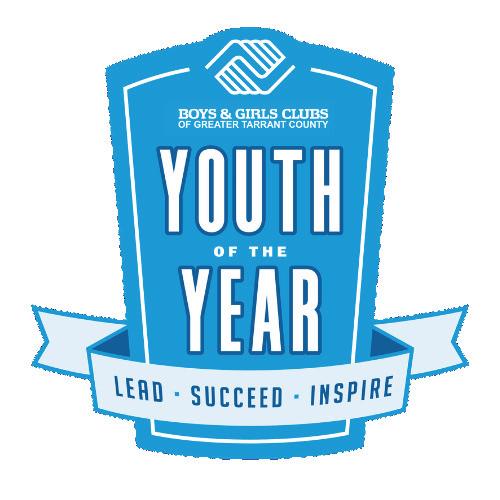
Boys & Girls Clubs of Greater Tarrant County’s service-learning programs, like Youth of the Year, focus on developing leaders who actively seek ways to improve their communities and demonstrate good character. These programs have a positive impact on academic outcomes, foster a sense of compassion for others, and provide opportunities to practice real-life skills.

Please join us on our mission of enabling all young people to reach their full potential.



Fred and Cheryl Moore
Alan and Sarah Bennett with Joe and Barbara Penshorn
Elizabeth Crofford
Ted and Delynn Crofford
Robert and Dawn Zuilhof
Toby and Jennifer Ardoyno with Toni Rose
Rickey and Ellen Brantley
The Christenberry Group
Linda Christie with Janeen Lamkin
Cam and Lynn Newman
John and Laura Rutledge
Alan and Roxanne Shipman
and Katie Ciccarino




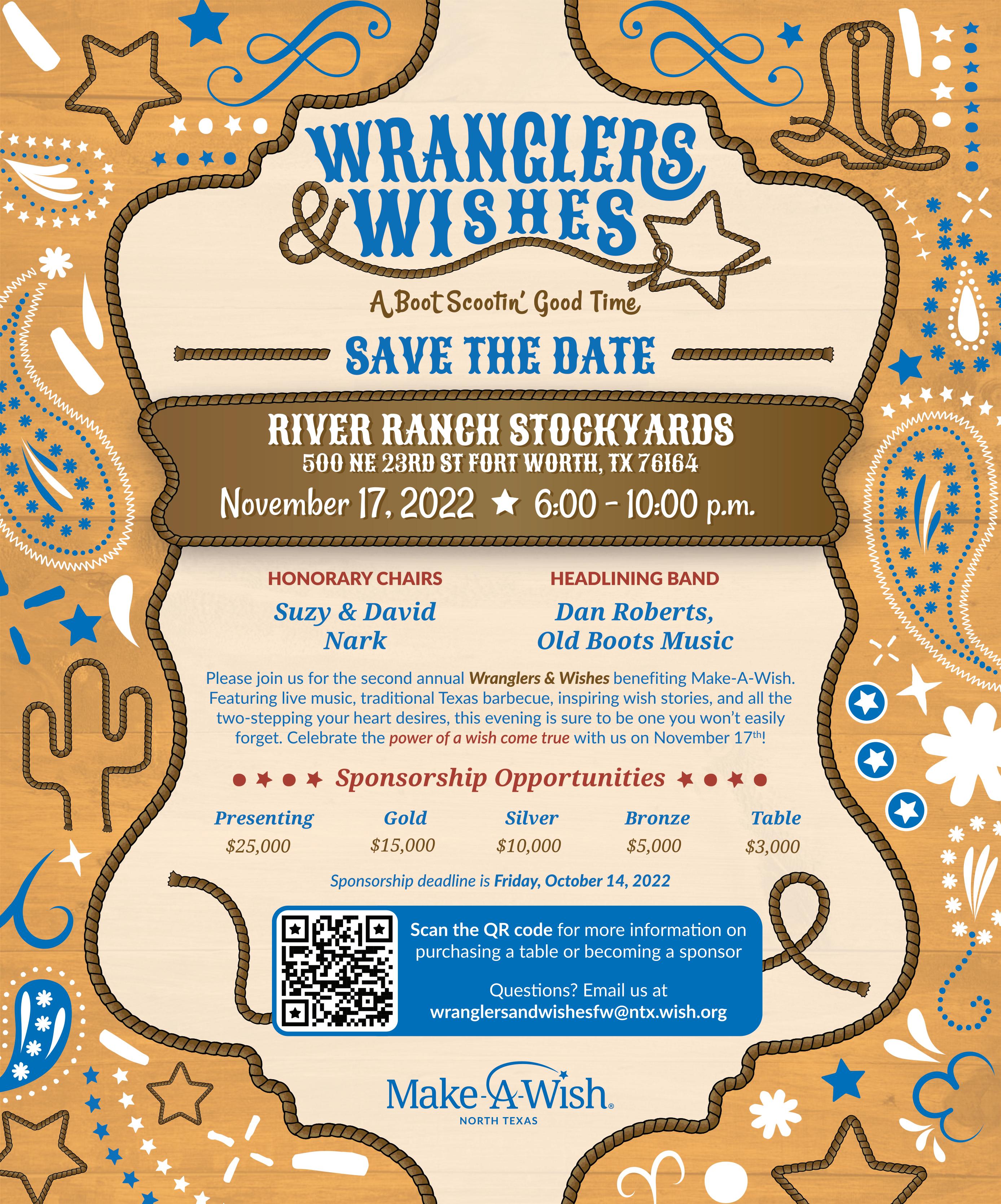


SPONSORS
Kelly Hart | Ramona & Lee Bass | Anne & Orlando Carvalho | Louella Martin
Advanced Mobile Filtration Services, LLC | Melinda & Steve Winn | Amegy Bank of Texas
American Airlines | Atmos Energy | Stephanie & Cody Baker
Bennett Partners Architecture Interiors Planning
Briggs Freeman Sotheby’s International Realty | Lockheed Martin
Luther King Capital Management | Tammy & Ty McKinney | JP Morgan Chase & Co.
Noel & David Nolet | PlainsCapital Bank & The Private Bank | REEDER Construction
Madolin & Ben Rosenthal | Judy & Brad Rupay | Trinity Healthcare
University of North Texas Health Science Center at Fort Worth Wagner, Tulbert & Doswell Families | Higginbotham/WhitneySmith
1600 GENDY STREET, FORT WORTH, TX 76107 fwmuseum.org | 817-255-9449
RESTAURANTS
Blue Goose Cantina | Bob’s Steak & Chop House Fort Worth | Fitzgerald | Galligaskins
Heim Barbecue | Pacific Table | Taco Heads | Mama’s Pizza - Fort Worth + Arlington
BEVERAGES
Acre Distilling Company | Ben E. Keith Company | Martin House Brewing Company
Neutral Ground Brewing Company | Tierra A Taza Co ee Cart
DESSERTS
The Cotton Kandy Factory | Nothing Bundt Cakes
ENTERTAINMENT
Charming Charlatans | Cowtown Paparazzi | DJ Tex
The Photo Bus DFW | Lockheed Martin Flight Simulator
Screen Printing + Tesla Demonstrations from Jimmy Joe Jenkins + Bradley Kent
MEDIA PARTNERS
Fort Worth Magazine | Arlington Today | What’s Up Fort Worth


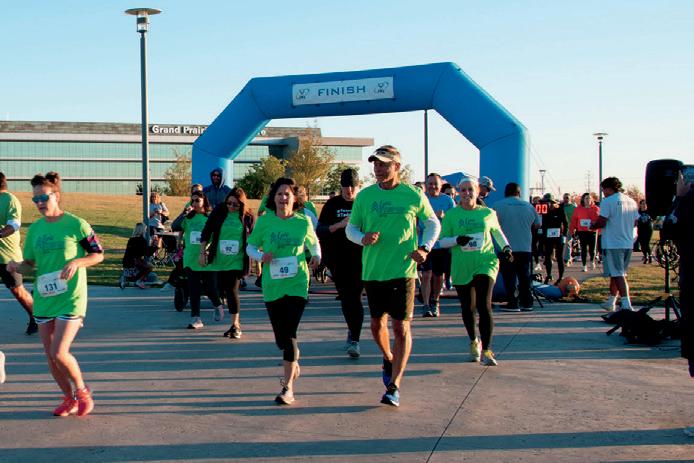
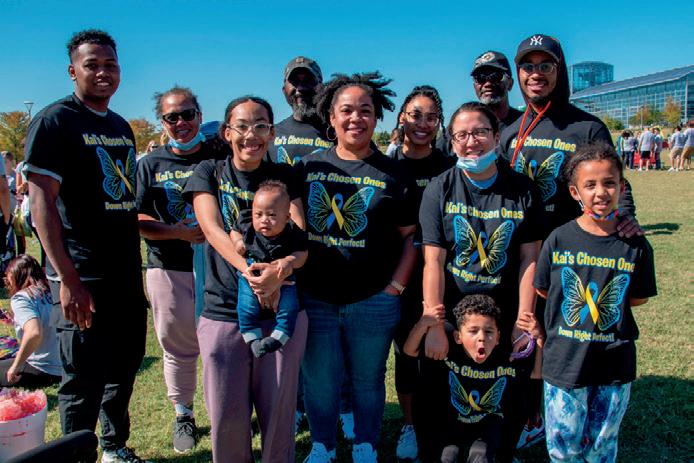
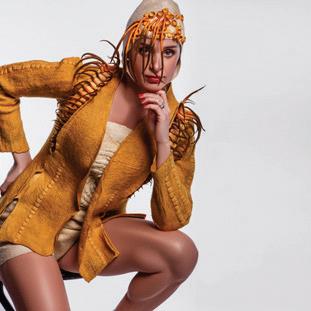



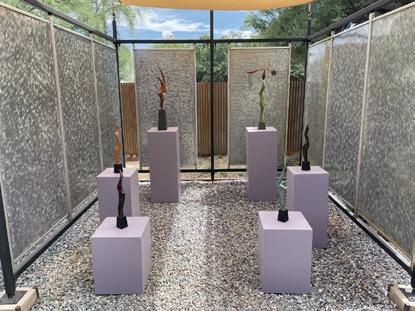




















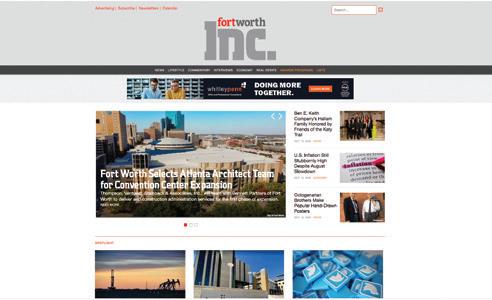







Near the intersection of Fabons and Rosedale streets on the city’s east side stands the image of a time gone by — the Grand Theater. The former movie theater, built in 1938, once served as a place where Black families could gather and watch movies during segregation. After the theater closed, a church and charitable arts organization took turns calling the unique structure home. Today, the building is mothballed and vacant, but glimpses of the building’s past life — like the vintage marquee on the facade — remain.
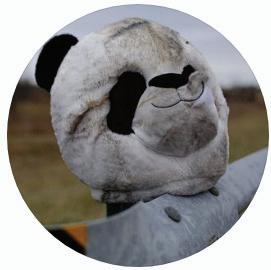
So you’ve snapped a cool pic of the city. We want to see it. Tag your photos on Instagram with #fwtxmag. The winning image will get published on this page — so hit us with your best shot. main line 817.560.6111 | subscriptions 800.856.2032 | website fwtx.com
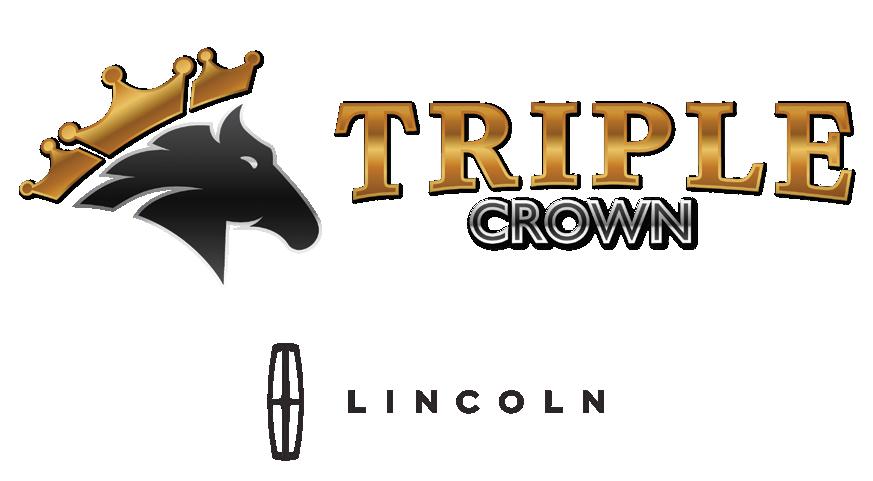
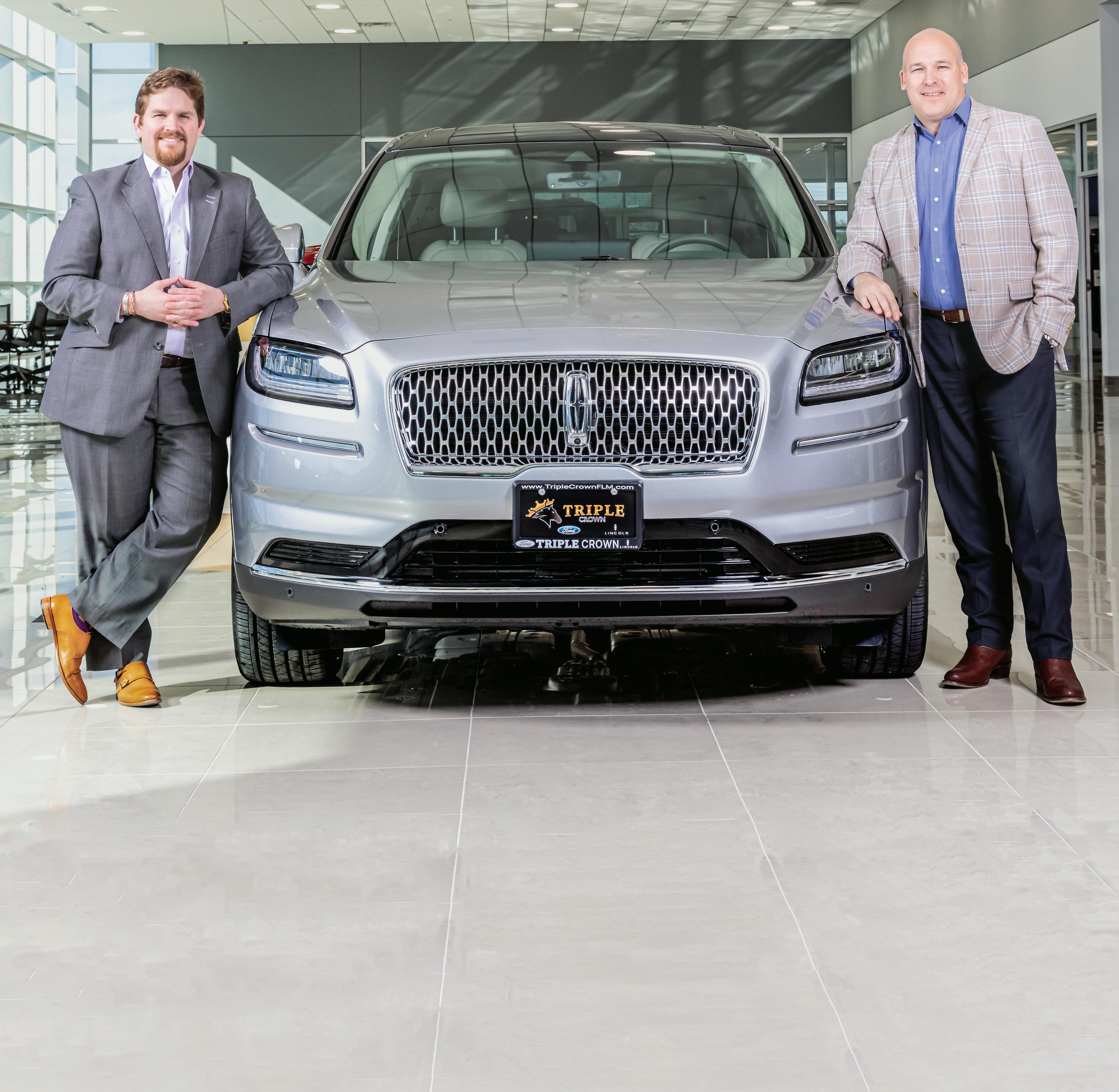

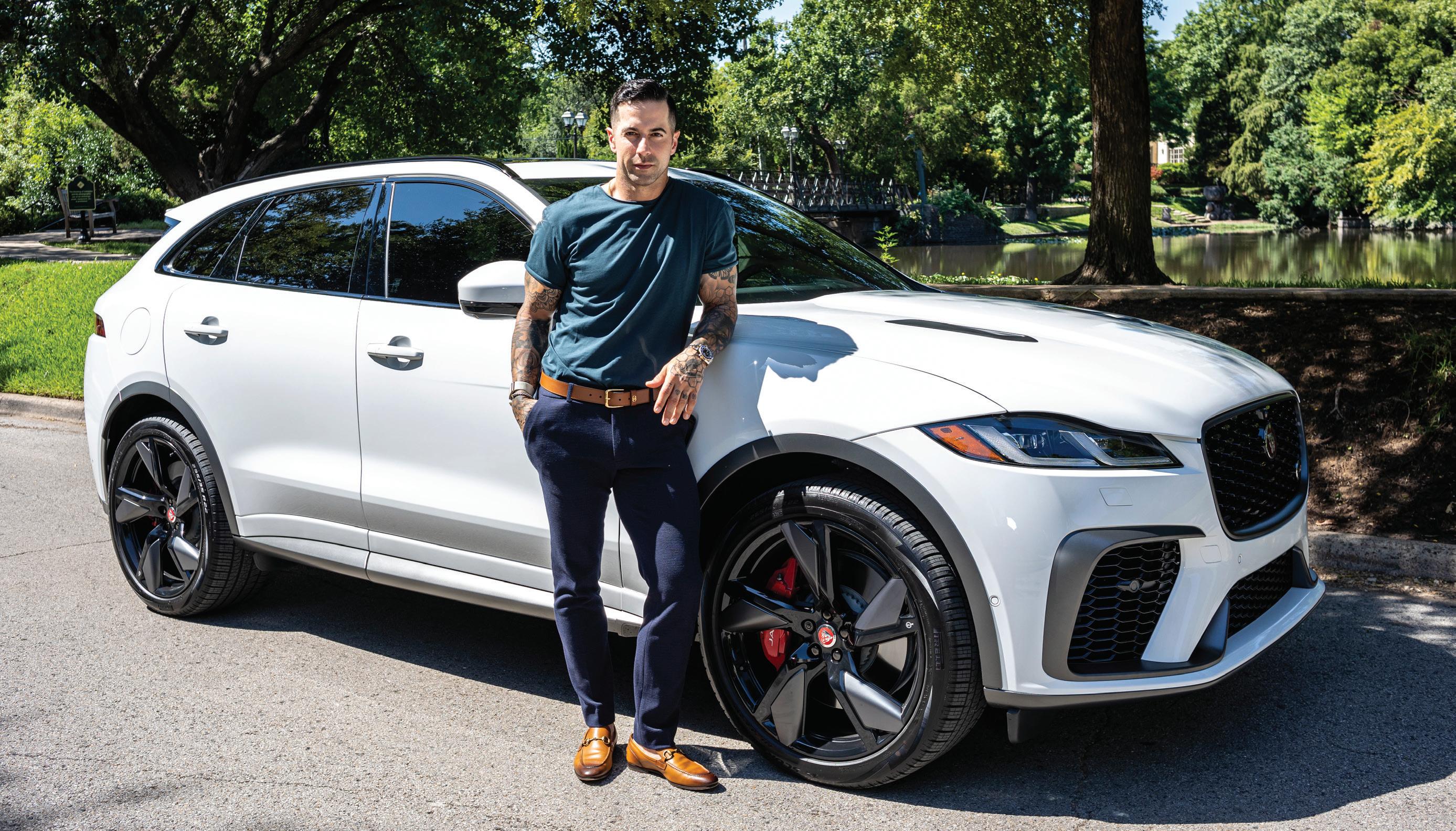
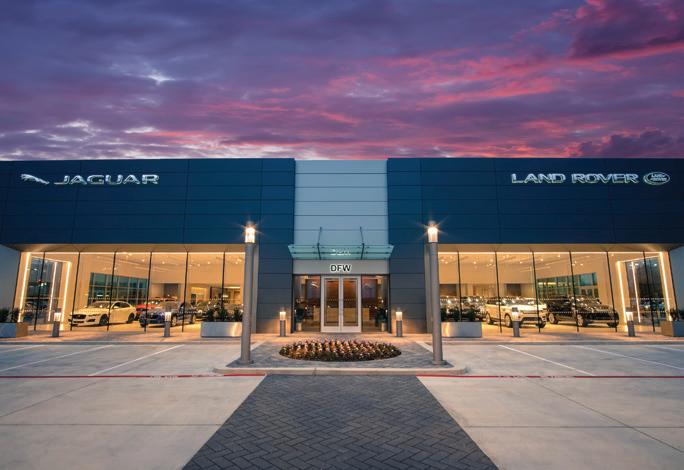
When DJ Guthrie is not touring the U.S. with one of his companies or in the office working on plans for expansion, he’s on the golf course. Owner of 300 Below Productions, LUX, and Ensō Dance Conventions, Guthrie is an avid golfer who says he finds his peace and disconnects whenever he has a club in his hands. “If you can’t find me at my desk or in an airport, you can find me teeing off somewhere,” he says. The golf-loving entrepreneur is also an avid fan of the Jaguar brand. “Nothing says luxury and performance like a Jaguar,” Guthrie says. “My company logo may be a wolf, but my vehicle will always be a cat.”
Since his dad worked for Jaguar for 35 years, Guthrie says, “I grew up appreciating the artistry, luxury, and appeal of a Jaguar automobile.” Guthrie’s current ride is a 2022 F-PACE SVR, the highly charismatic luxury performance SUV, from Jaguar Land Rover
DFW. “From the minute I walk through the doors, the team at Jaguar Land Rover DFW makes me feel like I’m their only client,” he says. “Park Place truly is My Place, due to the outstanding job of Bob LaPenna who treats me like a VIP. That attention to detail and level of enthusiasm for customer service has locked me in as a lifetime client.”
